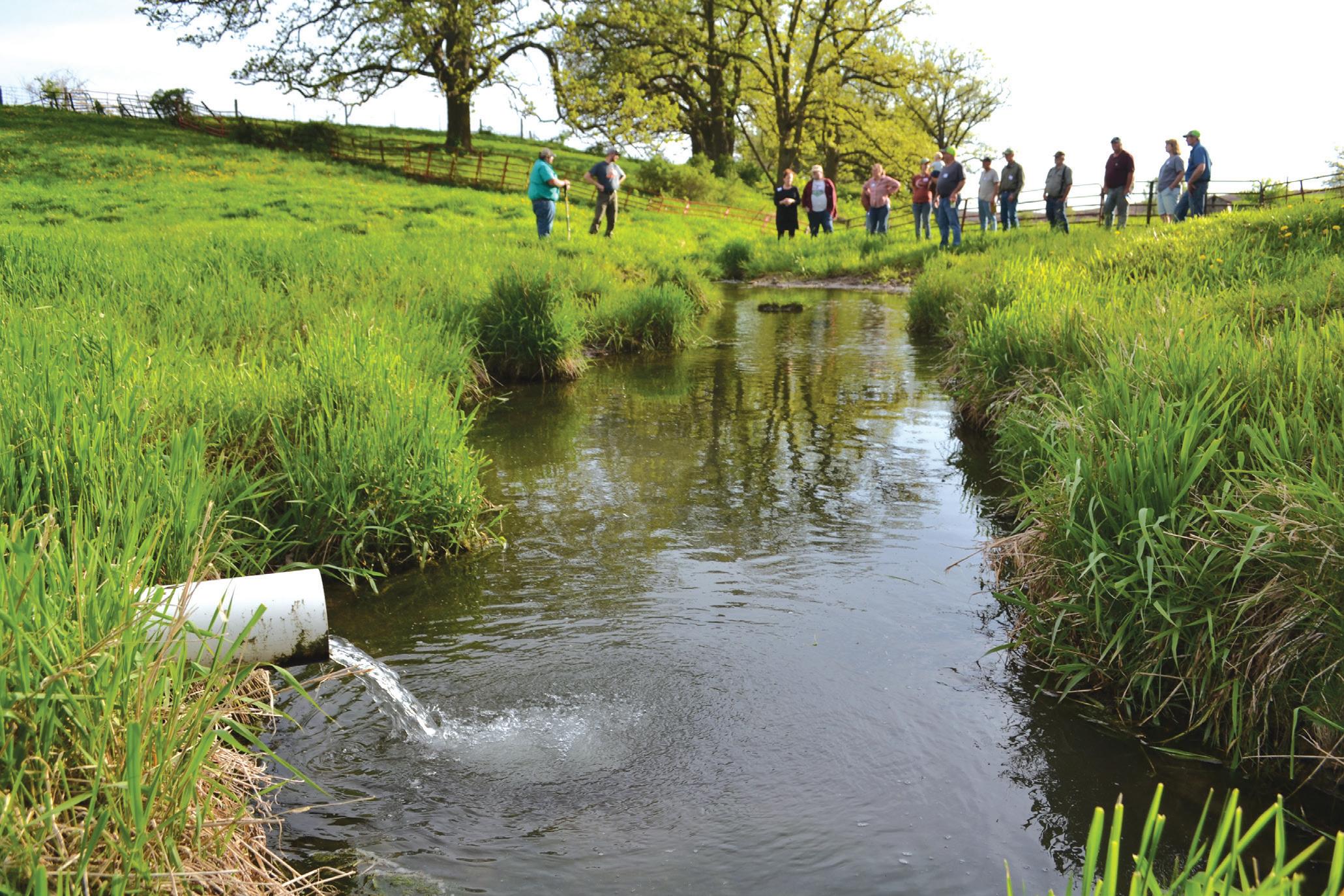
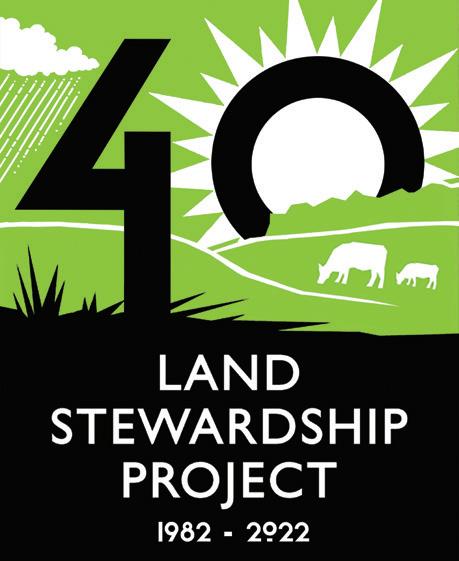



The Land Stewardship Letter is published by the Land Stewardship Project, a private, nonprofit organiza tion. The Land Stewardship Project’s mission is to foster an ethic of stewardship for farmland, to promote sustainable agriculture, and to develop healthy communities. Members of the Land Stewardship Project receive this publication as a benefit. Annual membership dues are $35.
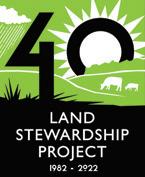
All inquiries pertaining to the Land Stewardship Letter should be addressed to the editor, Brian DeVore, 4917 Nokomis Avenue South, Minneapolis, MN 55417; phone: 612-816-9342; e-mail: bdevore@landstewardshipproject.org.

Deborah Allan, Laurie Driessen, Laura Frerichs, Jon Jovaag, Jody Lenz, Dan McGrath, Les Macare, Sara Morrison, Darrel Mosel, Beth Slocum, Kristin Tombers, Paula Williams
Southeastern Minnesota 180 E. Main St., P.O. Box 130, Lewiston, MN 55952; phone: 507-523-3366; fax: 2729; e-mail: slangseth@landstewardshipproject.org Annelie Livingston-Anderson, Maura Curry, Barb Sogn-Frank, Shona Langseth, Alex Romano, Karen Stettler
Western Minnesota
117 South 1st Street, Montevideo, MN 56265; phone: 320-269-2105; fax: 2190; e-mail: rmoore@landstewardshipproject.org
Amy Bacigalupo, Scott DeMuth, Pilar Ingram, Robin Moore, Nick Olson
Twin Cities
821 East 35th St., Suite 200 Minneapolis, MN 55407; phone: 612-722-6377; fax: 6474; e-mail: info@landstewardshipproject.org
Olivia Blanchflower, Sean Carroll, Brian DeVore, Natalia Espina, Sarah Goldman, Josh Journey-Heinz, Amanda Koehler, Elizabeth Makarewicz, Mike McMahon, Emily Minge, Heidi Nybroten, Timothy Kenney, Clara Sanders, Matthew Sheets, Megan Smith, Charles Spencer
• Commodity Ag & Rural Economies
• Planks of the 2023 Farm Bill Platform
• Minnesota Food & Farm Campaign
• Ag Census: Stand Up & be Counted
• LSP’s Long Range Plan
• Deep Canvassing’s Deep Impact
• Connect with LSAF
• Applications Being Accepted for 2023-2024 Class
• Seeking Farmers-Seeking Land Clearinghouse
• Farm Beginnings Profile: In the Middle of Somewhere
• Are You Dreaming of Farming?
• Farm Beginnings Profile: Solar Powered Land Access
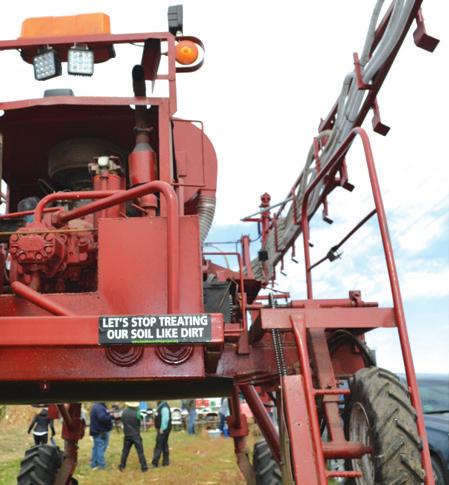
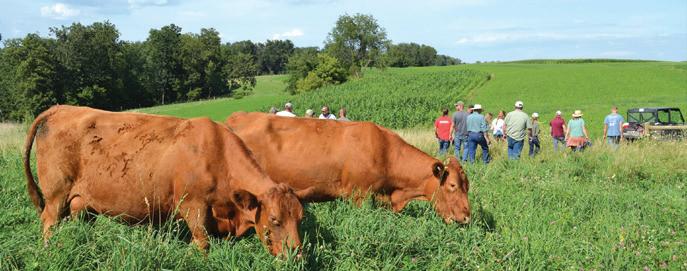
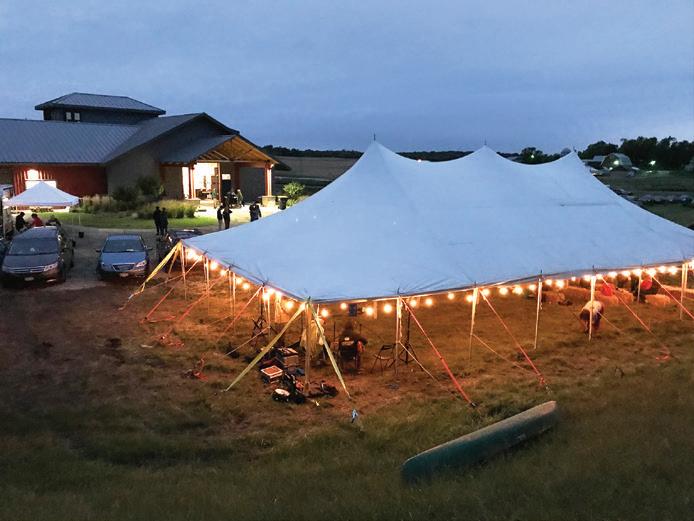
• Digging Deep: A Season of Knowledge Transfer
• Soil Building by the Numbers
• Join the Soil Builders’ Network
• Braiding Sweetgrass
• The Seed Keeper
• Robin Wall Kimmerer to Speak at LSP 40th Event in January
• LSPers Demand Fish Kill Answers
• New LSP Board Members
• LSP Staff Update
• Need an LSP Speaker?
• 40th Anniversary Events
• CSA Farmers: Time to Sign-up
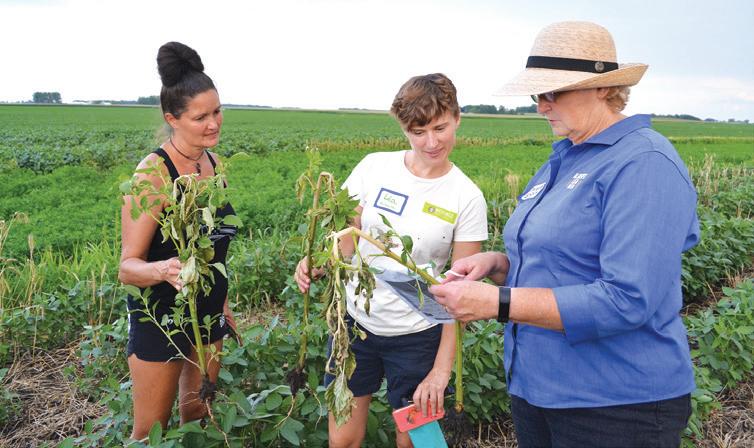
• Get Current with LIVE-WIRE
• LSP Fact Sheet Series
Throughout its 40-year history, the Land Stewardship Project has utilized storytelling and the hu manities to support stewardship of the land and convey the message of the importance of “keeping the land and people together.”
In fact, LSP’s co-founders, Ron Kroese and the late Victor Ray, were partially inspired to start this organization as a result of their work in the 1970s with the American Farm Project, a leadership development program funded by the National Endowment for the Humanities and coordinated by the National Farmers Union. This initiative involved, among other things, exposing farmers from around the country to the “culture” of agri culture, including literature and history. So it’s fitting that through books such as
1. When I get old I’ll leave this place
When I get old I’ll leave this place
When I get old I’ll leave this place
Pass it on to a younger face
I’m gonna leave this land a little better
For the next who comes along.
2. I rarely turn the soil these days
I rarely turn the soil these days
I rarely turn the soil these days
I’ve been trying out different ways
I’m gonna leave this land a little better
For the next who comes along.
3. I ran out to watch a storm last spring
Ran out to watch a storm last spring
Ran out to watch a storm last spring
I saw a three-inch rain soak in
I’m gonna leave this land a little better
For the next who comes along.
4. You smell that ground, you know it’s right
You smell that ground, you know it’s right
You smell that ground, you know it’s right
Someone’s future’s looking bright
I’m gonna leave this land a little better
For the next who comes along.
Soil and Survival (1986, by Joe Paddock, Nancy Paddock, and Carol Bly), The Farm as Natural Habitat: Reconnecting Food Sys tems with Ecosystems (2002, edited by Dana Jackson and Laura Jackson), and Wildly Suc cessful Farming: Sustainability and the New Agricultural Land Ethic (2018, by Brian DeVore), LSP has told the stories of farmers who are stewarding the land and used these stories to inspire public support for this type of agriculture.
We’ve also used plays and the power of drama. In the case of Planting in the Dust (1984, by Nancy Paddock), the issue was stewardship of our soil. Look Who’s Knock in’ (2011, by Doug Nopar), helped launch community conversations about transition ing farmland to the next generation.
Music can also be an effective medium for taking us from education to action, and longtime member Bret Hesla has played a key role in LSP’s musical endeavors. A musician and songwriter, Hesla in 1989 cre ated “Music of the Land,” a sing-along and slideshow where audiences got involved in singing the praises (literally) of stewardship.
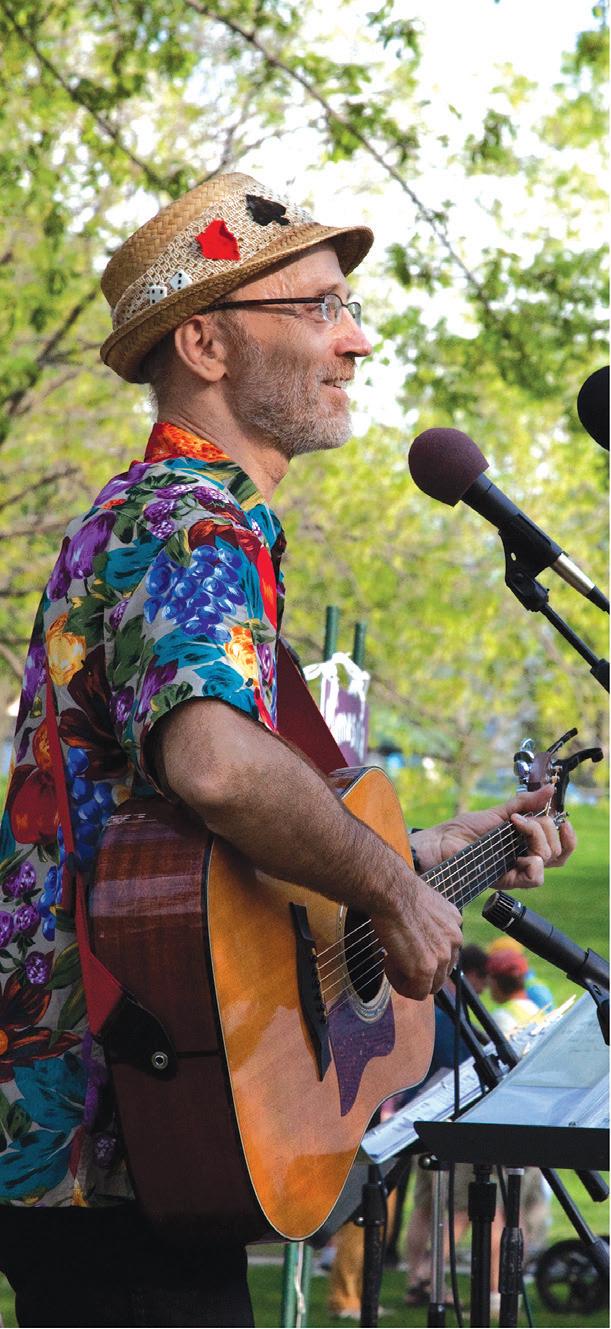
In 2020, he was inspired by LSP’s soil health work to write and record a set of songs that honor our relationship with the ground beneath our feet and the importance of stewarding it via regenerative systems. Out of this came the “Songs for the Soil” series. See landstewardshipproject.org/ songs-for-the-soil to listen to Hesla and the band Six Feet Deep as they perform four of these songs: “A Little Better,” “Dead Dirt’s Coming Back,” “The Boundless Earth,” and “Six Feet Deep.” Also, check out the two songs from this effort — “Got Cover Crops” and “Back to Soil” — that were released as music videos.
Below are the lyrics of “A Little Better.” If you’re interested in using any of these songs for an event or other purposes, contact Hesla via his website: brethesla.com. p
5. They drank from this crick when Dad was young
They drank from this crick when Dad was young They drank from this crick when Dad was young My grandchildren will again
I’m gonna leave this land a little better
For the next who comes along.
Words and music by Bret Hesla; written on commission for the Land Stewardship Project
© 2020 Bret Hesla. All rights reserved. Use only with permission of Bret Hesla. Contact: bret.hesla@ gmail.com; brethesla.com.
Words & music by Bret Hesla
Recorded by Bret Hesla & Six Feet Deep
Bret Hesla — lead vocals, rhythm guitar
Dan Chouinard — piano
Dave Michel — bass, vocals
Steve Kimball — percussion
Tim Gustafson — lead guitar, group vocals
Rebekah Fergus — harmony vocals
Robin Nelson – group vocals
Betty Tisel — group vocals
Jane Dunlap — group vocals
Brooks Cavin — group vocals
Larry Dittberner — group vocals
Recording Engineer — Dave Michel
Recorded at Orchard House, Minneapolis, Minn.
When a form of production domi nates a region geo graphically, it should be safe to assume that it’s also king of the local economy. But when it comes to all those millions of acres of corn, soybeans, and other commodity crops growing in rural communities, the dollars generated are passing through like a speeding freight train — and it’s a one-way trip. That means the people who raise those crops are left to seek other forms of income to survive.
This fall, a University of MissouriCoBank study showed that a whopping 82% of farm household income comes from off-farm sources. In the 1970s, farmers were reliant on around 40% to 50% of their household income from off the farm. Well over half of principle operators have a main job off the farm; in 1974, 37% worked off the land. And over 60% of farm-dependent county residents commute outside their counties to work, up more than 10 percent age points from two decades ago, according to the study.
A big reason so many farm families are working off the farm is that such jobs often provide healthcare insurance as a benefit, which is increasingly important at a time of skyrocketing medical costs. But it’s also clear that farming is simply not providing the financial security most households require. That’s surprising, given the billions of dol lars in economic activity the commodity system of agriculture churns out annually. But, as food systems analyst Ken Meter makes clear, most of that money is leaving our rural communities via an extremely extractive process.
As he points out in his book, Building Community Food Webs, today farmers earn one penny from each dollar’s worth of food they sell — a 98% decline since 1910. By 2018, the net cash income from crops and livestock fell to $4 billion, which is lower than Great Depression-era levels and only 1% of sales, according to Meter. Much of that money is being siphoned off in the form of interest payments. As it becomes increasingly expensive to raise a crop — it’s estimated the 2022 corn crop was the most expensive one in history and that 2023 will
top that — farmers are increasingly reliant on huge amounts of credit to buy machinery, land, and chemical inputs. Farmers borrow ing money has long been part of agriculture, but traditionally producers worked with local banks and even fellow farmers to procure those loans. Those lenders would use the interest earned off the loans to invest in the local community.
But increasingly, more of that debt is being controlled by corporations with headquarters in distant cities, states, or even countries. Those interest payments leave the community, and don’t come back. And consider the fact that virtually no inputs — pesticides, fertil izers, or fossil fuels — are produced locally these days. That became painfully clear in 2022 as the war in Ukraine disrupted world natural gas supplies, resulting in record high input prices down on the farm. Meter’s num ber crunching shows that when one considers losses in terms of interest payments, combined with money shelled out for pesticides, fertil izers, and fossil fuels, “at a minimum” $4 trillion (in 2018 dollars) has left the U.S. farm sector since 1910 (that’s 13% of cash receipts). He says that’s a conservative estimate, given that it doesn’t include the costs of equipment, building materials, or seeds, which are almost all being shipped in from elsewhere.
Even what’s considered “farm income” is often not tied directly to selling the fruits of the land onto the open market. Through such pro grams as crop insurance and other subsidies, an increasingly larger proportion of cash input is via government programs. In 2019, govern ment payments made up one-fifth of all farm income, which means decisions about how much money is given to whom are increas ingly being made outside rural communities.
Take a drive through most farm towns and one will see the result of this extraction of wealth: shuttered Main Street businesses, along with closed schools and churches. Rural America is faced with the cruel irony of see ing its commodity production explode, while its economic vitality, and population, fizzle. An added insult is that many farm towns are surrounded by endless acres of fertile soil, but are food deserts where the only place one can procure even a loaf of bread or a gallon of milk is the local gas station. Meanwhile, 11% of rural households in 2021 were “food insecure,”
meaning that they lacked “consistent access to enough food for an active, healthy life,” according to the USDA.
Make no mistake, there is a lot of money involved in agriculture these days — it’s just not going to the farmers and the com munities they live in. Take, for example, the record prices being paid for farmland. Wide income disparity gaps — the gap between the richest and the poorest residents — have long been more closely associated with metropolitan areas—think New York’s Park Avenue and Harlem’s slums, for example. But an analysis by Bloomberg News found that booming prices for farmland have helped make wide income disparities com monplace in rural areas as well.
Families that sell out to the highest bid der or rent to a farmer are often not living in the community anymore, meaning their wealth isn’t staying local. In addition, when a farm is sold, it’s more than likely bought to add acres to a larger operation, not to serve as a basis for a new start-up.
Iowa historically had low levels of inequality, “but now it is skyrocketing,” Iowa State University sociologist David Peters told Bloomberg. “Today you have far fewer farmers and a small number earn ing larger and larger incomes. It doesn’t spread through the economy like it used to,” he added.
The system that bleeds rural communi ties dry has many roots, including federal policies that were set up to provide multina tional corporations a steady source of cheap commodities that can be exported and fed to livestock in industrialized concentrated animal feeding operations. Reforming farm policy so that it stops favoring an increas ingly consolidated system that treats farm ing communities as places to be strip-mined of their resources is one way to end this extractive system. Another approach is to create community-based food initiatives that emphasize localized, homegrown systems. In such a system, grain, livestock, produce, and dairy products are processed and marketed in the community or region, providing sustenance, and income, for local folks first. Any surplus could be sold outside
Myth Buster, see
➔ Fact:
the region, with the income from those sales staying in the community. Commodity crops like corn and soybeans would still have a place in such a system, but their role in con trolling all aspects of the economy — from who is loaned money and allowed to buy land to what kind of storage and transpor tation infrastructure is present — would be greatly diminished.
In a community-based food system, businesses start to see agriculture as a key driver of the economic and civic life in the community, and not just a way cash mo tors down the road. This can help drive the development of local lending, processing, and other ancillary businesses.
This isn’t a pipe dream. Meter has writ
ten extensively about communities who have taken such an approach. No one has it com pletely figured out, but the potential is huge. Meter once did a study in a sparsely populated community in North Dakota that showed that if everybody in that region bought $5 worth of food weekly from a local farm, the overall economic value of those purchases would be greater than all the money generated by all those commodity crops grown on thousands of acres in the area.
That’s why the Land Stewardship Project has been conducting listening sessions in rural communities to find out what a different ap proach to our food system could, and should, look like. Farmers, small business owners, and local government officials are turning out for these meetings and acknowledging that the current system is simply not working. That’s
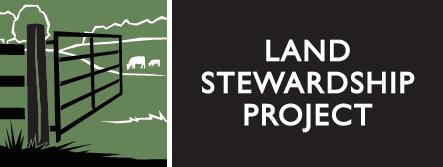
InSeptember, members of the Land Stewardship Project delivered a letter to Minnesota Governor Tim Walz’s office calling on state officials to take action to address a rash of fish kills in the south eastern part of the state in recent years. “As people who drink, cook, and wash with this water when it comes out of our taps, and who fish these streams as well as use this water to irrigate our crops and water our livestock, we see a troubling pattern emerg ing,” stated the letter, which was signed by 135 members and allies of LSP, all of whom live in Winona County. “We want this troubling pattern of aquatic destruction to stop,” they added.
In late July on Up per Rush Creek south of Lewiston, at least 2,500 fish, mostly brown trout, were found dead in an incident Minnesota Pol lution Control Agency (MPCA) officials said did not occur “naturally.”
a good start: after all, the first step toward long term change is acknowledging the cur rent system is broken…and isn’t inevitable.
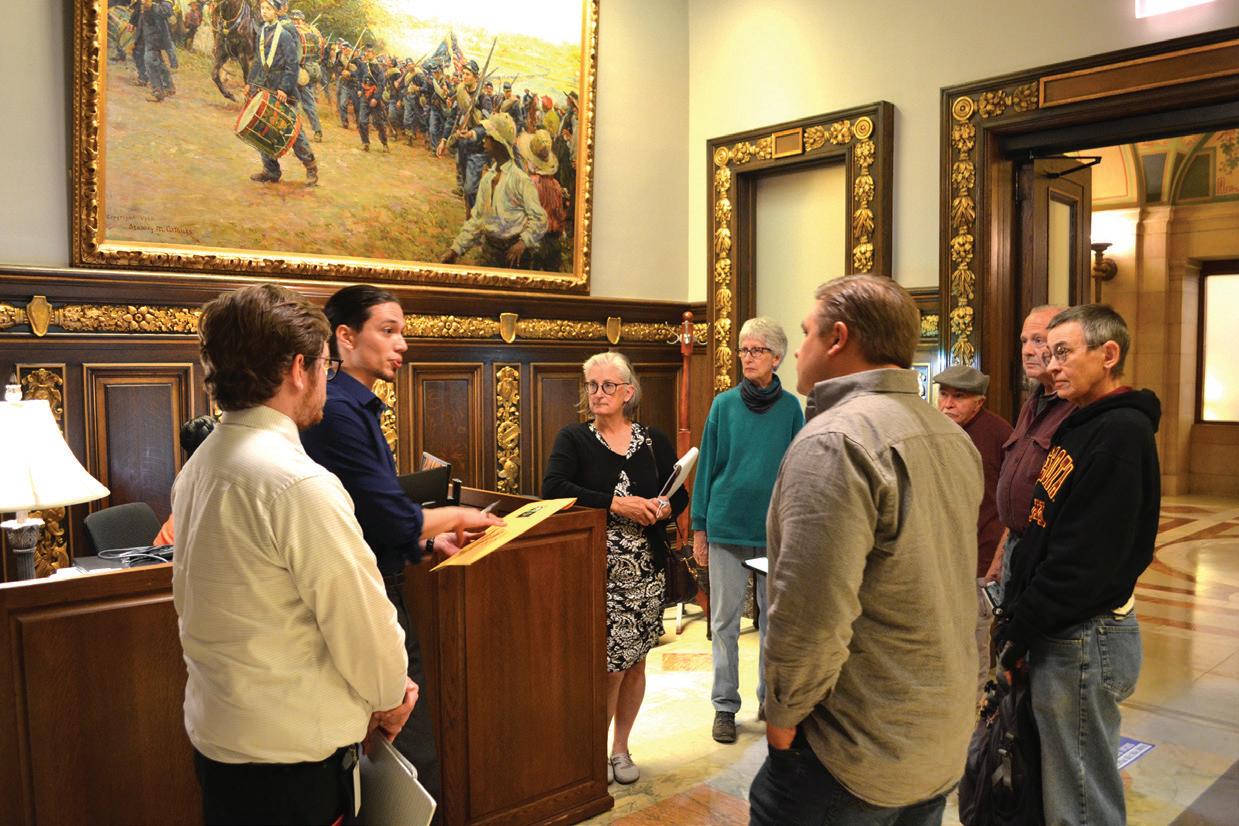
• For more on LSP’s community-based food work and Ken Meter’s research, see pages 12-14.
• The CoBank-University of Missouri Study, “The Importance of Off-Farm In come to the Agricultural Economy,” is at cobank.com.
Tired of accepting “conventional wis dom” as gospel? Check out LSP’s Myth Buster series on a variety of topics at landstewardshipproject.org/myth-busters.
the site of yet another fish disaster that was estimated to have killed thousands. Fish kills can result from numerous manmade sources, including pesticide and manure runoff, but thus far state agencies such as the MPCA have been unable to provide information on the source of the Winona County incidents.
This is the latest in a series of fish kills in the region in recent years. In 2019, 1,500 fish were reported killed in Garvin Brook, just east of Lewiston. In 2021, 250 trout were found dead in Trout Valley Creek, just south of Weaver. And in 2015, one of the most productive trout streams in the state — the South Fork of the Whitewater River that passes to the west of Lewiston — was
“Our water is a shared resource that does not fall under the control of one person or entity, and the health of the water that sustains us and the health of our commu nities are inextricably linked,” stated the letter, adding that, “We want to do our part to protect our shared water resources. But in order to do that effectively, we need to know the source of these fish kills so that we can address the issue.”
The citizens called for a thorough investi gation into the source of the kills and asked that the Governor meet with them to discuss the issue.
LSP member Barb Nelson, who lives near Lewiston, says as the person who is responsible for appointing the commissioners of the MPCA, Depart ment of Natural Resources and Depart ment of Agriculture, it is the Gover nor’s job to help her and her neighbors get to the bottom of who is responsible for these incidents and to prevent them from happening in the future.
“What I have learned in my 52 years on the banks of Garvin Brook is that not everyone has the same respect for the environment as we do,” says Nelson. “We expect results on the fish kills this time. Who are the violators?”
To read the letter, see bit.ly/LSP WalzLetter. p
merous LSP steering committees, cohorts, and campaigns. She serves on the board of the Land Stewardship Action Fund, LSP’s political leadership development partner (see page 11). Slocum is currently serving as the chair of LSP’s board. p
Macare is the co-owner of Racing Heart Farm, a Community Supported Agriculture (CSA) vegetable operation near Colfax,
Wis. Macare is a graduate of LSP’s Jour neyperson Course and recently participated in the organization’s Climate Resiliency Cohort. Macare, along with partner Els Dobrick, who is also a Journeyperson gradu ate, found their land via LSP’s Farmland Clearinghouse (see page 15).
Morrison is a graduate of LSP’s Farm Beginnings (see page 15) and Journeyper son courses, and participated in the orga nization’s Racial Justice Cohort. She is the general manager of the River Market Com munity Co-op in Stillwater, Minn.
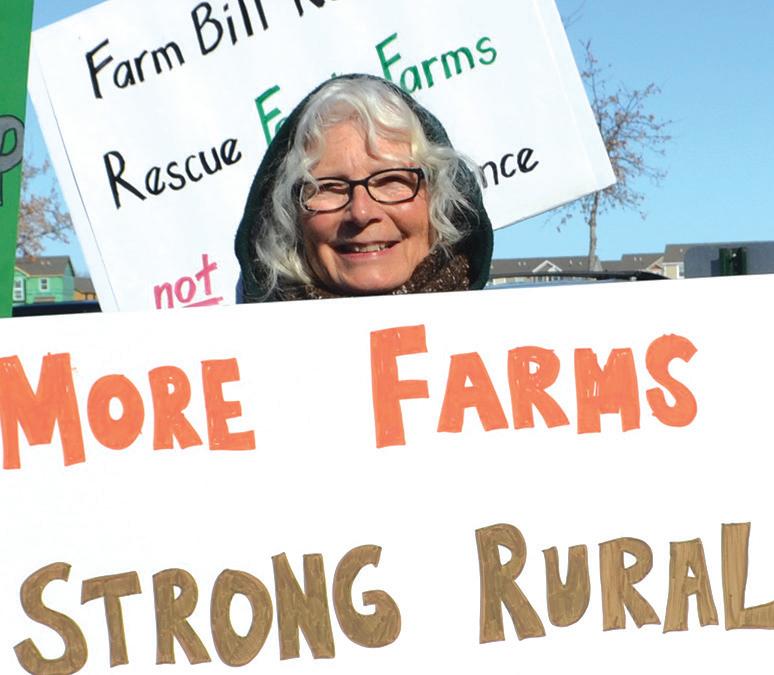
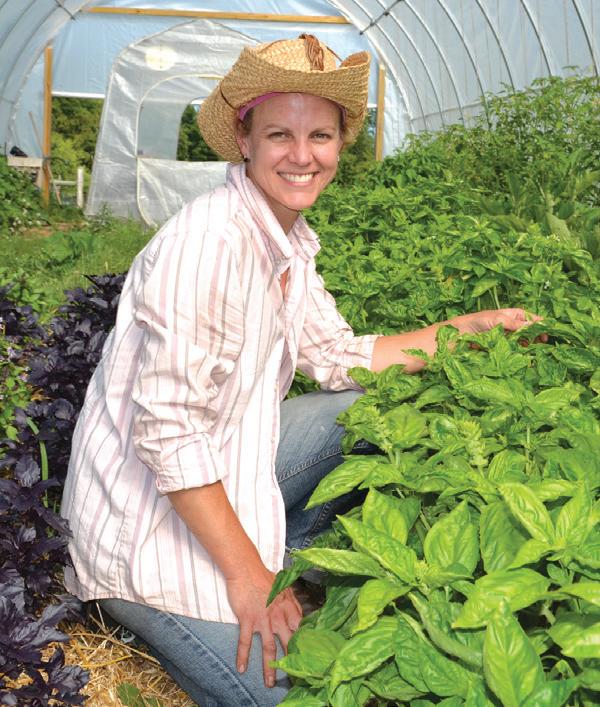
Lenz co-owns Threshing Table Farm, a CSA vegetable operation near Star Prairie,
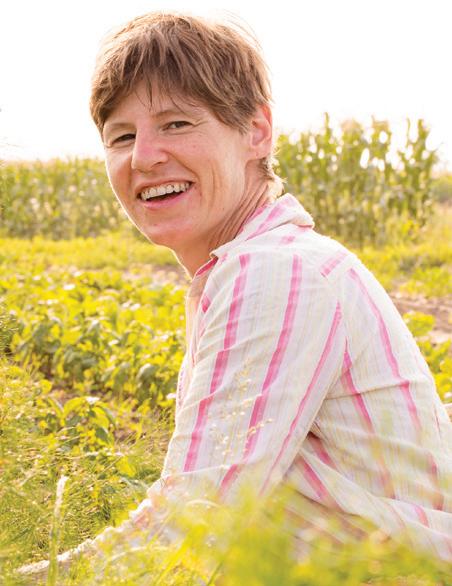
Wis. Lenz, who is also a Farm Beginnings graduate, has been active in various LSP committees related to policy and farm resiliency. She previously served on the LSP board, including a stint as chair.
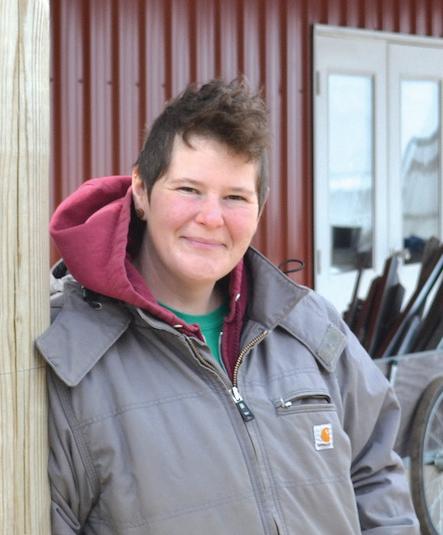
Slocum raises sheep near Welch, Minn., and over the years has participated in nu
Ryan Perez has left the Land Stew ardship Project’s Advancement Team to work as the political campaign manager for COPAL, an organization working pri marily with Minnesota Latino communities on public policy, leadership, and community service.
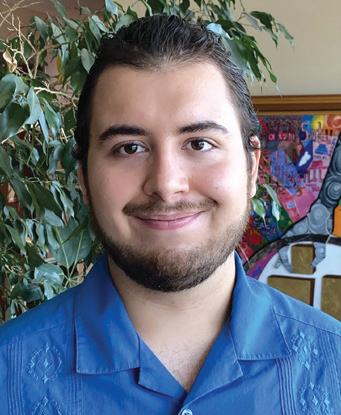
Since joining LSP’s staff in 2021, Perez has worked as the organization’s data specialist. In that ca pacity, he undertook major improvements to the management of LSP’s data base. In late 2021, Perez facilitated the transfer of LSP’s membership data to a new system, conducting a major overhaul of how the information is managed in the process. This initiative greatly im proved the organization’s ability to serve its membership and utilize its base to organize around key issues. p
Would others in your community or a group you’re a part of be interested in learning about the Land Stewardship Project’s work?
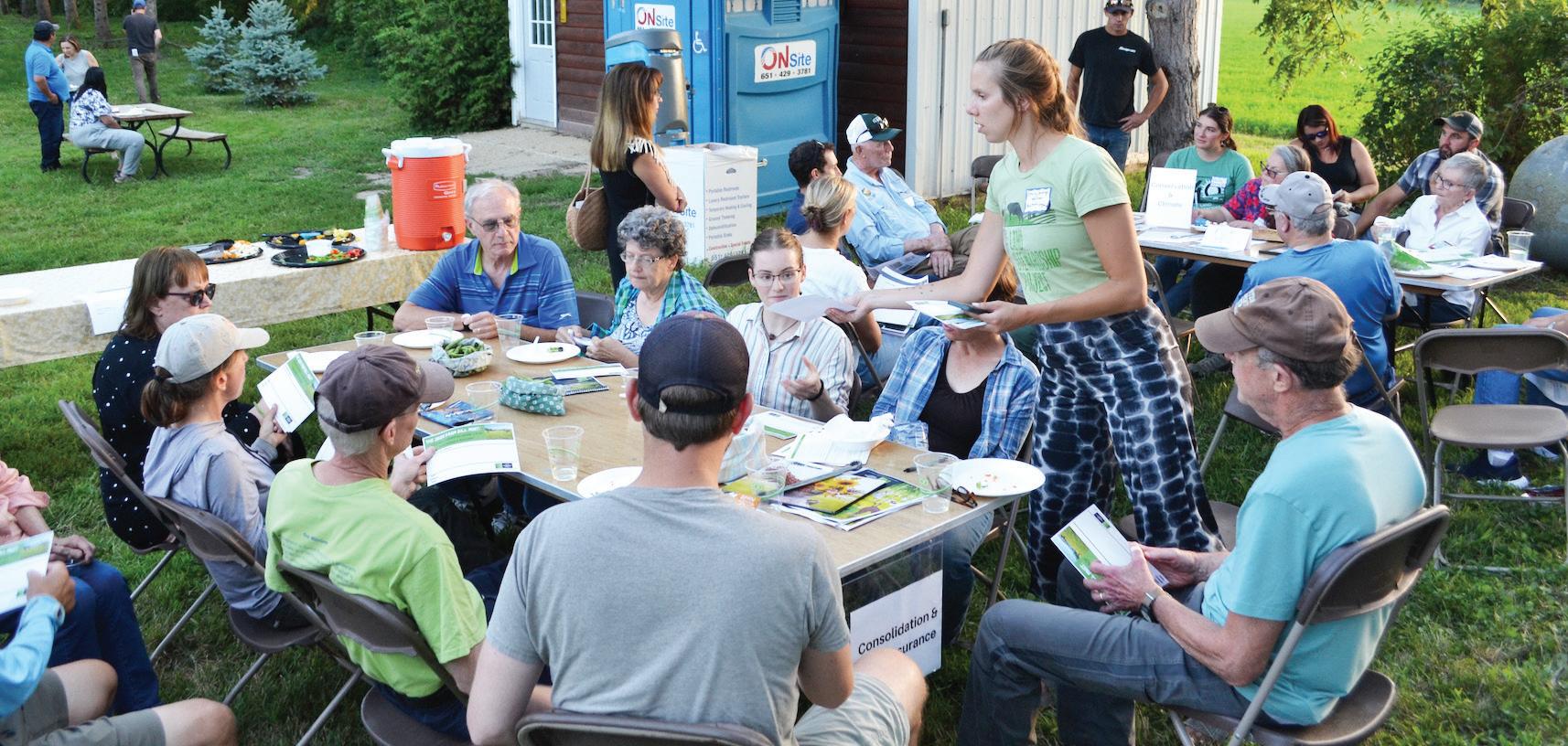
Staff members are available to speak about our various initia tives. Contact us at info@landstewardshipproject.org to learn more and to get something set up.
For details on other ways to connect with LSP, see landstewardshipproject.org/connect-with-lsp.

Members of the Land Stewardship Project have been celebrat ing the organization’s 40th birthday in earnest throughout the spring, summer, and fall. Bonfires, a square dance, and lots of good food, music, and conversations were featured at these events (see photos).
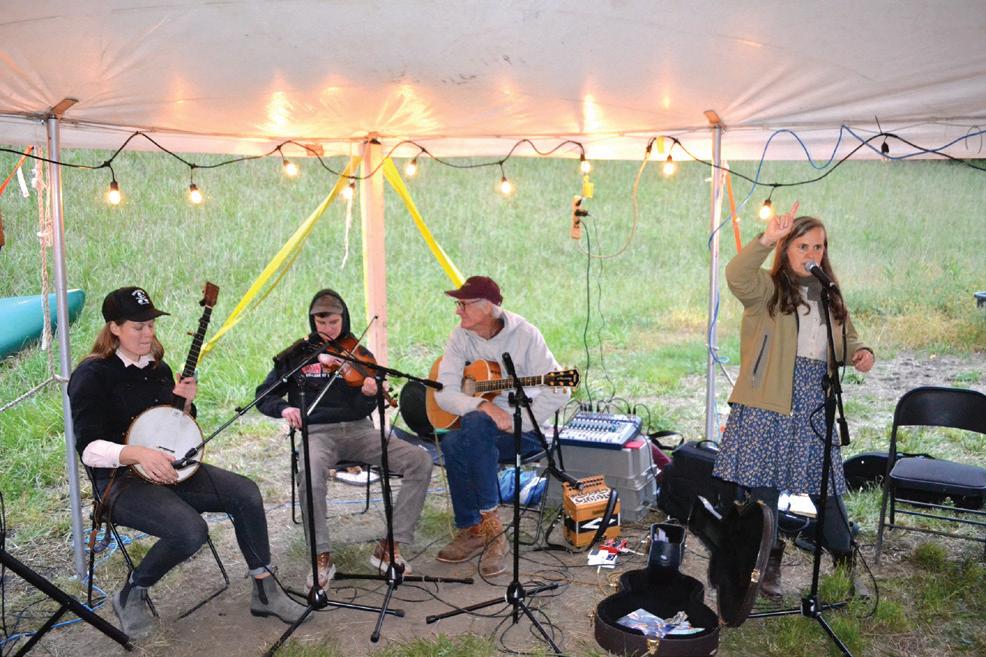
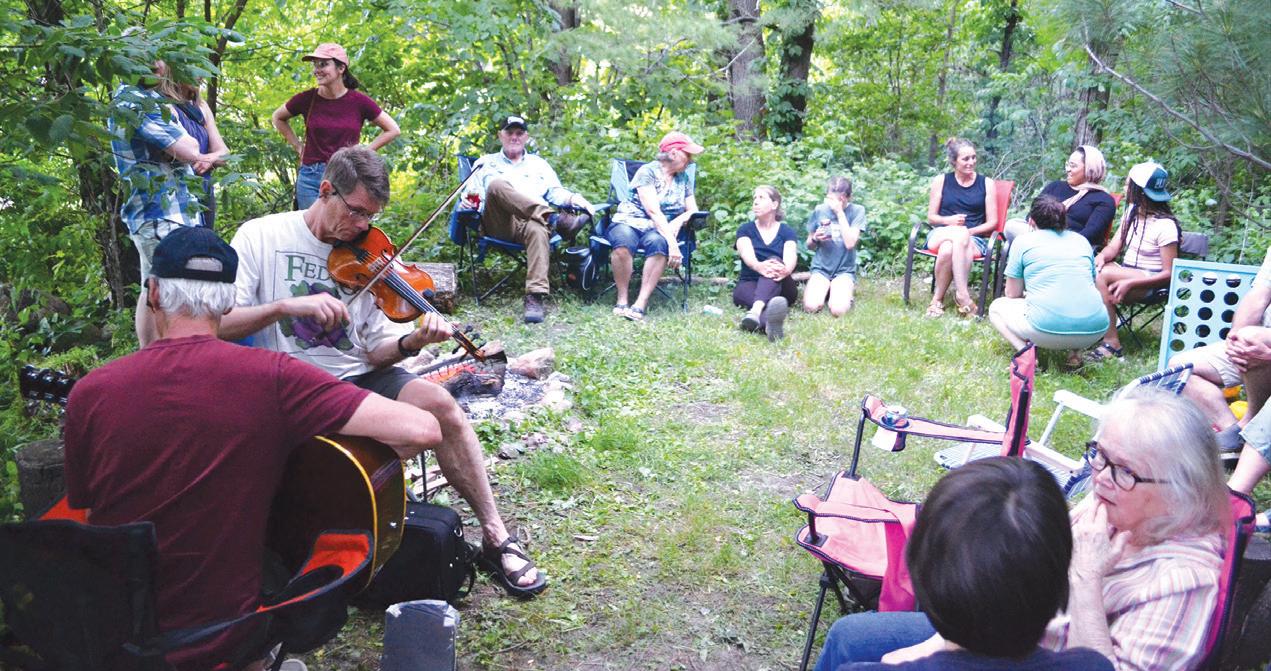
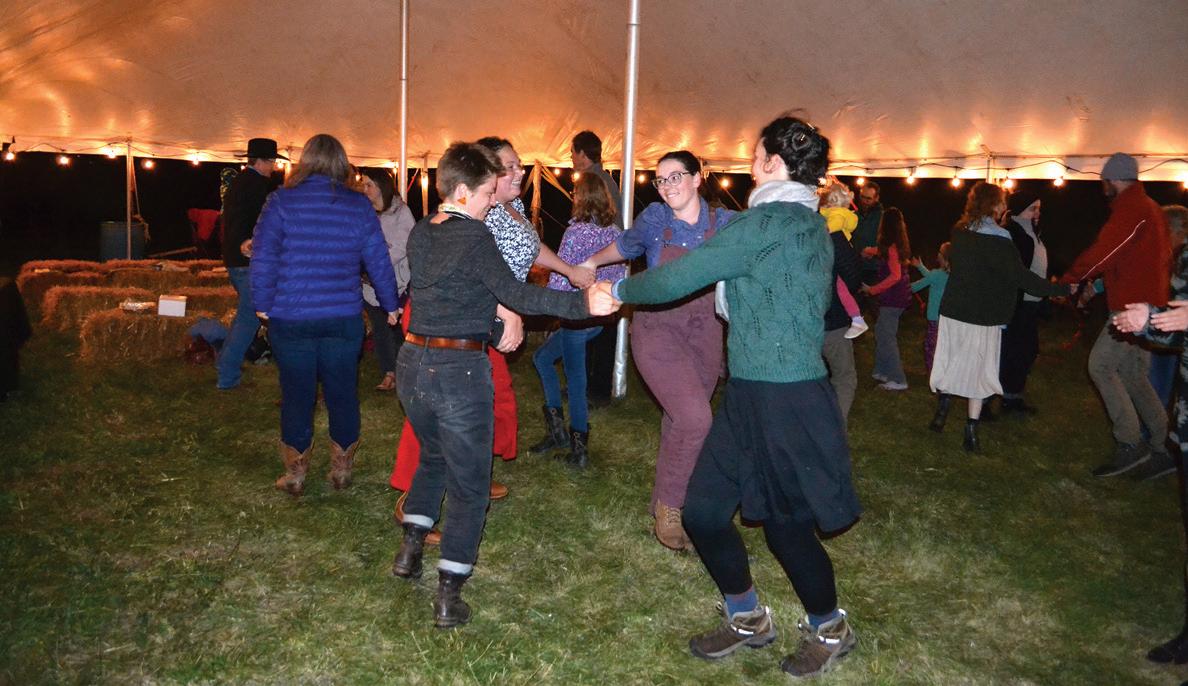
By the way, see page 34 for a report on another 40th Anniversary event we held this year: the LSP Picnic and Block Party. And you can check out a quick LSP history timeline at landstewardshipproject. org/40th-anniversary-events.
And we aren’t through yet. In January, author Robin Wall Kim merer will help the Land Stewardship Project wind up its 40th birthday with an evening that celebrates our relationships with the land and with each other. It will feature live music and a virtual live address by Kimmerer. See page 32 for details on this exciting event. p
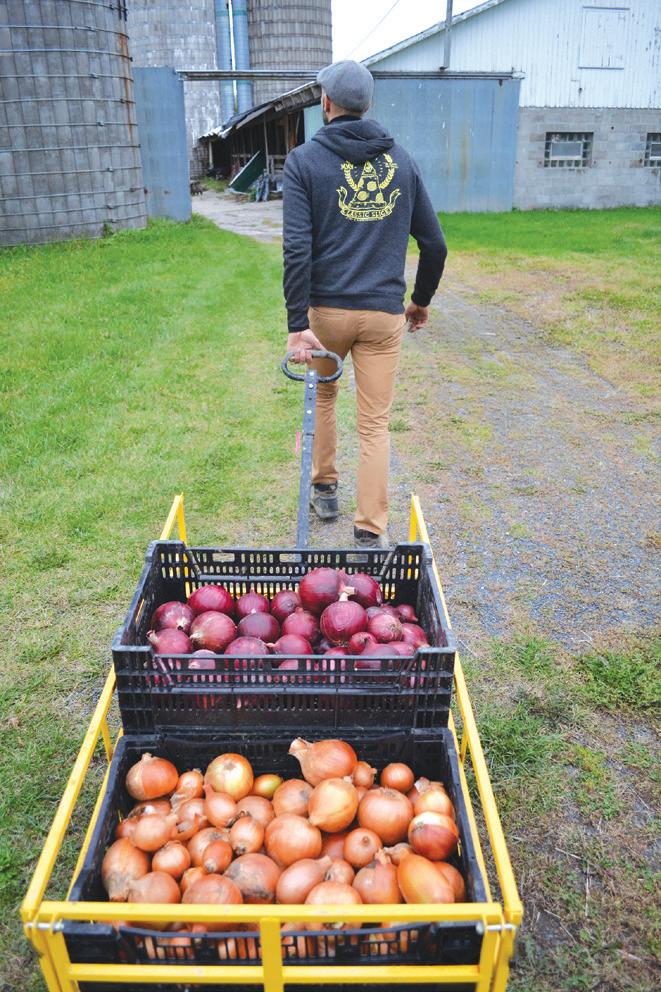
If you are a Community Supported Agriculture (CSA) farmer operating in Minnesota or western Wisconsin, the Land Stewardship Project invites you to be listed in the 2023 edition of LSP’s Twin Cities, Minnesota & Western Wisconsin Region CSA Farm Directory. An online version of the CSA Farm Directory will be available in February at landstewardshipproject.org/ csa-farm-directory. On that web page, you will find an online form for submitting in formation about your farm.
The deadline for submitting listings is Friday, Jan. 20. The listing fee is $15 for LSP members and $20 for non-members. There is a 250-word limit for listings. For details on having your farm listed, contact LSP’s Brian DeVore at bdevore@ landstewardshipproject.org or 612-8169342.
Sign up for the LIVE-WIRE e-letter to get monthly updates from the Land Stewardship Project sent straight to your inbox. Details are at landstewardshipproject. org/live-wire-sign-up. p

The Land Stewardship Project has available a series of well-researched fact sheets on everything from regenera tive agriculture’s relationship to a resilient environment to ways people are working together to improve their communities. Check out this growing list of fact sheets and download pdf copies at landsteward shipproject.org/fact-sheets.
In addition, installments in LSP’s popular “Myth Buster” series (see page 4) are avail able for downloading at landstewardshippro ject.org/myth-busters. p
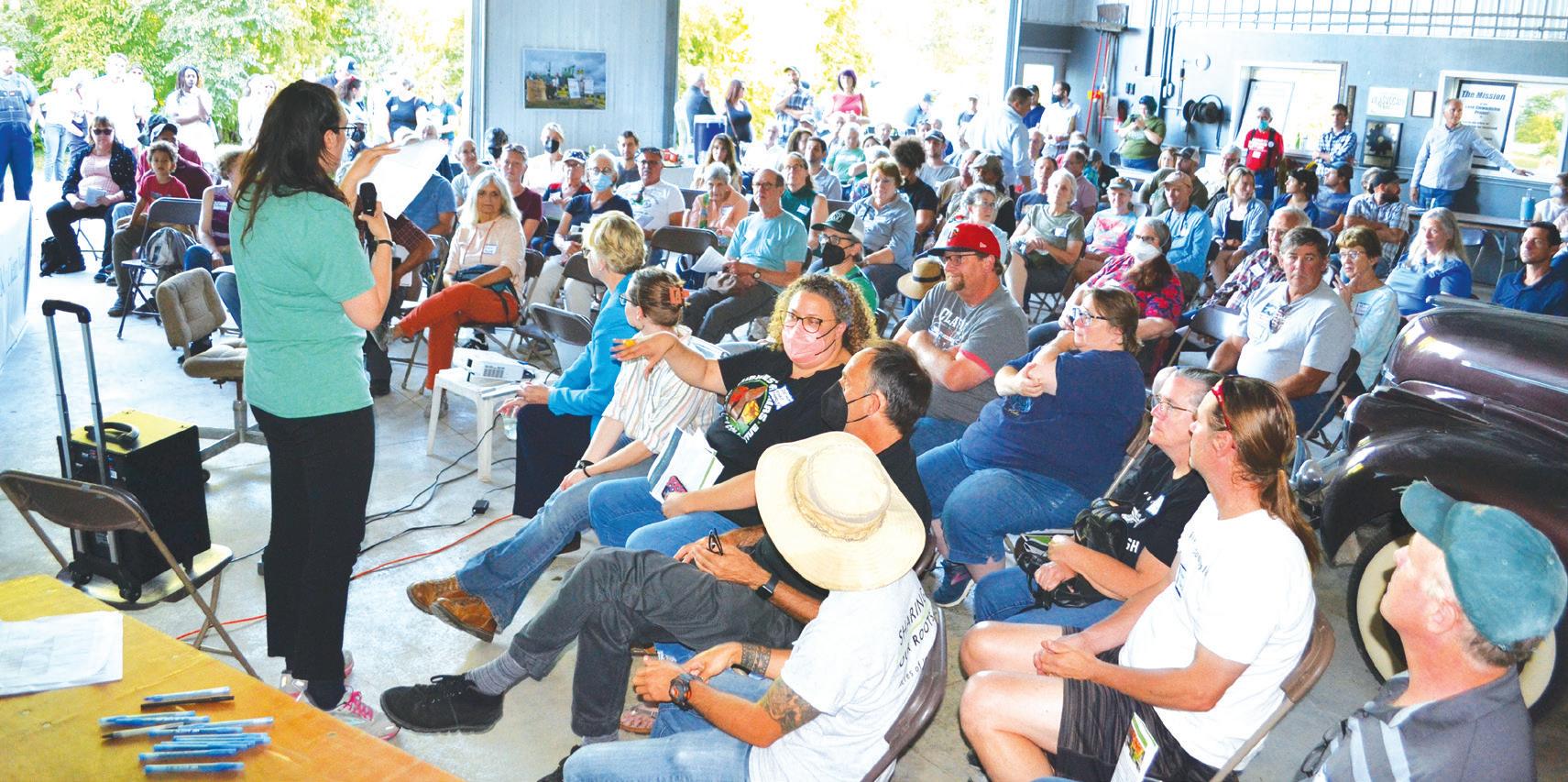
It Addresses Consolidation, Conservation, Insurance, Emerging Farmers, Food
ties are heard and our ideas enacted.
By Sarah GoldmanIt’ssometimes hard not to feel the weight of the behemoth-sized chal lenges we bear. During the summers of 2021 and 2022, much of Minnesota suffered from drought on the tail of seasons of extreme flooding and un predictable weather (the telltale signs of climate change). Land and input prices continue to soar, the average age of farmers in Minnesota remains high, and the obstacles placed in front of beginning farmers are heavy. And this does not even touch on the challenges that other food system stakeholders are feeling, from farm and processing workers and small businesses on Main Streets across the region, to consumers feeling the pinch of a food system that is corporate controlled all the way to the grocery store aisle.
However, over the past eight months, Land Stewardship Project staff have listened to farmers across the state talk about what they want to see in federal farm policy. The mes sage we’re hearing is not pessimistic or defeatist. We have heard a clear call to action — our farmers are calling for bold changes, for a new and different vision, and for collective action to meet these rising challenges head-on.
This is a key time to advance our vision given that Congress is currently drafting a new Farm Bill, which determines how tens of billions of dollars are spent on what’s grown on the landscape and who grows it, as well as the environmen tal impact of produc tion systems, the safety of our food, and the economic health of rural communities.
As we consider our members’ Farm Bill priorities, we need to take stock of other legislation that could impact the law’s final
baseline funding, meaning that the Farm Bill has more resources to allocate to innovate farm programs. That’s good news, given that our members have made it clear that conser vation funding is one of their priorities.
Farm Bill programs touch almost every aspect of our food system, and earlier this year LSP’s Farm Bill Organizing Commit tee heard many experiences, perspectives, and ideas that are the basis of our federal agriculture policy advocacy.
To that end, the committee helped plan and execute eight Farm Bill listening ses sions on a range of topics, ranging from consolidation to crop insurance, as well as
This is a key time to advance our vision given that Congress is currently drafting a new Farm Bill.
Over the next 12 months, Congress will make strategic funding and policy deci sions that will dictate what makes up the 2023 Farm Bill. What’s become evident is that organized people power is our greatest strength and asset in making sure our priori
form. For example, in August the Inflation Reduction Act (IRA) was signed into law. This new law includes approximately $20 billion in programs that support producers working to improve conservation outcomes on their farms. It includes support for the Conservation Stewardship Program (CSP), the Environmental Quality Incentives Program (EQIP), the Agricultural Conserva tion Easement Program (ACEP), and the Regional Conser vation Partnership Program (RCPP). With the IRA’s pas sage, much working lands conservation program funding has been reauthorized ahead of the 2023 Farm Bill, meaning that if negotiations related to the law fall apart, conservation programs covered by the IRA will remain operational. In an optimistic scenario, this IRA funding could become
sessions for retiring farmers and emerging farmers. In addition, in the winter and spring of 2022, working with the National Young Farmers Coalition and Midwest Farm ers of Color Collective, LSP undertook a survey of farmers and food system workers in Minnesota, Wisconsin, and Iowa. This survey, officially a subset of data from the National Young Farmer Survey (youngfarm ers.org/22survey), focused on how agricul tural policy impacts issues such as industry consolidation and competition, access to markets and regional food systems, climate change and protection from weather disas ters, and access to government programs for BIPOC (Black, Indigenous, people of color) and beginning farmers. The survey results, along with information gathered during the listening sessions, are being used as the basis for LSP’s 2023 Farm Bill Platform.
The platform focuses on five key areas
Farm Bill, see page 9…
that should be addressed in the upcoming Farm Bill, including: consolidation; crop insurance; conservation and climate; young, beginning, and BIPOC farmers; and regional food systems. More information about the specific policy changes we are calling for is included in the executive summary in the sidebar on this page. You can check out the entire platform at landstewardshipproject. org/farmbill2023.
On August 16, over 140 LSP members and supporters gathered on Dave Legvold’s farm outside of Northfield, Minn., to hear from farmers and food systems leaders about the innovative work they are doing on farms and in their communities and the need for federal policy to support the type of prac tices and programs they are leading. During the event, LSP also released our Farm Bill Platform to the public.
Over the coming months, LSP will con tinue to host events and engage with farmers to learn more about their priorities for reform and opportunities to engage with the Farm Bill process. In addition, we will be hosting in-depth sessions on the five pillars of our Farm Bill Platform so that members are able to organize within their communi ties and call on their federal representatives to enact meaningful changes. To learn more about these sessions, contact me at sgoldman@landstewardshipproject.org, or see our federal policy web page at landstewardshipproject.org/federal-policy. p
Sarah Goldman organizes around federal policy issues for LSP.
In September, the Land Stewardship Project joined over 150 agricultural, environmental, and social justice organiza tions from across the country in penning a letter demanding that President Joe Biden take leadership on developing a transforma tive Farm Bill.
“The next Farm Bill should reflect your values and build on your administration’s actions to date to reduce economic inequal ity, bridge the nation’s racial divides, end hunger, confront the climate crisis, improve nutrition and food safety, and protect and support farmers, workers, and communi ties,” wrote the groups.
To read the entire letter, see bit.ly/ FarmBillTransformation. p
➔ Restore competition to the marketplace and level the playing field for small farmers and ranchers.
➔ Break up monopolies and enforce antitrust laws.
➔ Reduce funding supporting farms that are not taking care of their soil and communities.
➔ Create funding streams for new and innovative sustainable practices, and eliminate funding for practices that harm rural communities and the environment.
➔ Allocate fewer or no subsidies to the largest/industrial cropping operations, and stop providing public funds to large concentrated animal feeding operations (CAFOs) seeking to install manure management and methane digesters.
➔ Direct programs like the Conservation Stewardship Program (CSP) and Environmental Quality Incentives Program (EQIP) toward operations that are implementing regenerative practices like managed rotational grazing, agroforestry, and perennial crops, and ensure funding is accessible to farmers with small-scale conservation projects.
➔ Provide additional targeted outreach and education for conservation programs such as CSP and EQIP.
➔ Make CSP an easier program to use and apply for, especially for organic producers, and limit funding that goes toward factory farm-style production.
➔ Put payment caps on crop insurance subsidies that the largest industrial farms receive.
➔ Incentivize climate-resilient practices through crop insurance programs.
➔ Target crop insurance programs to support beginning farmers.
➔ Reduce crop insurance premium costs for farmers implementing soil health and conservation practices.
➔ Reduce the turnaround time for USDA Farm Service Agency (FSA) loan approval to meet the market pace for land sales and create a pre-approval mechanism for FSA Direct Farm Ownership Loans.
➔ Address concerns around realities that often the FSA loan process cannot compete with standard real estate transactions.
➔ Support programs that encourage and incentivize transitions to young/beginning/ BIPOC farmers. This includes programs that support farmland preservation and easements to reduce development of productive agricultural land and facilitate land access.
➔ Create pathways to support land transition, apprenticeships and mentorships, as well as legacy planning work.
➔ Provide additional and culturally-appropriate technical assistance services (including in multiple languages) so that beginning farmers can access USDA programs.
➔ Provide direct financial support for land ownership by creating grant initiatives such as direct assistance provided in the Minnesota Down Payment Assistance Program.
➔ Support incubator and cooperative farms through additional funding (including for personnel and operations) to increase access to tools, infrastructure, equipment, and training for young/beginning/BIPOC farmers.
➔ Facilitate market access through outreach, additional funding, and technical assistance programs.
➔ Allow for the development of infrastructure that connects producers to consumers and builds strong and resilient regional food systems.
➔ Increase funding and support for farmers’ markets, including programs that enable customers to purchase produce from local farmers.
➔ Protect critical investments in the Supplemental Nutrition Assistance Program (SNAP) and the Emergency Food Assistance Program (TEFAP) at a time of rising food prices and food insecurity.
State Policy:
Overthe past 40 years, Land Stewardship Project members have organized to win major policy changes, from establishing the Conserva tion Stewardship Program to stopping 40 proposed factory farms and factory farm expansions.
At the same time, members have made it clear that we urgently need holistic solutions that match the scale of the compounding challenges that our farmers, farm and food system workers, processors, marketers, and rural community members are facing.
That’s why Land Stewardship Project members have begun building a comprehensive “Minnesota Food and Farm Campaign” from the ground up that:
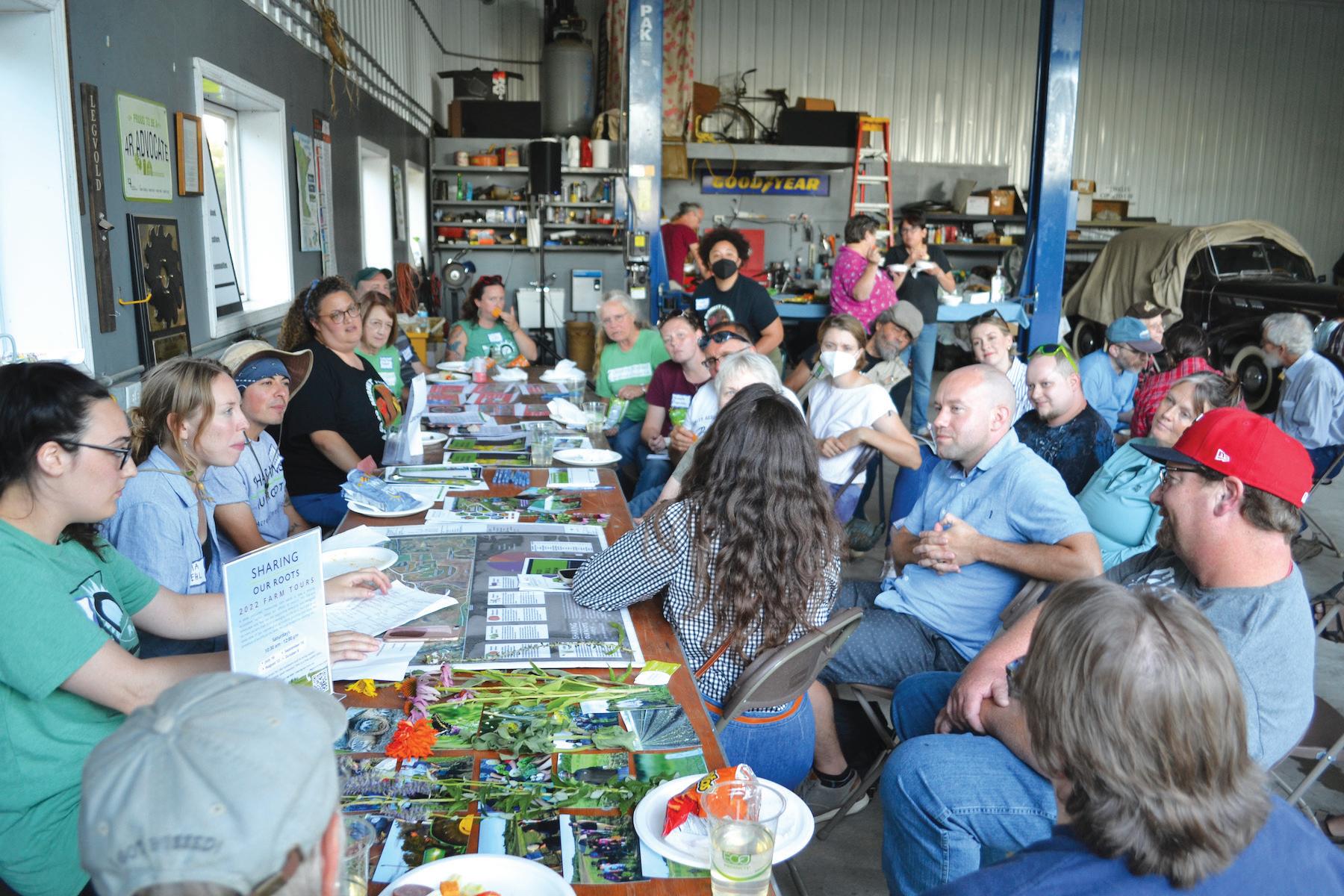
➔ Greatly increases access to land and secures land tenure for small and mid-sized farmers and people who want to start farming.
➔ Builds the infrastructure needed by small and mid-sized farms and by rural and urban communities to
fossil fuels and false climate solutions.
➔ Holds factory farms and megacropping operations accountable for polluting our water and air, exacerbating the climate crisis, and monopolizing land, water, and capital.
➔ Directly addresses the consolidation that drives small and mid-sized farms and related entities out of business.
➔ Protects and cares for farm and food system workers.
➔ Ensures all Minneso tans have the affordable healthcare they need when and where they need it.
➔ Makes our rural, urban, and suburban communities robust, vibrant, and thriving.
This fall, LSP con ducted a survey and held listening sessions to gather details on what our mem bers would like to see em phasized in the Minnesota Food and Farm Campaign. We will be using this input to determine what to focus on during the 2023 Min nesota legislative session and beyond.
create functioning local and regional food systems.
➔ Provides farmers with the resources they need to build resiliency from and fight climate change, while moving our society away from a reliance on
The latest U.S. Census of Agriculture was launched this fall, and farm operations of all sizes, urban and rural, are encouraged to participate. Any farm operations which produced and sold, or normally would have sold, $1,000 or more of agricultural product in 2022 are eligible to be included in the census.
Results from the census, which is taken every five years, are used to inform decisions about policy and how farm programs are designed and implemented. In the past, farmers using regenerative practices, women, and people of color have been underrepresented in the Census of Agriculture.
The census will be mailed in phases, starting with an invitation to respond online in November, followed by paper questionnaires in December. Details are at www.nass.usda. gov/agcensus.
For more information, contact me at 612-4006355 or akoehler @landstewardshipproject. org. For details on upcoming LSP meetings where the Minnesota Food and Farm Plat form will be discussed, see landstewardship project.org/upcoming-events. p
The Land Stewardship Project out lined its long range goals and how we will go about achieving them in Vision for the Future: 5 Year Plan 2019-2024. A pdf of the plan can be downloaded at landstewardshipproject.org/long-range-plan. For a paper copy, call LSP’s Twin Cities office at 612-722-6377. p
Earlyin the conversation, the man made it clear: having a widely available public option for cover ing healthcare costs was not something he supported. But as the conversation pro gressed, the person who had called him shared some of the challenges the current healthcare system posed for them personally. That prompted the man to tell his own story about the costs associated with his daugh ter’s medical bills and how they were a ma jor burden. By the end of the conversation, on a scale of 1 to 10 — with 1 being, “No way should we have a public option,” and 10 being, “I would only vote for someone who supports a public option” — the man who had been called ended up at around 5; he wasn’t 100% sold on the idea, but also wasn’t completely opposed to policies, and policymakers, that may support it.
That revealing conversation took place during a recent Land Stewardship Action Fund (LSAF) “deep canvass” phone bank. It is illustrative of what this kind of chat be tween two people is all about: by discussing contentious policy issues utilizing personal storytelling where both parties reveal their values, challenges, and vulnerabilities, a path forward for real change can show itself. It’s a way to go beyond the shouting, leaflet drops, lawn signs, and social media posts and find out what foundational beliefs we share, says Amanda Koehler, policy manag er for the Land Stewardship Project. Koehler also does organizing for the Land Steward ship Action Fund, which is the political leadership development partner of the Land Stewardship Project (see sidebar).
“It’s about listening to the other person and reflecting back — it’s not about debat ing someone,” she says. “It’s a very non judgmental conversation where we’re trying to validate people’s real fears, and a lot of those fears are steeped in economic stress.”
During the past year, LSAF has been providing members with deep canvassing skills to advance the discussion on two key issues: healthcare and soil health. Recently, members have had the opportunity to utilize those skills through phone banks, and have had promising results.
Emily Minge, LSP’s political orga nizer, says deep canvassing, like traditional canvassing, consists of one-to-one conver sations. But instead of just trying to figure out simply where people stand on an issue, “you’re having deeper, longer, more inten tional conversations with the people you’re contacting and you actually move them on an issue,” she says. The goal is to move
them enough that they reflect what they sup port in the voting booth.
At the beginning of a deep canvassing conversation, the person being contacted identifies where they are at on that 1 to 10 scale. Then, after a conversation in which stories are shared, the voter is asked to return to that scale and re-rank themselves. Even moving someone one or two points during the course of the conversation is considered a success, says Koehler.
In August, LSP and LSAF did deep canvassing on soil health by telephoning people in southeastern Minnesota. Staff and volunteers held 117 conversations and during those calls voters were asked the following question at the beginning and the end: “When you think about the upcoming election, what role does government invest ment in small farmers and building climate resiliency through soil health impact your decision about who you vote for? If you can imagine a scale of 1 to 10, with 1 being that you would never vote for a candidate who supports government funding for farm ers, 10 being that you would only vote for candidates who support government funding for farmers, and 5 being somewhere in the middle, where would you put yourself?”
Sixty-nine percent of voters were moved at least one point on soil health support and 26% of voters two or more points by the end of the conversation. “Generally, I think the goal is to move about a third,” says Koehler. “So we kind of blew that out of the water.”
Minge says it’s become evident in recent years that encouraging people to vote is not enough — we need to be more direct about voting in people who will support steward ship policies and can be held accountable. In effect, we need to change the “water we swim in” before real change can be sparked. That became clear to LSP’s Healthcare Steering Committee, which has grown frustrated with how little progress has been made at the Minnesota Legislature.
“They were like, ‘I don’t want to go through another legislative session of talking to the same legislators, advocating for the same MinnesotaCare buy-in, for example, and not getting anything,’ ” says Minge. “They were recognizing we have to change who’s in power.”
Too often people aren’t voting for can didates that support their belief system, and who, once elected, aren’t held accountable. There’s a situation of cognitive dissonance taking place — people hold one set of beliefs, but are voting for candidates that support something quite different.
And after a successful deep canvass ing conversation, the folks involved may still not see eye-to-eye on many issues. But hopefully, they’ll come out of the experience with a deeper understanding of each other’s belief systems, motivations, and challenges. That provides a key foundation for change, says Koehler, adding that in many ways, deep canvassing goes back to the roots of the way LSP has always organized: sit ting down at a kitchen table and having a nonjudgmental conversation where people’s fears and concerns are validated.
“It’s listening and reflecting back what they’re saying to help the process, instead of just trying to deliver a message back at them and tell them what to do,” she says.
Minge and Koehler say although deep canvassing is most often associated with elections, the hope is that it will provide members and allies an opportunity to use these conversations for change beyond the ballot box. For example, LSP’s Policy and Soil Health teams have worked together to develop ways of deep canvassing farmers and others who may not necessarily be mak ing connections between public policy and building a better biome beneath our feet.
“These are skills you can use on a daily basis when you’re interacting with family, neighbors, friends,” says Minge. “People are really hungry to have those challenging conversations.” p
On episode 285 of LSP’s Ear to the Ground podcast, organizers Emily Minge and Amanda Koehler describe the potential for deep canvassing to bring about real policy changes: landstewardshipproject. org/podcast/ear-to-the-ground-285-powertalking
In February 2018, the Land Steward ship Project’s board of directors cre ated the Land Stewardship Action Fund (LSAF), a 501 c4 partner organization, because they recognized the power that comes with being able to drive forward the mission and goals of LSP with an ex panded set of political and electoral tools.
LSAF came out of the realization that our members and leaders could no longer sit on the sidelines in the current political environment, but instead must proactively engage in elections so that we have a say in who is elected and representing us.
For more information on LSAF and to get involved in such initiatives as deep canvassing, see landstewardshipaction. org or contact Emily Minge at eminge@ landstewardshipaction.org.
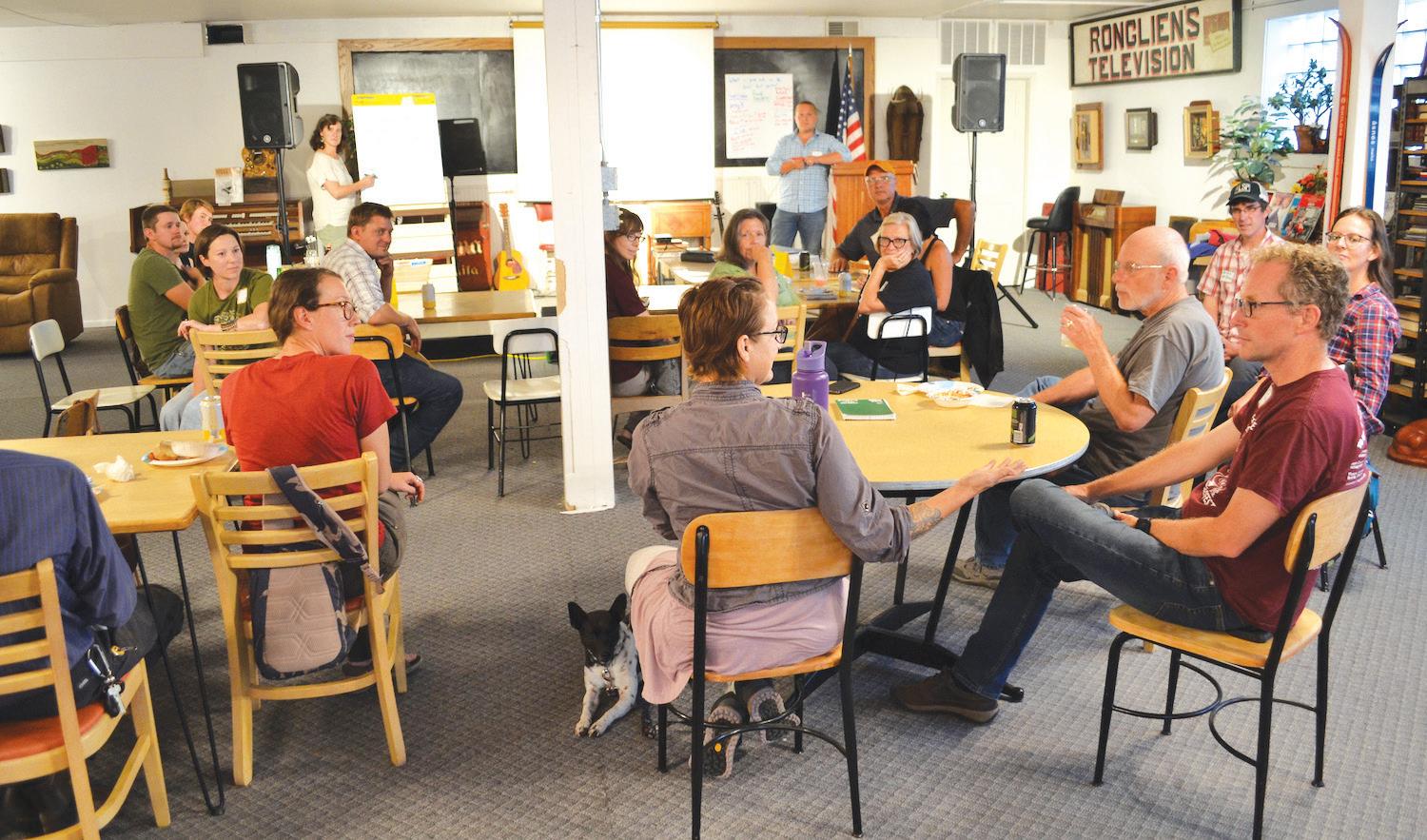
Whiletaking a drive through Midwestern farm country during the growing season, one cannot help but be struck by the sense of abundance. Endless fields full of green plants stretch to the horizon, awaiting a fall harvest of plenty. The trouble is, almost all of those plants are either corn or soybeans, and once they’re harvested, there’s a good chance they will be shipped somewhere else, where they are often used as either live stock feed or as a base ingredient in ethanol. Meanwhile, farm town grocery stores carry fruit, vegetables, meat, dairy products, and bread shipped in from hundreds, maybe even thousands, of miles away.
Like two ships passing in the night, all those commodi ties are exported out of our rural communities, while food for people’s tables are imported in. On top of that, many local grocery stores and restaurants have closed over the years, forcing residents to travel great distances to shop or to settle for unhealthy food items from the local convenience store. The result is not only lack of healthy food op tions, but also a massive leaking of wealth out of rural America. In many areas, the majority of farm income results from federal commod ity subsidies, rather than direct sale of what the soil produces. Ironi cally, rural America’s massive agricultural productive capacity is leaving its residents impoverished from an economic as well as human health point of view.
That’s why the Land Stewardship Project is diving deep into figuring out how to help farming regions develop community-based food systems that provide markets for lo cally produced, healthy food, thus creating profitable ways for farmers to manage the land in a regenerative manner.
In recent months, LSP has been holding community listening sessions in Minnesota where farmers, small business owners, local government officials, and consumers have been sharing their insights about what is needed to create viable food systems in their regions. LSP staff members are taking that input and figuring out what policies, infra structure, and resources are needed to devel op food systems that support farmers, Main Streets, and good land stewardship. As part of this initiative, LSP is working with Ken Meter, one of the most experienced food systems analysts in the country (see page 14), to compile data on the shortcomings of
she raises apples on an orchard she co-owns near Montevideo in western Minnesota. Below are excerpts from a recent LSP Ear to the Ground podcast where Bacigalupo talks about LSP’s current work with community food systems. The podcast can be heard at landstewardshipproject.org/podcast/ ear-to-the-ground-282-kitchen-tableeconomics. More on LSP’s local food work is at landstewardshipproject.org/regionalfood-systems
“What we’re hearing is that people share our understanding that the food system should be created by people for people. They want to reclaim their role in making decisions about how their food is produced and have a say over the social and cultural impacts of that decision. So we’re hearing a lot of desire to work collaboratively to take back some of that decision-making that is currently part of the Big Food system. And they see an opportunity in selling food that stays locally. It’s also about ethics or values around the practices being used. There is definitely a sense that the current food system is extrac tive, and people want more say over what role it plays in our commu nities.
the current commodity-based, export-driven system, and how creating “local food webs” could support a sustainable infrastructure.
Amy Bacigalupo is co-director of LSP’s Programs Department and is overseeing the organization’s food systems initiative. Bacigalupo has an insider’s view of our food and farm system: she helped develop LSP’s Farm Beginnings course, which has assisted in launching hundreds of farming operations over the years, many of which are participating in local markets. In addition,
“We’re also hearing about people’s major struggles with finding processing, espe cially for livestock, and I think there’s some things that can be done on a community level related to that. But a lot of the lack of processing is something that has to be handled via policy changes (see sidebar on page 13). I think it would be hard for a small rural community to take on helping build out a new processing facility. It’s really some
Community Food Systems, see page 13…
LSP is Diving into Community Food Systems Work With Open Ears & an Open Mind
thing that needs public funding. I think part of what LSP can do is build the case for that, especially if we are able to demonstrate a demand on a local level for some of the lo cally produced grass-fed beef, for local pork, or any of those things. We can help build the case to economic development authorities, to the Minnesota Depart ment of Agriculture, that these are dollars well spent and that they’ll be circulated in the community. It’s rural community development, as well as a food systems thing.
“One other thing that comes up in our listening sessions is that people are struggling to find local foods. Even though there are a ton of websites or other resources you can go to, those connections aren’t happening at the level needed to sup port a widespread local foods system. I think there’s a lot of interest on the part of com munity members, but right now we’re just relying on word-of-mouth for people to find out where they can purchase local food.”
“In general, one of the areas that needs strengthening is local governance. I think there can be quite a bit of turnover in some
of these positions in local economic devel opment authorities, for example, or even city planning and management positions. And that just makes it hard to get the bigger picture work done.
“I think it’s really important that we help whoever’s in that position really get grounded in the community and understand
“I’m also impressed with how committed farmers and food business owners are to lo cal foods. They’re going above and beyond to build this food system. Unfortunately, that means they’re taking the risks, and also not necessarily reaping a livable wage. So that’s a challenge I’m really eager to address. Having them manage a communitybased food system is asking too much in terms of them being able to sustain their businesses and their families and continue the good work that needs to be done — like in the case of the farmers, just doing good farming.
some of the trends that have been happening over a long time that are harder to see if you are just new to a place. And then I think on the other side, if somebody has been here a long time, they’ve already constructed their understanding of how things are and how they should continue to be. So we need something like Ken Meter’s data to help really make it clear that we need to change dramatically what we’re doing. This is about our community stepping up and owning that this is a value to our community to support a local foods infrastructure.”
“That’s enough! Our communities should be saying, ‘That’s good, you don’t also have to market and process, along with your farming.’ I’ve just seen in my history that is the piece that becomes too much over time and takes a toll.
“That’s not so surprising, but it is always amazing to me that people struggle at a cost to themselves to make this change possible. So that’s what makes me want to keep doing this work and make it not such a struggle for people. It becomes a case of sustainabil ity. For how long can people do that? Let’s step up as a society to make sure everybody involved in the food system can live healthy, thriving lives.” p
farmers in Minnesota are facing limited meat processing ac cess due to plant closures and fully booked processing appointments, according to a recent University of Minnesota report, “Solving the Meat Processing Workforce Bottleneck.”
The report’s authors interviewed 57 small- to medium-scale meat processors across the state. They found processors are at capacity and looking to hire long-term, reliable employees who could be trained to fit their business needs.
“We’re really struggling in the skilled labor section of the business — butchering, breaking down, and processing. It’s a very skilled craft,” said one of the locker owners. The report makes several recommenda tions, including:
• Creating a one-year apprenticeship for workers with hands-on training in slaughter and meat processing.
• Establishing a pool of funds for processors to access for trainee relocation packages, retention bonuses, and training programs.
• Developing business transition training materials and resources.
The study was funded by the University of Minnesota’s Regional Sustainable Devel opment Partnerships, with financial support from the Minnesota Department of Agriculture (MDA) and the Minnesota Farmers Union. The report’s authors are farmers Paul Sobo cinski and Ted Suss, along with Don Arnosti, a local food connector; Maya Benedict, a former butcher shop operations manager and a gradu ate student at the University of Minnesota; and Courtney VanderMey, a grant specialist at the MDA. Sobocinski is a former policy organizer for the Land Stewardship Project.
A third of the processors interviewed for the report have not started planning for future sale of their business and many don’t know where to find help for such ownership transi tions. In general, successful transitions have involved family members or internally trained employees.
Unique barriers exist for Latinos and other people of color who are interested in owner ship of small locker plants, including language barriers and access to capital.
“Latinos are already working hard in meat
processing in rural communities across Min nesota,” says Greg Schweser, the Director of Sustainable Agriculture and Food Systems for the Regional Sustainable Development Partnerships. “With a concerted effort to overcome unique barriers, this research shows that some would choose to work in, and own, small rural meat processing plants.”
The report’s authors also note that the few local lockers in Minnesota that stock their retail counters primarily with locally sourced meat should be studied with an eye to replicate their success. This could be an important value-added opportunity for lo cal livestock farmers in enhancing their fair share of food dollars.
“Local meat processors have been disap pearing from rural Minnesota. Sustaining these businesses and encouraging them to source locally is vital for livestock farmers to access the more-profitable direct-sales markets,” says Sobocinski, who raises livestock in southwestern Minnesota’s Redwood County.
“Solving the Meat Processing Workforce Bottleneck” is available at misa.umn.edu/ meat-processing-bottlenecks.
“Let’s step up as a society to make sure everybody involved in the food system can live healthy, thriving lives.”
Amy Bacigalupo

KenMeter once did a study in a sparsely populated community in North Dakota that showed that if everybody in that region bought $5 worth of food weekly from a local farm, the overall economic value of those purchases would be greater than all the money generated by all the commodity cash crops grown in the area. This is a prime example of the kind of invaluable number crunching and analysis Meter has been doing over the past five de cades. Meter, who is president of the Cross roads Resource Center, is expert at diving into often arcane government statistics and drawing out trends that other analysts miss. As a former journalist, he also knows how to conduct interviews with farmers, small busi ness owners, and local government officials, and use their insights to put a human face on the data. His conclusions aren’t always easy to swallow: it turns out the U.S. agricultural system is good at churning out record harvests of com modities that are sent all over the world or turned into industrial products like fuel, but this extrac tive system often does not benefit farmers or the communities they live in, and has produced human healthcare costs that all of us pay for.
The good news is that an increasing number of communities that are struggling with how to develop food systems that don’t just export commodities and wealth out of the region are bringing Meter in to compile data on the shortcomings of the current commodity-based, export-driven infrastructure, and how creating “local food webs” could support a more sustainable en vironment. Over the years, he’s worked with 144 community partners in 41 states, two provinces, and four tribal nations. The food analyst is currently working with the Land Stewardship Project in its community-based foods initiative (see page 12).
In 2021, Island Press published Building Community Food Webs, Meter’s collection of highly readable case studies that de
scribe how communities from Indiana and Montana to Colorado and even Hawaii are confronting the dysfunctional nature of our current food system.
Meter recently talked on LSP’s Ear to the Ground podcast about the damage the extractive economy is inflicting on rural communities and the role community food webs could play in revitalizing the land, farmers, and Main Streets. Episode 283 is available at landstewardshipproject.org/ podcast/ear-to-the-ground-283-endingthe-extractive-economy. Below are a few excerpts from that interview:
“It’s a term I started using in the 1970s and no one wanted to talk about it. Even today, I would say most policy and academic circles do not want to talk about the extractive economy — it’s the one elephant in the room that we sort of cannot solve the farm or the rural issue without addressing that straight up and saying, ‘What we’re doing now is taking wealth out of our communi ties.’ ”
“I was just reading inter views from another state this morning that a colleague of mine did with some farmers, and the farmers were say ing, ‘None of us are making money, it’s not working for any of us, but we’ve got to go to scale.’ And that’s the kind of crunch we’re in, because we have this habit of think ing the only market for our food is abroad, and the only way to get efficient and make money is to go to scale. And there’s no answers possible when you think that’s the only answer.
“I just did a study for central Illinois last week and 44% of all the personal income in this 11-county region is coming from public sources. And by far the largest source of income is transfer payments from federal programs. So you have these very strong farm production counties where they’re almost entirely dependent on decisions in
Washington, D.C., about who gets supported and why and when. And I think that’s a re ally very scary thing, because we don’t have the manufacturing base, we don’t have the wealth generating from farming anymore.
“And the amount that we’re spending on medical care for diabetes in this country is $379 billion, which is 88% of all the money generated by all the farmers selling com modities in 2018. So essentially when I give a dollar to a farmer for a bushel of corn or soybeans, I’m giving 88 cents to the medi cal system to treat me for the cost of a corn and soy-based diet and the lack of exercise, and a lack of knowledge about food. It’s an incredible amount of money that we spend on healthcare for something that could be solved by eating better food.”
“The word ‘local’ is very good because it suggests we hunker down and work with our neighbors and all those good things. How ever, it’s so easy to greenwash that term, or localwash that term, and say, ‘Well what we’re doing is local.’
“And the folks in Montana had the most eloquent answer for that. They said, ‘Okay, we’re working with communities around the border of Manitoba, border of Saskatch ewan — well, does buying local food mean buying it from Manitoba or somewhere in Montana? If we get it from North Dakota, is it no longer local food?’ And that got them thinking in very different terms what local food meant. And they said, ‘What we’re really trying to build in our food systems is community-based.’ And they started using the term ‘community-based food systems.’ ”
“And that’s one of the reasons I called the book, Building Community Food Webs, because to me, the concept of a web shows the relationships and the filaments that are very fragile individually, but have a lot of strength together.
“That represents the kind of work that we’re doing — like the web of mycelia working underground to bring nutrition through the soil from plant-to-plant through the network. That’s what natural systems do, that’s what people do. And what we really need to do is understand those, treasure those, give those more leverage, and then not get in the way of them working.
“One of the problems we have with the regenerative agriculture discussion today is that it’s about agriculture and not about food systems. Because we can’t have a regenera tive agriculture unless our food systems are supporting that regeneration and acting in concert.” p
The Land Stewardship Project’s Farm Beginnings class is accepting appli cations for its 2023-2024 session. Beginning and prospective farmers are invited to apply to the course, which is a year-long training program that focuses on the goal-setting, marketing, and financial skills needed to establish a successful farm business. The Farm Beginnings course creates a space for students to name their vision, acquire the tools and skills needed to make it happen, and become part of a com munity of support to help them succeed.
The course will run from November 2023 through March 2024, with some additional educational opportunities taking place later in 2024. In the past, the class has been offered in a hybrid format — online and
in-person. It is yet to be determined what format the 2023-2024 course will be offered in. Farm Beginnings is:
• Farmer-led: Class participants will hear from regional farmers about their farms and how they’ve implemented goal-setting, marketing, and financial management practices.
• Community-based: Applicants from Minnesota, western Wisconsin, and northern Iowa will be given priority because LSP is best able to provide resources and connections in this area. If you are located elsewhere, see the Farm Beginnings Collaborative website — farmbeginningscollaborative.org —
to see if there is an organization near you offering Farm Beginnings.
• Focused on Sustainable Agriculture: All farmers are encour aged to create a farm plan that is eco nomically, socially, and ecologically sustainable.
The deadline for applications is Sept. 1, 2023. The cost of the class is $1,000 for up to two participants per farm. Early bird ap plications submitted by Aug. 1 will receive a $100 discount if you are accepted into the class. Scholarships will be available.
For details and to register, see land stewardshipproject.org/farm-beginningsclass. For questions, contact Land Stewardship Project Farm Beginnings organizers Pilar Ingram (pingram@landstewardshipproject.org, 612-4006349) or Annelie Livingston-Anderson (annelie@ landstewardshipproject.org, 612-400-6350). p
u Kevin and Christine Ballman have spent years growing a diversified farming operation that includes crops, vegetables, livestock, and caring for the land. They are looking to purchase land and buildings for their operation. While they are hopeful to find this opportunity in western Wisconsin or eastern Minnesota, other areas will be considered. Contact: Kevin Ballman, 651385-0321, kevinballman@gmail.com.
u Jason Halonen is seeking to rent 4,000-square-foot, or up to an acre, of farmland for perennial flower hybridizing in Minnesota. He is looking to rent for two-tothree years. Access to running water would be necessary. Land could even be a weedy patch on the edge of a property, or lawn areas turned into garden beds. Owner would have the option to keep the garden beds (and most plants) after, or have everything removed. Halonen is willing to teach about hybridizing and share the use of the plants for that purpose. Contact: Jason Halonen, jason.halonen@gmail.com.
u Marcellin Kopandru and Emily Kal nicky are looking to purchase 40+ acres
of farmland in Wisconsin or Minnesota, approximately one hour from Duluth. They are looking for a mixture of wooded and open land, with a creek or other source of water (if available). No house or buildings required, but they are open to property with buildings. There is a preference for organic or land that has not been sprayed for years, but they are open to land that has been conventionally farmed.
Contact: Marcellin Kopandru and Emily Kalnicky, emily.kalnicky@gmail.com.
u Andy Petran is seeking to purchase 10 acres of farmland within 45-minutes of the Twin Cities Metro . Land with irriga tion hookups, outbuildings, electricity, and possibly septic is preferred. No house is required.
Contact: Andy Petran, 847-732-1840, a.petran@tcberries.com.
u Lee Peterson has for rent 200 acres of pasture in northwestern Wisconsin’s Burnett County, near Alpha. He is looking for someone to rotationally graze the land; it was certified organic for a number of years and has not been sprayed recently. The south and west property line has new fence; there is a drainage
ditch through the middle, east to west. No house is available. Contact: Lee Peterson, 507-279-3891, w.v.lee1952@gmail.com.
u Dave and Amy Anderson have for sale 20 acres of farmland in western Wisconsin’s Polk County, about six miles south of Osceola on a quiet, lightly traveled road in Farmington. It currently has 11 acres till able, 5-6 acres wooded, 3 acres homesite/ yard and garden. There are several organic farms in the immediate area, and Standing Cedars Conservancy’s 1,100-acre Engle wood property is across the road — open to the public for hiking, skiing, and hunting by permit. The house, designed by Rolf Ja cobson, a recognized expert in sustainable design and a research fellow at the U of M Center for Sustainable Building Research, was built in 2009 and has extensive energy saving features. Outbuildings include a ga rage with generous storage space, a chicken coop adequate to house 25 chickens, an 8 x 12 shed, and a brooder house for young poultry. The asking price is $495,000. Contact: Dave and Amy Anderson, daveschickens@gmail.com.
OwlBluff Farm is tucked away in one of those Driftless Area coulees where cellular signals go to die. In fact, when contractors were constructing a building there recently, they sometimes climbed half-way up an aban doned silo on the farm to use their phones. It has a sense of being an isolated, if beauti ful, little spot in southeastern Minnesota’s Houston County.
But on a recent summer day, Carrie Calvo took a break from weeding her vegetable plots to quickly tabulate just how connected the 20-acre farm actually is to the region.
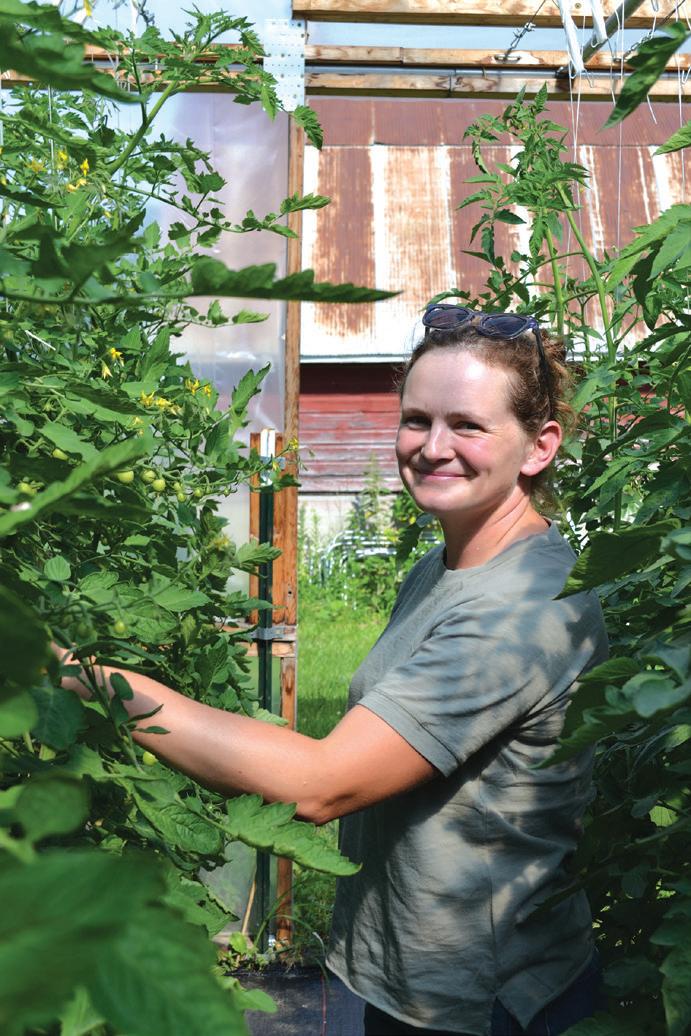
From April to November, she delivers to two area grocery stores that are within 20-minutes of the farm. Owl Bluff also sells to a community food hub, two cafes, and a farmers’ market, all within a half-hour of the farm. The furthest Calvo has to drive to her customers is an hour to Rochester, Minn., where she delivers vegetables and a neigh boring farm’s chickens as part of a home delivery enterprise.
And Calvo has been able to connect with half-a-dozen other beginning farmers in the area who are undertaking innovative enter prises like grass-based livestock production and silvopasturing. Not too bad for a farm that was bought sight unseen while Calvo was sitting in front of a computer 7,000miles away.
“I’m surprised at how able we were to find customers and to have a loyal customer base so close,” she says as she provides a tour of the half-acre of vegetables she raises with the help of her husband, Charles, and mother, Kathy Burch. Carrie, who’s 37, adds with a laugh, “And then when I moved here, I met a whole bunch of other crazy young farmers.”
She concedes making the move into farming after spending 10 years working for the U.S. government — five of it in the desert metropolis of Dubai — seemed a little less crazy after she completed the Land Stewardship Project’s Farm Beginnings course in 2019. Through classes led by es tablished farmers, trainings in business plan ning and innovative marketing, and perhaps most important, conversations with other wannabe farmers, Carrie saw the potential to
take a holistic approach that linked the land, people, and community.
“Farm Beginnings really helped me think through the whole plan,” she says.
Carrie grew up in Rochester and has an undergraduate degree in Middle East studies and a master’s in Persian languages. So it
vegetable production gurus such as Eliot Coleman and Jean-Martin Fortier. Carrie completed an online market gardener master class while the couple kept an eye on real estate listings in southeastern Minnesota.
Finally, through Craigslist, the Calvos found a farm that seemed to fit the bill: it had a house and some outbuildings, as well as tillable land, including a south facing slope, something Coleman insists is neces sary for a successful vegetable operation. The tillable parts of the farm were also mostly hay ground, making it easier to get the land certified organic.
Burch checked out the farm and reported back that, “It’s a little rough, but it’s really pretty down here.” Carrie and Charles wrote an “impassioned” letter to the owners about their plans to launch a farming enterprise on the property. The owners, who were in their 80s, had raised feeder calves and hay on the property, and wanted it to stay in farming. The younger couple made it clear in their letter that they wanted to farm the land, restore the house, and live in it year-round.
“I think they just were excited that some one seemed to appreciate the property and were going to actually put down roots there and not have it be just a weekend hunting property kind of place,” says Carrie.
Given that they were half-a-world away and lenders in the community didn’t know them, financing was tricky. But Carrie and Charles were eventually able to get a busi ness loan and then later refinance and turn the loan into a regular residential mortgage. They moved onto the farm in 2018 and planted a small plot of vegetables for them selves, neighbors, and family.
was no surprise that her career path led her to Dubai. Although she didn’t come from a farming background, she’d always been attracted to working outdoors and rais ing healthy food. Charles, who she met in Dubai, grew up in Massachusetts, and also has no farming background. Thank goodness for the Internet.
“I think the last year or two we were in Dubai we spent every evening and weekends watching farming YouTube videos,” Carrie recalls. She also listened to old episodes of Farmer-to-Farmer — a popular podcast pro duced by the late Chris Blanchard, a veteran vegetable producer — and read books by
That first year went well, but Carrie knew having one season of growing a big gar den wasn’t enough; financial management and business planning are weak spots for her, and she knew little about how to build consistent, local markets. Local livestock producer Dayna Burtness recommended she take LSP’s Farm Beginnings course. For over two decades, Farm Beginnings (see page 15) has offered training for beginning farmers in holistic business planning, inno vative marketing, and goalsetting. It’s taught by established farmers and other agriculture professionals from the community, and pro vides an opportunity for participants to be mentored by producers who are undertaking the kinds of enterprises the students would like to pursue.
Carrie says the course helped her develop a budget and marketing plan and, just as importantly, taught her how to do the kind of goalsetting that balances work and qualityof-life issues. She remembers one assign
Somewhere, see page 17…
“When I moved here, I met a whole bunch of other crazy young farmers,” says Carrie Calvo with a laugh. She found her farm in Minnesota while living in Dubai. (LSP Photo)
ment in particular where class members had to come up with the top three enterprises they were interested in, the costs, and what they’d expect to earn back in a certain num ber of years.
“It really helped me to focus on every little cost that was going into starting the operation and expanding the operation, and estimating what the return would be and in what sort of time frame we would be able to make back costs,” says the farmer.
That and other exercises helped Carrie narrow down her farming plans and focus on vegetables. And through the class, she was able to connect with Hallie Anderson, who runs 10th Street Market Farm in Afton, Minn. Anderson’s operation is similar to what Carrie aspired to: vegetable production that serves various local markets. She visited 10th Street and got advice on, for example, how to set up a high tunnel system.
Since completing the class, Carrie has taken on more markets and expanded pro duction. Half-an-acre of the farm is growing vegetables, but there’s room on the certified organic operation for more.
“I think we could produce probably twice as much and still be able to sell most of it,” she says. “The grocery stores were so excited to have local, organic options.”
They’ve used USDA Environmental Quality Incentives Program funding to set up a high tunnel system — they now have three unheated tunnels, and would like to add a heated greenhouse to help with propa gation. Right now, they’re starting every thing in an old freezer that’s been hacked to make it a germination chamber; plants are eventually moved to the dining room, mak ing for a crowded house in the early spring.
They have installed a walk-in cooler and Burch, a retired physics teacher who is handy with tools, set up a vegetable washing station in an old machine shed. Owl Bluff recently finished a combination carriage house and pack-shed that can be used dur ing the colder part of the season. They’ve
Carrie Calvo and her mother, Kathy Burch, take a break from weeding and harvesting on Owl Bluff Farm. “I was worried maybe we wouldn’t be able to find enough customers here, but I actually think we could produce probably twice as much and still be able to sell most of it,” says Calvo. (LSP Photo)

also erected a high fence around the veg etable plots to keep out the deer. The farm has stepped into the value-added world by producing dehydrated and canned products, including paprika smoked by a local barbe cue joint, Fat Pat’s.
Four years in, the family is at a point where they need to make decisions about expanding and what changes in infrastruc ture that might require. Carrie says having several different markets during the week allows them to split up the harvesting sched ule and pretty much sell everything grown. But efficient transportation can be an issue.
“We’re still driving this truck to the farm ers’ market with all of our stuff mounded in the back,” she says, pointing at a pickup parked near the pack-shed.
Although there’s plenty of demand in the area for more vegetables and Owl Bluff has additional land that could be farmed, for now, there are no major plans to expand, says Carrie. Two neighboring farmers help out on delivery days. Along with Charles and Kathy, that’s the extent of the labor
force. (Charles works off the farm and helps out in the evenings and on weekends.) Car rie says they’d like to stay at this size, given labor issues and the time commitment of servicing more customers. Expanding sig nificantly would likely mean servicing more wholesale accounts, more time on the road, and less time with each customer — some thing the farmer says she wouldn’t enjoy.
“It is exhausting, but also really satisfy ing at the size we’re at,” she says, adding with a laugh, “And it’s just barely out of control.” p
episode 293 of the Land Steward ship Project’s Ear to the Ground podcast, Carrie Calvo talks about the sur prising availability of various marketing options in her local community and the benefits of networking with other begin ning farmers: landstewardshipproject.org/ podcast/ear-to-the-ground-293-middle-ofsomewhere.
On
The desire to farm is powerful — sparked by love of food, the land, community, entrepreneurship, and more. But it is a complicated undertaking, and the list of questions that need to be addressed before diving in is long. If you are dreaming of farming and puzzled about how to get started, the Land Stewardship Project’s Farm Dreams initiative may be for you.
Farm Dreams is designed to help people clarify what motivates them to farm, get their vision on paper, inventory their strengths and training needs, and get perspective from an experienced farmer. To get started, go to landstewardshipproject.org/farm-dreams-workshop and download the Farm Dreams visioning exercise in pdf format. For more information, contact LSP Farm Beginnings organizers Pilar Ingram (pingram@landstewardshipproject.org, 612-400-6349) or Annelie Livingston-Anderson (annelie@landstewardshipproject.org, 612-400-6350).
Onan overcast day in late June, Arlo Hark drives a semi into a gravel parking lot near the south eastern Minnesota community of Rushford pulling a trailer adorned with an “Eat Lamb: 10,000 Coyotes Can’t be Wrong” bumper sticker. He opens two doors on the side of the trailer and 120 lambs and ewes explode out the sides in a white, woolly blur. They quickly trot over to a three-foot high stand of grasses and forbs growing beneath five acres of solar panels, which, like silicon sunflowers, are slowly turning to face the noon-day sun utilizing automatic tracking mechanisms. The creaking of the panels doesn’t seem to bother the sheep — they know the drill. In fact, Hark has just picked the animals up from another solar array north of here. In a week, he’ll be back to load them in the trailer and move the herd to another solar garden in southern Minnesota.
“Five acres at a time,” says Hark as he sets up a portable watering system for the sheep and prepares to make the two-hour drive back to his home in Northfield, Minn.
Welcome to the world of solar grazing — a livestock-centric twist on “agrivoltaics,” the concept of using the same acre for energy produc tion and the raising of food.
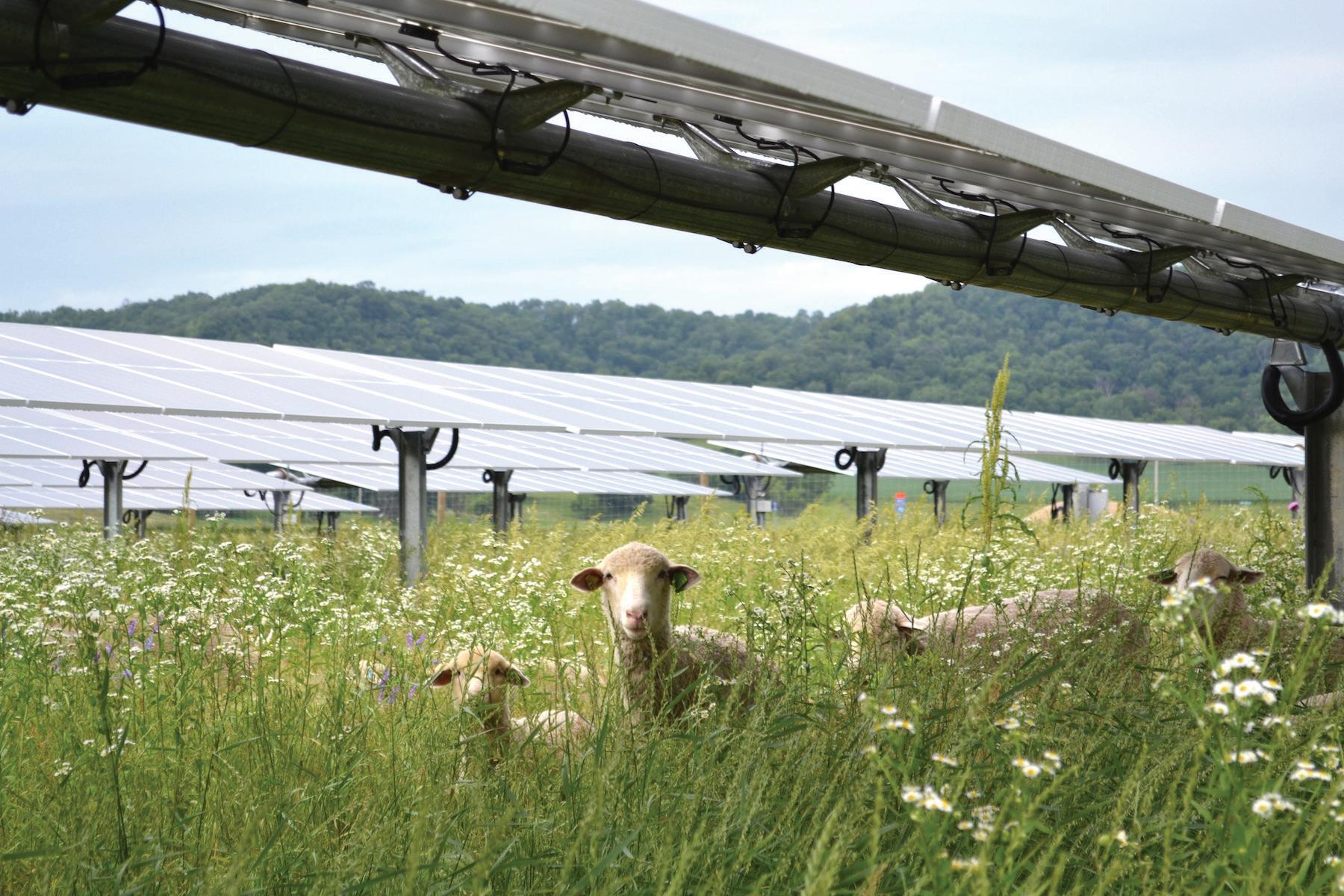
“You’re trying to take two business models that can exist without each other, but make them both better by working together synergisti cally,” says Julian White, vice president of operations for Nokomis Energy, a solar site developer that works with Hark.
For the solar industry, those sheep repre sent a way to manage undesirable vegetation and promote the kind of ground cover that
makes the panel more efficient, all while building the kind of healthy soil that man ages water better. They are also living proof that solar production and working farmland are not mutually exclusive, an important message to communicate as rural residents raise concerns about how much land panel arrays could eventually occupy.
To Hark and Josie Trople, his wife and business partner, solar grazing also offers a way to overcome one of the biggest barriers beginning farmers face: access to land. Since graduating from the Land Stewardship Proj ect’s Farm Beginnings course three years ago, the couple — both are 27 — has been developing a farming business model that does not tie them to a mortgage. If it works, they see it as a way to not only raise meat
“We don’t own land, we haven’t owned land, but our animals spend a lot of time in a lot of places,” says Trople. “When it comes to the ecological standpoint, I think we can make a bigger impact when we’re not reduced to grazing one space.”
Hark goes one step further — he sees the classic model of owning the land you graze as impractical in many ways. “I don’t think it’s the future of livestock grazing,” he says emphatically. “With the price of land right now, it’s impossible.”
This enterprise could be called a rootless farming operation or a decentralized grazing enterprise, or even a vegetation management service provider, and both the farmers and the solar developer concede it’s a work in progress. But the excitement around the po tential for creating a new model of farming, land use, and energy production is palpable.
“It’s a cool idea,” says White.
and wool profitably with minimal overhead, but to create a model for farmland access that is not anchored to individual owner ship. And given the key role reintegrating livestock onto the land can play in building soil health, Hark and Trople feel that such a model offers the best way to have a positive impact on as many acres as possible.
Trople and Hark first realized the re storative power of grazing soon after they moved to Northfield in 2018. Hark grew up on a hobby farm in the community and Trople’s family raised beef and hay in south ern Washington, where she grew up. They met while both attending the College of the Atlantic, in Maine, where they worked with sheep and vegetable production at on-campus farms. Before graduation, they had worked for Betsy Allister and An drew Ehrmann, who op erate Spring Wind Farm, a vegetable Community Supported Agriculture operation near North field. By the time Josie and Arlo came back to the area after college, they knew they wanted to raise sheep, and had already begun building a flock. A Spring Wind Farm neighbor had five acres of pasture that needed grazing. The young couple got their feet wet grazing feeder lambs on the property, which was becoming overgrown but had lots of hardwood trees, providing the potential for restoring an oak savanna habitat.
“We got to the site, and we realized, this
Solar, see page 19…
Proving Energy & Food Production Can Co-Exist — 1 Megawatt at a TimeJosie Trople and Arlo Hark’s sheep graze at a solar array owned by a company in southeastern Minnesota. “We want to build this new kind of relationship between the energy sector and the agriculture sector in the Midwest,” says Hark. (LSP Photo)
really needs some tender loving care,” re calls Hark. “So part of what we set out to do was figure out how to use livestock in that space to try and do some restoration.”
Indeed, the rotational grazing of the sheep removed the invasive species and helped revitalize the soil biology, helping regenerate the pastures.
Trople and Hark were able to begin sell ing lamb as an add-on to Spring Wind’s CSA program, which helped the couple realize that maybe there was a way to develop a business model that combined restoration ecology with food production — all without getting strapped with the economic burden of owning acres.
Allister and Ehrmann are graduates of Farm Beginnings, a course that is taught by established farmers and which focuses on holistic planning and goalsetting (see page 15). The CSA farmers recommended that the younger couple take the course to learn more about business planning, marketing, and goal setting — in other words, get the grounding to make their idea for a land restoration company economically viable in a way that matched their environmental and community values.
“Andrew and Betsy raved about how it was a way for us to really have some good conversations about what our values are, about how we want to set up a business and a life in agriculture, and a life that’s con nected to the land,” says Hark. “And they said it was really helpful in figuring out how to make money doing all that stuff. If noth ing else, it’s going to be like great couple’s counseling.”
After taking a day-long introductory LSP class called Farm Dreams, the couple enrolled in Farm Beginnings during the 2018-2019 session. They say the course helped them clarify just how they would make money from their livestock enterprise. Through planning and goal setting, they landed on a business model of restoring grasslands for hire, while producing meat and wool that they could sell.

During the next few years, Trople and Hark grazed vegetable farms and orchards, as well as used grazing to help restore prairie habitat. During this time, Hark came across the American Solar Grazing Associa tion, through which he learned about the idea of using sheep to control vegetation beneath solar arrays, a strategy that’s taken off in the East and South in recent years. He approached solar developers in Minnesota with this “crazy idea,” and began building a
network of professionals in the industry that were willing to pilot a handful of projects in the region.
Hark and Trople say, in a sense, the solar arrays are ideally set up for rotational grazing of sheep. They stand five or six feet off the ground and have perimeter fencing around them. The panels provide shade for the animals, which reduces heat stress and water use. Depending on the ground cover,
ficiency of the sheep.
“I think what’s been great about sheep is that they’ll eat everything,” he says. “They can eat stuff that a mower for sure won’t hit, and often a weed whacker won’t hit either.”
He adds that solar grazing also helps show local communities that energy produc tion and agriculture aren’t mutually exclu sive.
“Some permitting jurisdictions don’t love that they see solar as taking land out of ag use, and so this is a way to say, ‘No, this is still an agricultural site,’ ” White says.
In 2022, Cannon Valley Graziers serviced a portfolio of sites operated by multiple developers throughout southern Minne sota. The arrays range in size from five to 20 acres and the graziers charge for their services by the acre. Trople and Hark winter their flock in a rented barn at the Sharing Our Roots Farm near Northfield.
Trople and Hark have found that the sheep perform well as migrant graziers. They hold their body condition and even put on weight under the panels, which can be growing anything from turf grass to restored prairie, and everything else in between
a group of roughly 100 sheep are able to service a one-megawatt array (around five to seven acres) in less than a week.
From the solar company’s perspective, it can be a way to avoid having to mow and spray undesirable plants during the growing season. Such maintenance is labor intensive, expensive, and, at times, harmful, to the array’s equipment. But it’s needed: tall veg etation can shade out panels and mess with wiring. Newer solar panels are now bifacial, meaning they can collect energy on both sides; that makes keeping the underside of the panels from being obstructed by vegeta tion even more important. A weed-choked array can also violate the contractual prom ise a solar developer has made with a local government entity or landowner to maintain the property. Studies have shown that when a healthy stand of perennial vegetation is present under a solar panel, the electronics involved run cooler, which increases energy efficiency.
For the past two years, Nokomis Energy has used Trople and Hark’s company, Can non Valley Graziers, to control vegetation under a six-acre array near Waseca, Minn. White says the arrangement is still in the pilot phase, but he’s impressed with the ef
“There’s a lot of biomass on some sites, like a lot,” says Trople. Portable watering systems are hauled to the sites, but the sheep get much of their liquid refreshment from the plants they graze, and the panels serve as handy shade during the hottest parts of the day. Through trial and error, they’ve figured out the best breed of sheep to use — Ram bouillet, a Merino type of breed that doesn’t require top quality feed to do well.
In general, Hark and Trople say one way they could make their enterprise more ef ficient is to reduce the amount of time they spend on the road. Currently, they drive the sheep as far as 100 miles one-way, but they expect that this will become easier as they develop larger portfolios of sites and they have the ability to create more efficient service routes.
“When we’re loading and unloading with our trailer, there’s all these moving parts and you need to get these systems down,” says Trople. “As a livestock person who is decentralized, it’s all about being flexible and being able to make last-minute deci sions comfortably about how many animals you’re going to move, where they’re going to be, and for how long.”
There is strong demand for the lamb they sell, and they’ve built up a customer list that includes restaurants, Spring Wind’s CSA membership, and food co-ops. About a quar
Solar, see page 20…
“Land ownership can be a tool, but it can also be a ratchet that keeps things hard and inflexible,” says Trople, shown with Hark. (LSP Photo)
…Solar, from page 19
ter of their income is generated from lamb sales and Trople is working on developing a value-added wool company.
Thus far, the grazing business is supple mented by Hark and Trople working other, non-sheep related, jobs. But the young farmers feel that because they aren’t saddled with making land payments, they have the freedom to experiment in a way that could eventually make Cannon Valley Graziers a fulltime enterprise.
“We have been able to invest a little bit of money into getting wool processed and played around with that because we don’t have to make a mortgage payment every month,” says Trople. “Land ownership can be a tool, but it can also be a ratchet that keeps things hard and inflexible.”
And the key to that flexibility lies under acres of solar panels, with the potential for taking advantage of the voltaic landscape only increasing in states like Minnesota (see sidebar below). Hark and Trople are con stantly assessing and tweaking their system. For example, currently they’re trying to figure optimal stocking densities, when the animals should be moved, and how to man age the logistics associated with a mobile grazing enterprise. Fortunately, others in the business are willing to adjust as well.
First, a few solar statistics: by 2030, one-to-three million acres of land in this country will be shaded by voltaic panels, according to the U.S. Department of Energy’s SunShot program. Today, roughly 5,000 to 7,000 acres of Minnesota’s land scape is sprouting solar panels, representing a gigawatt of electrical power, or about 1% to 2% of the state’s overall needs. Minnesota has a statewide target of producing 10% of its energy from solar by 2030, which is equal to six gigawatts of solar capacity. If each megawatt requires roughly seven acres of land, this new solar capacity would encom pass 37,000 acres, or 0.13% of Minnesota’s 26.9 million acres of farmland.
To beginning farmers Josie Trople and Arlo Hark (see page 18), all those numbers don’t just represent more juice running through the lines to our homes, factories, and institutions. They pose a huge potential for what they call decentralized grazing — rotating sheep and other livestock under the panels to control vegetation and build soil, all while providing access to land for farmers like themselves.
In fact, the American Solar Grazing Association estimates that 15,000 acres of solar sites are maintained with sheep already. Most of that development has been in the South, Northeast, and West. Industry experts say there is tremendous potential for expand ing solar grazing in the Midwest.
A Cornell University study found that utilizing sheep for solar site management required 2.5 times fewer labor hours than traditional methods, such as mowing and weed whacking. One Cornell survey of 14
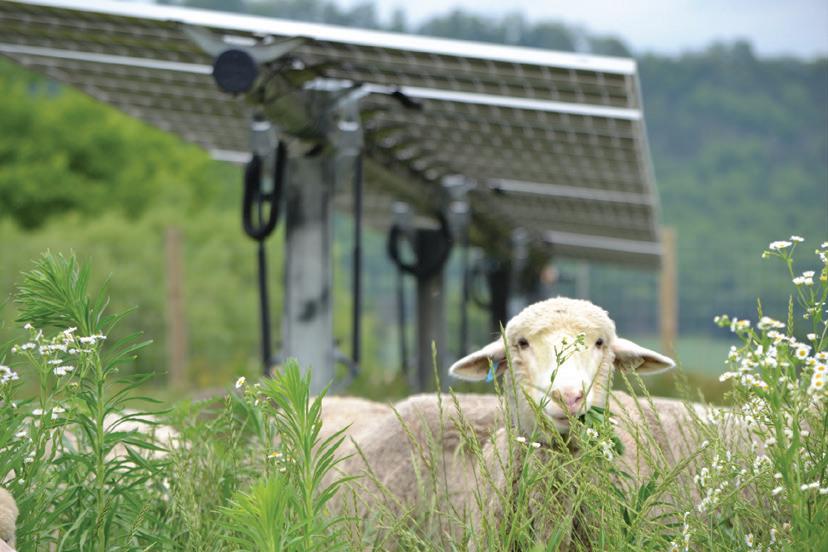
Northeastern sheep producers who were graz ing under panels showed an average annual net income of $262 per acre via the practice.
Solar grazing is part of the larger move ment called “agrivoltaics,” which combines solar energy production with food and fiber farming. Arizona researchers have found tomato production doubles under solar arrays and researchers at Purdue University and the
“For us, Arlo and Josie are the perfect group to be working with right now because we’re learning a lot about it and they’re learning a lot about it,” says Nokomis Ener gy’s White. “We’re thinking long-term, and so if it’s a nascent idea we need to explore it, because if it’s the right long-term solution, then we need to understand it now.” p
On episode 294 of the Land Stew ardship Project’s Ear to the Ground podcast, Josie Trople talks about how solar grazing provides an opportu nity to access farmland without owning it: landstewardshipproject.org/podcast/ ear-to-the-ground-294-rootlessregeneration.
potential for being combined with another dual-purpose option: planting native grasses and wildflowers under the arrays, and thus providing pollinator habitat. According to a Yale University study conducted in Minnesota, that habitat increases yields in adjacent fields that are growing pollinator dependent crops like soybeans, fruit, or certain kinds of vegetables. Since Minnesota passed a voluntary pollinator-friendly solar standard in 2016, roughly half of new solar acreage in the state has been developed as pollinator-friendly.
Grazing pollinator plantings holds great potential, say Hark and Trople — they are doing research funded by the Minnesota Department of Agriculture on seed mixes that strike a balance between feeding sheep and supporting pollinators.
Julian White, the vice president for op erations at Nokomis Energy, a Minneapolisbased solar developer that uses Trople and Hark’s sheep to control vegetation, says the jury is still out on the acreage-based eco nomic break-even for grazing under panels. The overhead costs involved with hauling sheep long distances to smaller arrays of just a few acres can be a barrier, he says.
University of Wisconsin are studying the best way to combine Midwestern cropping and solar production on the same piece of land.
As far as solar grazing goes, most of the attention has focused on sheep, given the ease with which they can fit under the panels and make use of poorer quality forage. But University of Minnesota research on grazing dairy cattle under solar arrays is generating promising results: for one thing, the cows stay cooler under the panels, producing more milk.
Grazing under panels also holds great
White says an ideal situation would be to have graziers based near every solar array, providing access to the services their ani mals can provide in a more efficient manner. Hark agrees, and says that’s one reason he and Trople are willing to be pioneers in this area of agrivoltaics — they want to prove this is economically viable for more farmers and more solar companies.
“We want to build this new kind of rela tionship between the energy sector and the agriculture sector in the Midwest.”
DickGulbranson is proud of the steps he’s taken to steward the landscape on his little slice of paradise in west-central Minnesota. When his family bought 65 acres on the shores of Big Chippewa Lake in 1984, they built their house well away from the water to reduce the water quality impacts of possible runoff and erosion. Much of the land is in trees and there’s a creek running through it, along with tiny pothole wetlands that can be swarming with waterfowl during migrations. The retired school administrator and banker — he’s 83 — loves seeing the wildlife and knowing that he’s doing his part to keep the Big Chip pewa clean — after all, the lake is at the head of a watershed that feeds into the Chip pewa River, which in turn is the biggest waterway flowing into the Minnesota River.
“Guess how many species I got last year?” Gulbranson asks a visitor on a summer day, pointing to a set of bird feeders at the back of the house. “Twenty-eight! We finally got a pair of cardinals to come after all these years.”
But he’s also proud of the “working” aspects of his property, 15 acres of which is tillable. While he takes a break from yard work, Gulbranson points out a nearby soy bean field which has rows covered in a natu ral mulch created by a dead rye cover crop. That cover keeps soil in place while building its biological health in the long term.
“There are some slopes here, but there’s nothing being washed into the lake,” he says. “I can say I don’t think there’s any ero sion. We just trust John, he does a good job.”
“John” is John Ledermann, a neighbor
ing farmer who rents those 15 acres, along with a patchwork quilt of other parcels in the neighborhood that are as small as just over an acre in size. Ledermann shares the stewardship ethic of Gulbranson and his other seven landlords, and reflects that ethic in the way he raises crops on their properties — taking extra care to utilize soil healthy practices like minimum tillage, covercropping, and diverse rotations. While these parcels make up a small part of his overall
says the 55-year-old farmer. “I grew up on conventional tillage and there’s always that point where you drive by a nicely clean, black field and think, ‘Oh, that looks kind of picturesque, you know.’ But on my own fields, I don’t like to see black soil. If I work a little bit of an area, I cringe.”
Ledermann has taken a methodical ap proach to adopting soil health practices. He started farming in 1987 and has always raised corn, soybeans, and wheat. Back in the 1990s, he tried no-till and a form of conservation tillage called ridge-till, but had problems with reduced yields, among other things. However, Ledermann was always drawn to the idea of disturbing the soil less and building up its structure in a way that it cut erosion and runoff. The part of Douglas County he farms in is full of pothole wet lands and lakes, making water quality issues a big concern. And the fewer passes required in a minimally tilled field can produce big savings in terms of the fuel burned and time spent in the tractor seat.
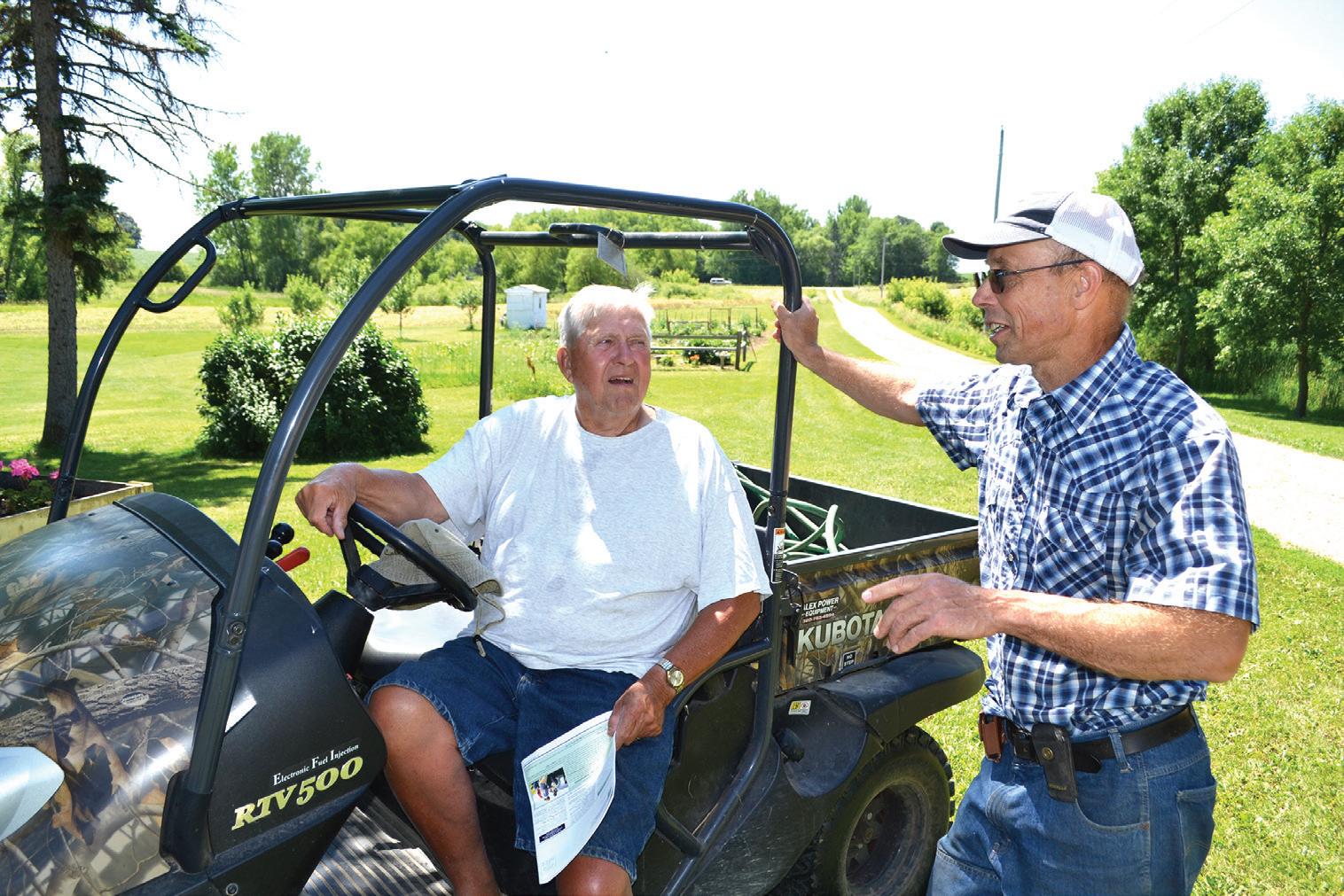
In 2011, Ledermann began utilizing a con servation tillage system called strip-till, and added cover cropping into the mix. Within the first year, he got what he calls “a convincer,” thanks to an impromptu side-by-side experiment.
operation, Ledermann feels it’s extra impor tant to implement conservation practices on them. At a time when many crop produc ers prefer to farm fields hundreds of acres in size, Ledermann has carved out a niche dealing with the odd corners that are tucked in among lakes, wetlands, and woodlands. They may not lend themselves to efficient use of big equipment, but this piecemeal farming has allowed him to do his part to take care of the landscape in his community while experimenting with new practices and exposing landowners to the long-term benefits of working lands conservation.
“It feels good to drive around and see these fields no-tilled and cover-cropped,”
He had a cornfield where part of it was strip-tilled and planted to cover crops the previous fall. The other half had been managed in a more conventional manner: no cover crops and it was chisel plowed after harvest the previous fall. One day, after a three-to-four-inch rain on corn that was a couple inches tall, Leder mann was walking across the field at dusk and he noted that on the portion that was strip-tilled and cover-cropped, there was no erosion. He also spied something else.
“I have bifocals and so walking along I saw a little motion, you know, and I thought, ‘Is it my glasses or what?’ And then I began slowing down and here it was — the earthworms were coming out,” Ledermann recalls. “I walked along and they were slip ping back into the soil.”
Renting It Out Right, see page 22…
“I can say I don’t think there’s any erosion. We just trust John, he does a good job,” says Dick Gulbranson (left), shown here with John Ledermann, who he rents land to. (LSP Photo)
John Ledermann’s Rental Relationships are Built on Healthy Soil
any given year.
These practices seem to be producing positive results. On July 8, he checks on a cornfield that was planted green into stand ing rye the second week of May. He got into it later than planned because of a late, cold spring, and the rye was 18-inches high, the tallest he had ever let it get for planting corn.
which, at 55-acres, feels luxuriously roomy compared to the other parcels Ledermann farms. A dense mulch of dead rye cover crop fills the rows between the soybeans, which are several inches high. Again, even though it’s a hot July day, the soil beneath the mulch is cool and moist. “They’ll really take off now,” Ledermann says of the soybeans.
In contrast, the conventional portion of the field had no earthworms and lots of ero sion. “So that was basically six months into a system and it was night and day differ ence,” he says. “It was just amazing to me that there could be that much difference in that short of time. Ever since then, I’ve been pretty sold on it, more or less.”
Over the years, Ledermann has gradually upped his use of soil health practices, utiliz ing initiatives such as the USDA’s Environ mental Quality Incentives Program and the Conservation Stewardship Program to help cover the costs. He’s modified his equipment to allow him to interseed cover crops into growing corn and has adopted the use of “planting green” — seeding a cash crop like corn or soybeans straight into standing rye.
“I’m still not completely over that,” Ledermann says of the nervousness he feels running a planter into a field of growing rye.
He farms 800 owned acres and rents an additional 350 from eight landowners. The parcels are tucked away in amongst pothole wetlands, lakes, and stands of trees, making for a lot of smaller fields. He’s got a couple parcels that are an acre-and-a-half in size, and one 15-acre rental farm that’s broken up into four or five different fields.
Most of the landowners John rents from are elderly and live in the area. One is a retired farmer; some are people who bought land in the area for hunting, recreation, or, like Gulbranson, a pleasant place to live.
“They don’t have big fields, but they like to see that land productive,” says Leder mann. “They don’t want to idle it under the Conservation Reserve Program. They enjoy seeing it productive.”
Besides providing conservation benefits and fuel savings, minimum-till and no-till also save time, which is key when farming numerous tiny parcels. In fact, it was in the smaller fields that Ledermann began experi menting with conservation tillage, and later cover crops, first. Smaller tests equal smaller “disasters” in his mind. In a typical year, Ledermann may have as much as 800 to 900 acres cover-cropped, although it can also be half that, depending on his rotation and weather factors. Over half of Ledermann’s acres are minimum-tilled and no-tilled in
“I was worried about this field,” Leder mann says as he wades into the chest-high corn. But the crop appears to be thriving. The previous cover crop, which he termi nated with herbicide soon after the corn was planted, is pretty much broken down into the topsoil, a sign of good biological activity being present. Ledermann had interseeded a new annual ryegrass cover crop the second week of June, and it is starting to emerge
The farmer says besides building soil health, reducing erosion, and saving time, the use of conservation tillage and cover crops is helping him cut fuel, fertilizer, and herbicide expenses. It costs him roughly $15 to $30 to seed cover crops, but they more than make up for the expense. For one thing, he doesn’t have the cost of applying a pre emergent herbicide to control weeds. That’s why, even though he’s farming some acres that are considered marginal from a yield standpoint, they can generally be money makers — high yields do not automatically equate to high profitability when costs are kept at a minimum.
And he feels his soil health practices are adding long-term value to even the marginal fields. Ledermann has had landowners ap proach him about renting their land because they like seeing the soil taken care of. They also comment on how much more wildlife they see in the area as a result of cover-crop ping. Cash rental rates can be competitive in this part of Minnesota, and Ledermann says he gets a bit of a discount due to the oddly sized parcels he’s willing to grapple with. His stewardship is paying off as well, according to Gulbranson.
The retiree says “100%” he gives Leder mann a better deal on the rental rate because of his conservation practices, adding, with a laugh, “And he knows he’s getting a hell of a good deal for rent.”
John Ledermann in a field of soybeans that were planted straight into a cover crop of standing rye. “I don’t like to see black soil. If I work a little bit of an area, I cringe,” he says. (LSP Photo)
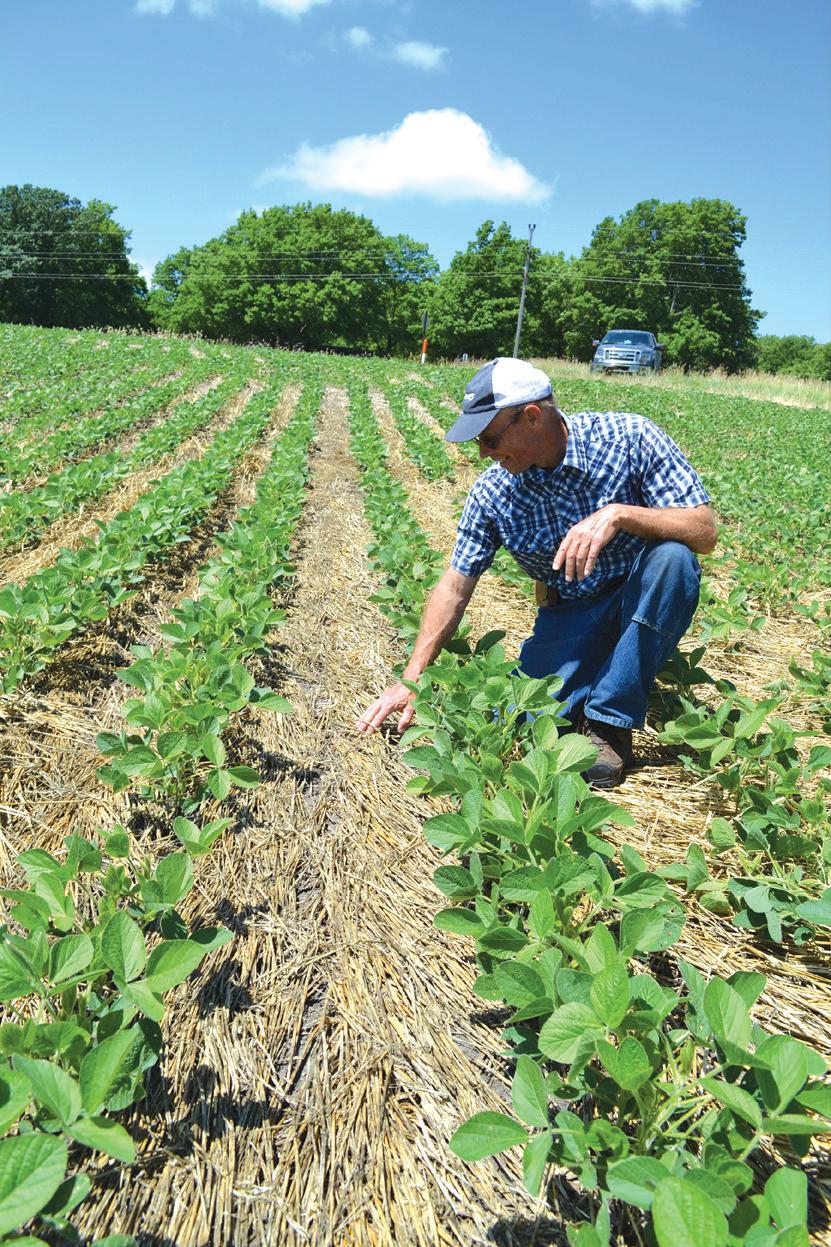
here and there. With a good rain, it will get established, go a bit dormant, and then take off once the corn is harvested, providing cover and living roots well into the fall and through the winter, starting the cycle anew.
Ledermann points out an earthworm midden and pulls off the dead vegetation the invertebrates had started to pull beneath the ground. Despite recent dry weather, the soil is cool and moist. “That’s what the cover’s for,” the farmer says.
He then drives to a field of soybeans,
It’s been well documented that soil healthy methods like cover cropping and conservation tillage often don’t generate immediate benefits, and can even set yields back before they are fully established and build the soil’s self-perpetuating biology. Ledermann mostly has arrangements where he pays direct cash for the lease. But he also has one situation involving a “cropshare” lease where he splits the income with the landowner when the crop is sold. When trying a new method that may impact yields negatively, Ledermann has actually offered to take a lower share of the income gener ated by a cropshare arrangement. He knows building soil health has long term payoffs, but he doesn’t want the landowner’s shortterm view of such practices to be soured by a smaller payout at harvest time.
Renting It Out Right, see page
…Renting It Out Right, from page 22 mann did lose some land he was renting when another farmer outbid him. But even if he can’t control how soil he used to man age is taken care of in the future, maybe the example he set will make a former landlord more mindful of the importance of steward ship practices. Not that it would be easy to see soil he’s stewarded plowed up.
“If I try something different and I feel what I tried cost you some yield loss, then I will make sure that it’s right,” he says.
In fact, the farmer sees part of his role as someone who’s educating landowners on the long-term benefits of soil health, no matter who’s farming their land. That’s an impor tant attitude to have, given that he’s renting land without long-term, written contracts. That can be risky — a few years ago, Leder
“That will bother me,” the farmer concedes. “But my philosophy is if I can improve that field while I’m farming it and well, I lose it, it’s still better for it.” p
On episode 295 of LSP’s Ear to the Ground podcast, John Ledermann talks about the importance of basing his relationship with landowners on good soil stewardship: landstewardshipproject. org/podcast/ear-to-the-ground-295-patch work-quilt-stewardship.
Creating a rental agreement based on soil health and stewardship practices requires good communication on both sides:
For Farmers:
4 Acknowledge innovation may involve failure, or at least delayed benefits: John Ledermann has one rental agreement based on a cropshare, where he and the landowner split the income from a particular crop. While experimenting with a new technique, Ledermann offered to take a lower portion of the share, since he assumed in the near term there would be a reduction in yield.
4 Provide background on the technique: If you are proposing to try a new technique such as cover-cropping or no-till, reach out to the landowner to explain why this will benefit you, as well as why it may be advantageous to the long-term care of the land. Prepare them for the fact that even though their fields may not look as picturesque as their neighbor’s, there are long-term benefits to building soil health. “The fields, especially in early spring, just don’t look as groomed and neat,” says Ledermann. A way to introduce a landowner to the world of soil health is to invite them to a field day or workshop put on by the Land Stewardship Project or some other regenerative agriculture group or natural resource agency. Check LSP’s web calen dar for details: landstewardshipproject.org/ upcoming-events.
4 Start small: If the landowner is a retired farmer, they are likely going to be fully onboard with innovative practices…or very skeptical. “They probably aren’t going
to be in-between,” says Ledermann. If they’re skeptical, starting small and gradually building on early success can help seal the deal. “Don’t start out with a 100-acre field and put it into cover crops the first year,” he suggests.

4 Consider the landowner’s motivation:
Is the owner of the farm just renting it out for as much money as possible, or are they interested in seeing it taken care of in the long-term? Are outdoor endeavors like hunting and fishing important to them? “If you’ve had a long-term
relationship with the landowner, that’s going to make it a lot easier to know where they’re coming from,” says Ledermann.
For Landowners:
4 Ask questions: Farming practices that build soil health, like any innovative system, can be full of confusing jargon — “planting green” and “interseeding” are just a few examples. Ask your renter or potential renter how and why they use certain practices, or don’t use them.
4 Understand the challenges: Adopting a new practice can be financially risky for a farmer. Is there a way you can remove some of that risk while providing a stewardship incentive by, for example, reducing the rental rate on acres that are cover-cropped?
4 Provide long-term stability: Multiyear leases help provide a farmer the stability and incentives needed to invest in practices that build soil health in the long-term.
4 Get educated: The Internet is full of information on soil health. Much of it is tar geted at farmers, but there are also YouTube videos, podcasts, and fact sheets that are accessible to the general public (see sidebar below). In recent years, more non-farming landowners have been showing up to LSP soil health events to network and learn.
4 Become aware of what support is available: There is an increasing amount of cost-share funds and technical support avail able through the USDA’s Natural Resources Conservation Service or local Soil and Wa ter Conservation Districts. Environmental groups are even providing money for putting in certain soil health practices. Check with your local USDA office or LSP about how to get started in the application process.
The Land Stewardship Project’s “Co nservation Leases Toolkit” includes fact sheets, sample leases, and other resources for farmers as well as non-farming landowners who are interested in developing rental arrangements that build soil and ensure stewardship of the land in the long-term. Check it out at landstewardshipproject.org/conservation-leases or contact LSP’s Robin Moore at rmoore@landstewardshipproject.org, 320-269-2105.
During the 2022 growing season, farmers, agronomists, econo mists, and market analysts agreed on one thing: the cost of planting a crop like corn was the highest it had been in decades, perhaps ever. And 2023 isn’t looking much better. A lot of the blame for this pricey crop lies with the high cost of supplying fertility to plants these days. Natural gas is used to make fertilizers such as nitrogen, and the war in Ukraine, along with other factors, has disrupted the production and transportation of this fossil fuel. By September, fertilizer costs were running between $240 and $270 per acre — the previous high had been $140, according to Jason Ward, a commodities analyst with Northstar Commodity. “Anybody who makes fertilizer is seeing profitability,” Ward told the Star Tribune newspaper in September.
Unfortunately, for most farmers, “making fertilizer” is not considered part of their job description. Crop producers usually purchase their source of fertility from manufacturers and dis tributors. As a result, the University of Illinois estimates that the “break-even” price — the price farmers need to cover their costs of raising a crop — will be near $5 per bushel for corn and $11 per bushel for soybeans in 2023. Headed into the 2022 harvest, the price being paid for both commodities was high enough to cover that break-even and produce a nice profit. But, as any farmer knows, commodity prices can be extremely volatile. Between 2001 and 2021, the price paid for corn on the Chicago Mercantile Exchange at harvest ranged from $2.08 to $5.37 per bushel, with an overall average of around $3.82.
The stranglehold purchased fertilizer has on the ability of farmers to make a profit was a prime topic of conversation during the Land Stewardship Project’s 2022 field day season. Farmers shared various meth ods they have for taking more control over their soil’s productivity and not being at the mercy of geopolitical upheavals or decisions made in corporate boardrooms. Some are using cover-cropping and no-till to build
the kind of soil biome that is not as reliant on outside inputs of fertility and that keeps those nutrients from leaking off the land as waste products; others are stepping off the row-cropping treadmill completely and tran sitioning corn and soybeans into perennial grazing lands, relying on four-legged bio reactors to complete the nutrient cycle. Still others are combining enterprises that at first blush may appear to have little in common — rotational grazing and vegetable produc tion, for example — to increase their return on investment and reduce risk. Finally, a lot of excitement is being generated by the idea of utilizing a cutting edge composting
steel ring that had been pounded into the ground and filled with water as part of a soil infiltration test. After some 25 minutes, the water showed little sign it was going to soak into the hard, crusted soil. Holthaus gave up watching and looked over across the drive way at a 25-head cow-calf herd grazing a di verse stand of cover crops in a 12-acre field. During an earlier infiltration test in that field, water took just a few minutes to soak in.
“That’s why I’m doing what I’m doing,” said Holthaus as he walked away. “I want to be able to capture the sunlight and infiltrate the water.”
And as he explained during an LSP pas ture walk he was hosting that day, capturing those resources and turning them into pro tein is a key way he’s transtitioning his fam ily’s northeastern Iowa farm from row- crops to perennial pastures. That 12-acres had been growing only corn and soybeans for the past 40 years, and this focus on limited diversity had taken its toll in the form of compacted, erosive soil.
In the fall of 2021, Scott and his wife, Amanda, seeded a four-way mix of rye, triticale, barley, and hairy vetch on that land. The mix overwintered and the Holthauses started grazing it in mid-May. The bright green of that verdant mix of covered land popped in contrast to the drab browns of all the bare fields in the neighborhood that had been tilled up for the plant ing of corn and soybeans. “Nowhere in nature do you have bare soil,” said Scott as he led the pasture walk participants through the covercropped field while the cattle grazed nearby.

They are using no added inputs to fertilize the soils, and at one point Scott pulled up a hairy vetch plant and counted eight nitrogen nodules on the roots, a sign that one form of fertility was being grabbed for free out of the air.
system to jump-start the soil’s own ability to cook up fertility.
Whatever the approach or the circum stances, it was clear this growing season that many farmers are determined to challenge the narrative that in fact “making fertilizer” is not part of their business model. The next few pages provide a summary of nine field days that prove healthy soil can be the ultimate input. m
On a stormy evening in mid-May, Scott Holthaus stood in a newly planted soybean field staring at a six-inch
The plan was to graze the cover crop mix a couple more times during the summer and then plant more grazing covers for use later in the growing season. The goal is to not only provide cheap forage for the cattle herd, but to build the soil’s biology to the point where it will make a good home for perennial pasture. While Scott concedes he’s just getting started building that field’s soil health, he’s excited to already see reduced erosion and better water infiltration on those acres. Grazing covers also takes pressure off the permanent pastures that are present on the farm.
The Holthauses, who operate their Oak
Digging, see page 25…
Creek Pastures enterprise on Scott’s fam ily’s land, hope to eventually start a similar transition process on the 19-acres of soybean ground across the driveway that’s having problems soaking up moisture. It’s part of their overall plan to create a livestock production enterprise based on perennial, grass-based systems that build healthy soil and cycle water efficiently. They are already direct-marketing beef, pork, broilers, and eggs raised using adaptive rotational grazing and other regenerative methods.
That may sound like a complicated pro cess, given the long-term cropping history of the land and that the soil biome is one of the most diverse ecosystems on the planet, but Scott says what makes it manageable for him is to focus on two basic processes.
“I’m just trying to get the nutrient cycle and the water cycle working on a daily basis, rather than on a three-month annual basis.” m
“This is our mess of a tomato patch,” said Zach Knutson as he led a group of pasture walk participants into a tangle of knee-high grass on a warm evening in mid-July. As people parted the vegetation with their hands, they saw that yes, indeed, there were tomatoes growing there — lots of tomatoes. Knutson added that although the tomatoes aren’t producing the kind of king-size fruit that wins blue ribbons at the fair, this method of production is proving to be economically viable. “If you can get over how ugly it looks,” he said with a laugh.
Knutson and Brooke Calaway think a lot about optimal production versus maximum production. The couple, who are in their mid-20s, make it clear that they don’t see corn and soybean production as the optimal use of the 177 acres they farm near Zum brota in southeastern Minnesota. During the past few years, they have been transitioning row-crop acres to perennial pasture utiliz ing the grazing of cover crops to build soil health and break up pest cycles. They are also establishing a variety of trees in their grazing areas to create a silvopasturing sys tem for their herd of Registered Shorthorns, which consist of 30 cow-calf pairs, along with yearlings.
But perhaps the most striking example of getting optimal productivity out of their land is that tangled tomato patch. During the tour, Knutson and Calaway led partici
pants through five fenced-off, bright green patches that exist in one of their permanent pastures, and in one case, in their barnyard. As the tour participants parted the grasses that had grown up in areas that had been bale grazed the pre vious winter, a riot of peppers, tomatoes cabbages, beets, and broccoli revealed themselves. These vegetable plots are a low-labor, relatively pest-free way to get double the productivity out of parcels of land that normally would only be used for grazing.
While many see stepping off the con ventional corn-soybean path and mixing grazing, vegetables, and silvopasturing as a gamble, Knutson, who works in agricultural risk management, considers this system a safer way to start a farm business. That’s particularly true at a time when sky-high input costs, fluctuating markets, and extreme weather are making commodity crop pro duction akin to taking a spin on the agricul tural roulette wheel.
“Going back to your Ag Econ 101 — optimal production versus maximum production — just because you can produce 300-bushel-an-acre corn doesn’t mean that’s the most productive point to be at,” said Knutson. “You can produce more, but all of a sudden you’re putting in too many inputs and you’re not maximizing profit.”
And it’s at that point the couple bring up another economic term: “opportunity cost” — what one gives up when choosing one alternative over another.
In this case, those vegetables were planted in soil that was already fertile as a result of the nutrients the cattle stomped into the ground during bale grazing. Once they were planted, no time was spent weeding, spraying, or even trellising.
Calaway said that those vegetables are producing at a time — mid-summer — when that ground would be pretty much unproduc tive otherwise. “And in the fall, the cows will be out there harvesting those plants,” she said.
“Our opportunity cost for producing those vegetables is zero,” added Knutson. “We’re not taking anything out of produc tion.”
They planted 256 trees representing over half-a-dozen species in 2022. It will be years before those trees produce shade for the
livestock, as well as marketable products like nuts. But the young couple see playing the long game a much better bet than gam bling on planting annual seeds in a volatile climate and market environment.
“On one of the calls I was on last week we talked about the struggles of the cash grain operations,” said Knutson. “The spring’s too wet, too dry. It’s too cold. Those Goldilocks years are just getting harder and harder to come by. With the volatility comes higher highs and lower lows. It’s great if you can catch those highs…but we’re build ing for stability, not just for us, but future generations.” m
Sometimes an experiment is just an ex periment — and the results generate more questions than answers. That’s the case with a foray into combining organic crop ping with a form of minimum tillage that Mike and Holly Hunnicutt, along with James Koziolek, undertook recently on farmland near Hartland, in southern Minnesota.
As they explained during a field day in late July, the experiment involved utilizing a method called “strip-tillage” to grow organic soybeans. A form of minimum, or conserva tion tillage, strip-tillage involves clearing strips that are approximately six-inches wide in a field that otherwise might have residue from a previous year’s crop covering the soil. The row areas between the strips are left undisturbed.

Strip-tillage provides many of the ad vantages of a pure no-till system: it saves soil, builds organic matter, and preserves moisture, for example. Because it exposes the seed bed to the open air, strip-tillage can help soil warm up faster during cold,
Digging, see page 26…
with how the strip-tilled soybeans turned out. “The soil health was just phenomenal, it was like crumbled cake. I mean there was no compaction or seed-to-soil issues,” Mike ex plained at the field day. The rye sheltered the soybeans and helped them emerge without competition from weeds.
where. It seems like I need to do more research on this.”
wet springs, speeding up germination. It’s a compromise between using the moldboard plow and leaving the soil completely un touched in a 100% no-till system.
But when Mike Hunnicutt started considering strip-tilling organic soybeans, he was told by other farmers it would be a disaster. Exposing even that narrow strip of bare ground would provide an open door for weeds, it was predicted. Since the field is or ganic, the farmers couldn’t spray. And since it was in a minimum-till system, controlling weeds with a cultivator during the growing season was not an option.
“You’re going to have a mess,” Mike re calls being told. But he said he was looking for ways to reduce the number of times he ran equipment across his fields while pro tecting and building the soil. One problem with organic production systems is that they can be heavily reliant on tillage and other forms of soil disturbance in order to control weed pests, and that can result in erosion.
But innovative farming is full of ignored advice and contrari ness. So, during the 2022 growing season, the farmers set up a side-by-side experiment on 120 organic acres. Part of the field was planted in a full, convention ally tilled system with no cover crops, while another was planted to a rye cover crop in the fall of 2021 and then, in the spring of 2022, seeded to soybeans. The standing rye was then “roller crimped”—a system where the plants are flattened with a drum or other device, crimping and killing it without herbicides. Finally, the third treatment involved striptilling soybeans into another section that had a light seeding of rye cover crop from the previous fall growing in it. That cover crop was killed off using a modified version of roller-crimping — the Hunnicutts and Koziolek jury-rigged a rolling barrel stock chopper to make their crimper.
In the end, the farmers were the happiest
The farmers, who are planning on doing an analysis of what it cost to raise a crop under each treatment, say it’s already clear they’ve garnered savings when it comes to time on the tractor cultivating and undertak ing other practices to control weeds.
“Everybody’s time is worth something,” said Mike. “Whether you’re doing one pass across the field, or 10 passes, you’ve got to get paid for something.”
During a tour of the 120-acre plot, field day participants could see the strip-tilled soybeans were thriving, especially after a recent rain. They were also relatively free of weeds, and the dead rye was providing a nice cover between the strips. The part of the field that had been fully tilled and lacked cover-cropping was parched and crusty. The soybeans that were planted into rye and then fully roller crimped were a little behind in growth for late July, but Léa Vereecke, an organic crop consultant for the Rodale Insti tute who has done extensive research on this system of weed control, said roller crimped
The Hunnicutts and Koziolek have enough farming under their belts to know that one successful growing season can’t be relied on to determine how to produce crops far into the future. But this experience has taught them that not listening to the experts can have its payoffs, even when they are tat tooed with question marks. There are plans to possibly repeat the experiment on corn ground in 2023, but there are no guarantees.
As Mike fielded questions about timing of cover crop termination, seeding rates, seed varieties, and pest issues, he made it clear that perhaps the biggest lesson to take away from this experience is to be willing to challenge conventional wisdom — and to not be surprised when things go differently the following season.
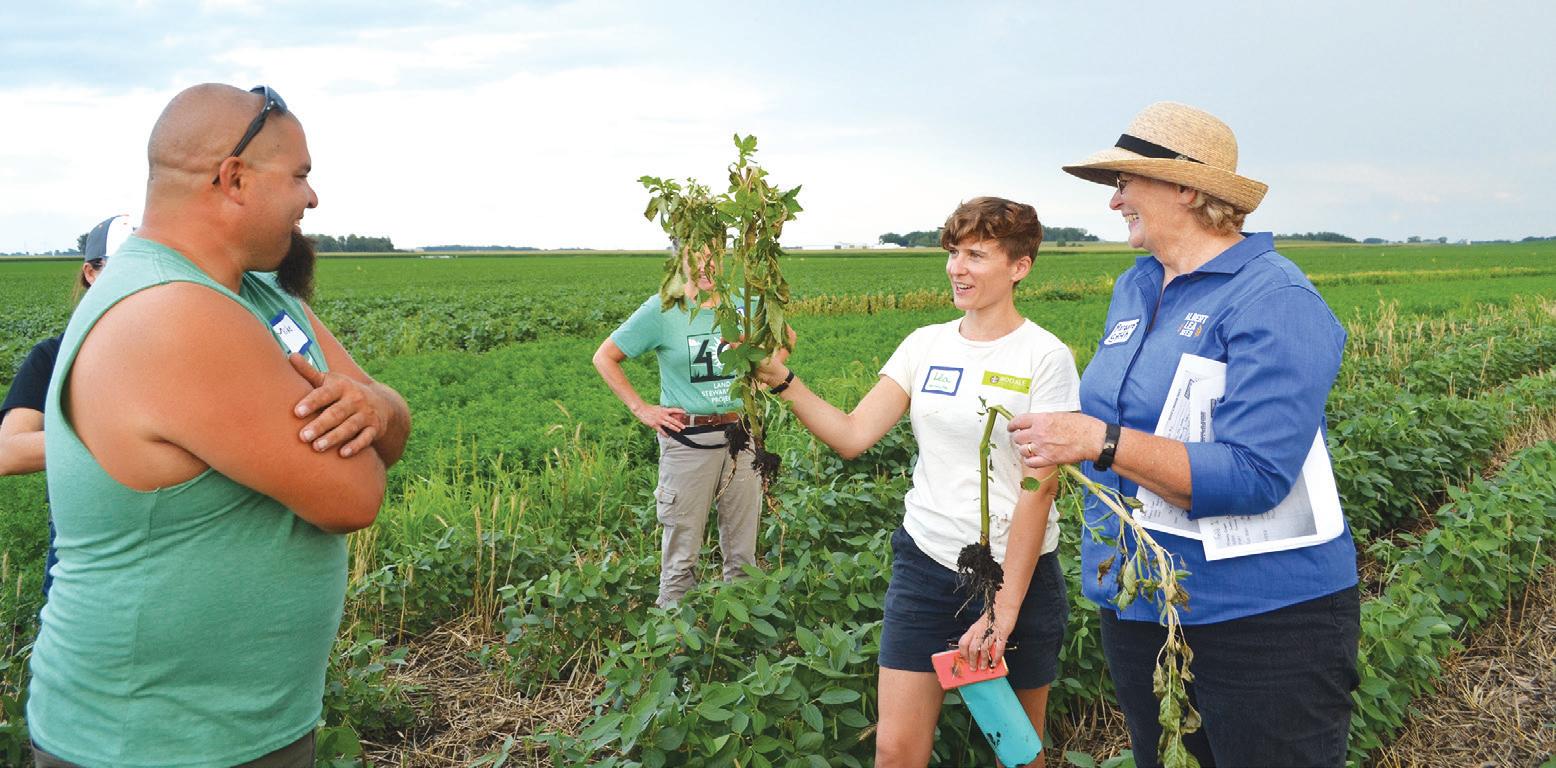
“Now next year could be a completely different story,” said the farmer. m
After taking a mid-morning hike through a recently planted stand of cover crops on the Luke and Holly Bergler farm, some 40 field day participants gath ered in a circle and provided a report on what they observed: earthworm middens, too many insects to count, some compaction, a few bare spots, birds, weeds, and, in a word, diversity.
crops can start out slow, but catch up by August. However, the strip-tilled organic soybeans obviously had her flummoxed.
“So strip-tilling in organic? Hmm,” she said with a laugh. “This is crazy, because bare ground that’s not going to be tilled, it just seems like one of those things that’s never going to work — there will be weeds everywhere. It has to be scientific some
“We need to re-teach ourselves the art and science of observation,” said Allen Williams, a regenerative agriculture expert who does work on farms and ranches around the world with Understanding Ag, a consultancy company. Williams had been brought to this farm in southeastern Minne sota’s Winona County by LSP on a day in mid-August to help teach some of those observational skills.
Luke Bergler conceded at the onset that what he observed on this land when they came here 17 years ago was that decades of tillage had taken its toll in the form of a hardpan at the plow layer, which was producing compacted soils and the inevi
Digging, see page 27…
“Now next year could be a completely different story,” said Mike Hunnicutt (left) of his experiment with strip-tilling organic soybeans. He’s shown here with organic cropping expert Léa Vereecke (white shirt) of the Rodale Institute and Margaret Smith, an agronomist with Albert Lea Seed. (LSP Photo)
table runoff and erosion that comes with it. They attempted to fix the problem with more intensive tillage, to no avail.
“We were just chasing our tail,” he said.
The Berglers began building the soil’s biology by planting cover crops, implement ing no-till, and rotationally grazing their cow-calf herd. These efforts are beginning to show the tail-chasing days are over.
After tabulating what people had ob served in the newly planted cover crop stand, Williams and Luke waded into a 20-way mix of cover crops that had been planted 60 days prior. It was a good fivefeet high, and would provide prime grazing for the cow-calf herd. But Williams was more interested in what it looked like beneath the surface. He spaded up a clump of soil and showed it to the field day participants. The soil was dark, well-aggre gated, cool to the touch, and moist on an 80-degree day. An adjacent cover-cropped stand had been baled up for winter feed after 30 days of growth. A sample grubbed up there showed soil that was crusted, paler, and drier. It was a good illustration of how keeping liv ing roots in the soil for an extra few weeks has tremendous soil health benefits.
“The land does not lie,” Williams said, paraphrasing famed soil conservationist Wal ter Lowdermilk. “The shovel does not lie.” Another thing that doesn’t lie is water — its movement says a lot about how the land is being treated. Luke walked over to a stand of corn bisected by a grassed waterway, a sign that these fields are vulnerable to wash ing. The Berglers have been experimenting with 60-inch corn — a system where instead of planting corn every 30 inches, a gap is left every-other-row. The seed population was doubled in the existing corn rows to maintain overall productivity of the field.
In those un-corned gaps was planted a cover crop mix of brassicas, annual ryegrass, flax, and buckwheat. The extra solar energy reaching the cover-cropped rows increases the amount of forage available for cattle grazing after corn harvest — all while build ing soil health. Luke says such a system greatly boosts the potential income off the same patch of ground, although he concedes he hasn’t found a way yet to put a direct dollar figure on the benefits of building soil health. That doesn’t mean there aren’t other
ways to measure success.
“A few years ago this waterway, after a two-to-three-inch rain, would be full of silt,” the farmer told the field day participants. “I cleaned thousands of tons of soil out of these low areas. Now it can take several inches of rain to see water running down that water way, we’re infiltrating so much.” m
Aday after the Bergler event, Allen Williams was back out in the field, wielding his heavy-duty shovel. This time it was on a steep, Driftless Area hillside at the Rachelle and Jordan Meyer farm in
was tilled and planted to corn. In 2020, after soybeans were taken off in the fall, the Mey ers seeded rye. After the rye overwintered, they grazed it during the spring of 2021 and in mid-April seeded a pasture mix of perennial species like fescue, orchard grass, red and white clover, and birdsfoot trefoil. They used USDA Environmental Qual ity Incentives Program funding to set up a rotational fencing and watering system for their livestock.
By the time of the field day, they had been using adaptive grazing on the field for less than two years, carefully adjusting their stocking rates and rest periods. Jordan said when they first started grazing it, the field’s soil was“lifeless” as a result of no animal ac tivity for so many years. Cow pies routinely sat on the surface without being bro ken down — a sign of low biological activity. But he and Rachelle now feel it’s come back to life, producing a good stand of forage for their animals while soaking in and managing water.
“How bad have we been lying?” Rachelle asked with a laugh after Williams’ gave his “the shovel doesn’t lie” talk and began grubbing up a soil sample. Actually, Williams said, he counted 17 different species of perennial forages in the short walk through the paddock; he guessed there were 30 or more in total. The Meyers didn’t plant anywhere near 30 species, but they did prime the biological pump via their manage ment, allowing the latent seed bank of perennials to get activated.
far southeastern Minnesota, near the Iowa border. During the past few years, the young couple has converted hundreds of acres of highly erodible crop ground into perennial pastures, which they use to raise beef, goats, and chickens for their direct-to-consumer meat business.
Williams is a big believer in using an nual cover crops as a biological primer — a two-to-three-year transition where the covers help serve as a link between an annual, monocultural system characterized by intense tillage and chemical use, and a deep-rooted, biodiverse, perennial pasture. Sometimes that transition period can be surprisingly fast when it taps into some of the hidden natural processes lurking beneath the soil. That appeared to be the case on one particular field featured at the Meyers’ event.
As a steady downpour started to let up, the field day participants followed the young couple and Williams into the pasture, which had been idled for 25 years under a Conser vation Reserve Program contract. In 2019, it
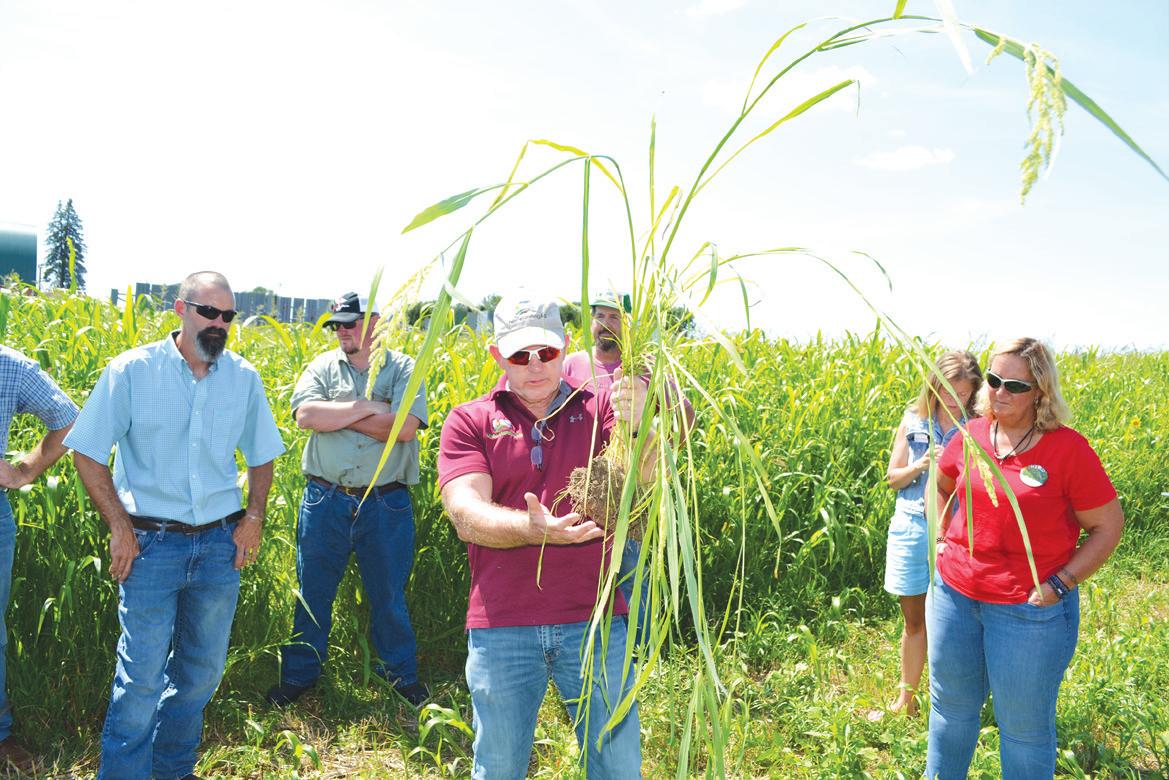
“Nature also played a role here, but you had to create the conditions through management for the latent seed bank to respond, and it did,” said Williams. “This is the power of biology. This is an exponential effect, not a linear one.”
While holding the soil sample, Williams pointed out the diversity of roots, lack of surface crusting, lots of bugs, and the soil’s dark, carbon-rich color.
“I really, really like what I’m seeing here,” he said as he gave the sample a sniff. Williams, who has a doctorate in animal science, said he was particularly impressed with the quick progression this soil has made, given that when he was in academia he used to teach students that soil improve ments like this would take 100 years or more. “Less than two years is radically fast progress,” he added as the farmers gathered around applauded.
However, there was room for improve ment, Williams pointed out. Further down in the soil profile there were signs of compac
Digging, see page 28…
…Digging,
tion caused by years of moldboard plowing, and the color got lighter at depth, a sign that carbon had not yet been built deeper in the ground.
“So, good job,” Williams said with a laugh as he pointed at the part of the profile where the soil’s quality was dropping off, “to here.”
“Give me another year,” said Jordan. m
When dairy farmer Dale Pangrac first heard microbiologist Elaine Ingham speak about what she calls the “soil food web,” he got extremely excited about the message she conveyed: soil has the ability to generate its own fertility and resistance to pests. That message resonated with Pangrac so strongly that he didn’t buy fertilizer for the next growing season.
“That was a disaster,” he said during a field day in late August on his family’s organic farm near Lewiston, in southeastern Minnesota. “But I’ve learned a lot since.”
What Pangrac has learned — from Ingham and others — is that in order for soil to become self-sufficient, a whole lot of damage has to be undone, biologically and structurally. Over a century of tillage alone has decimated soil’s aggregate structure, and the post-World War II agri-chemical revolu tion nuked its natural processes.
“Our soil has basically lost its biological function ality,” molecular biologist David Johnson told the more than 60 farmers, natu ral resource professionals, and others who gathered in the Pangrac family’s cav ernous machine shed. The good news is that the focus of the field day was how that biological functionality can be restored. Johnson, along with his wife, HuiChun Su Johnson, de scribed how a cutting-edge composting system they’ve developed can jump-start soil’s biological activity and, indeed, help it generate its own fertility.
Their method is called BEAM (Biologi cally Enhanced Agricultural Management) and centers around the fungal dominant bi ome created using the Johnson-Su Bioreac tor. Invented by the Johnsons, the bioreactor system represents a radical departure from the traditional way of taking organic mate rial and breaking it down into a source of fertility via composting. Rather, the inocu lant created by the bioreactor system acti vates the soil’s innate biological functions — akin to a baker introducing yeast to bread dough — giving rise to a chain reaction of ecological activity that eventually results in more nutrients for growing plants.
Traditional composting relies on frequent turning of the waste material to keep oxygen flowing and thus prevent the material from becoming anaerobic. This greatly reduces the timetable for producing a finished product, which can be an excellent source of fertility for soil. The disadvantage to such a system is that it demands lots of labor during the breakdown process, and, if done on farm scale, can be infrastructure inten sive, requiring turning equipment and lots of room for windrows. One big advantage to the Johnson-Su system is that it’s scalable. A bioreactor stack can be set up for less than $50 using lo cally available materi als like wire mesh and landscape fabric.
According to research by the John sons, the bioreactor system shows great
promise for triggering healthy soil functions in a variety of farming situations, producing greater crop yields and more carbon seques tration, for example. However, most of that success has occurred in climates similar to that found in New Mexico, where the couple lives and works.
Since the summer of 2021, LSP has been working with the Pangracs and four other farmers — four in southeastern Minnesota and one in Wisconsin — to study if the Johnson-Su system will work in the Upper Midwest. Through this project, which is being funded by a grant from the Minnesota Department of Agriculture’s Agricultural Growth, Research, and Innovation Program, farmers are experimenting with ingredients that can be found on local farms, such as livestock manure, forage material, forest soil, and wood chips.
David Johnson made it clear during the field day that the bioreactor system is not creating a direct source of fertility. Rather, it’s setting the stage for the soil’s microbes to build natural productivity.
“What we’re doing is creating a feedback loop,” he said. “This planet is what it is because of microbes.”
The Pangracs are using it as part of an integrated system of building soil health that includes managed rotational grazing of their dairy cows. Other farmers who attended the event described utilizing it in conjunction with cover cropping and no-till systems.
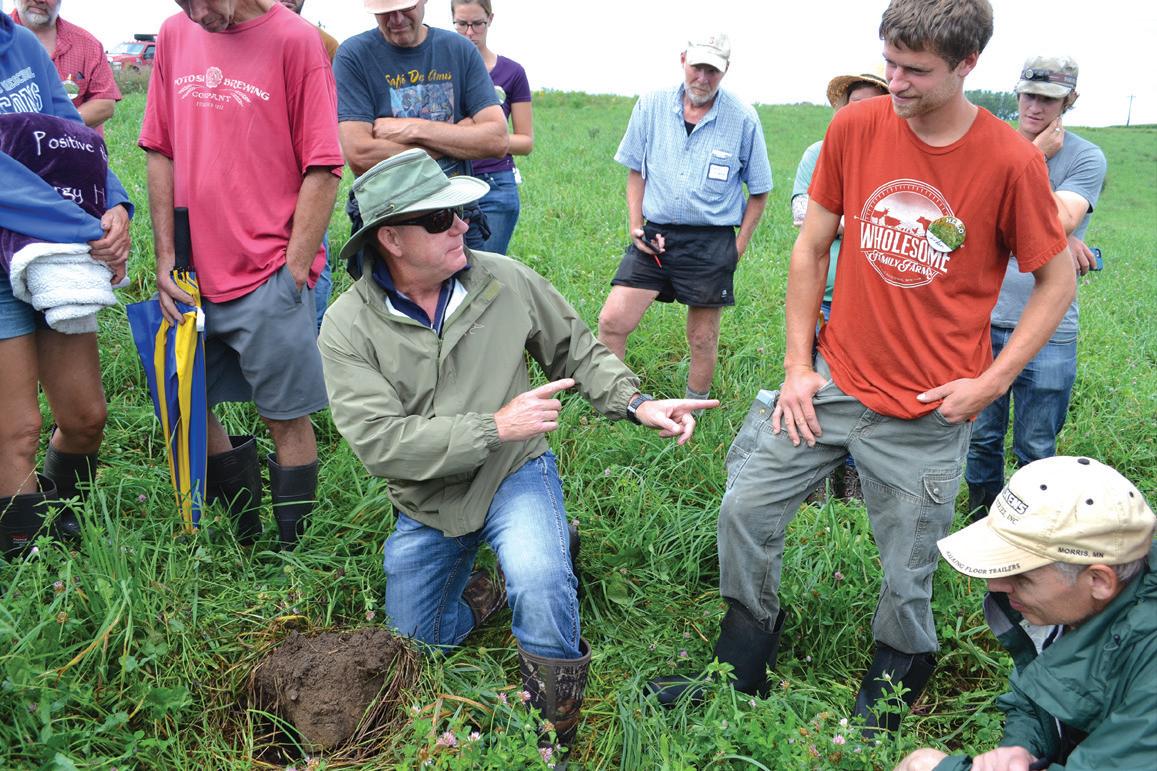
That’s important, said Hui-Chun Su. Add ing a compost extract is not a silver bullet to bringing soil back to life — it works best if dovetailed with other soil health methods, she said. It also requires sharing information at events like this.
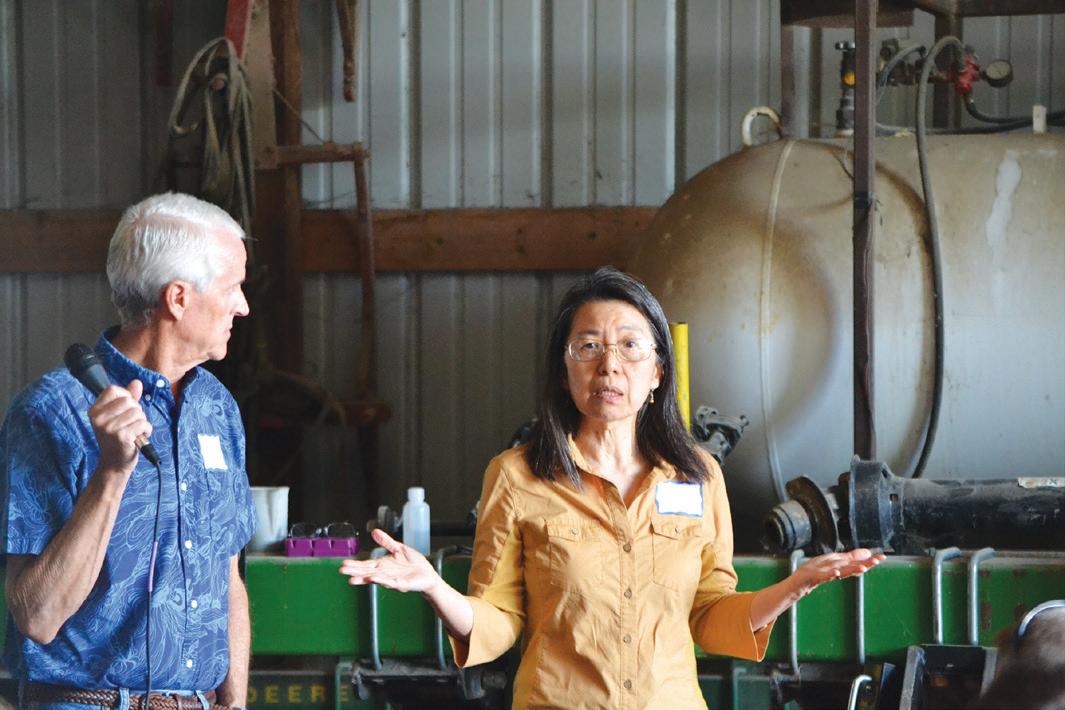
In fact, during the field day participants asked questions about everything from the
Digging, see page
“Give me another year,” said Jordan Meyer (red shirt) of efforts to bring a field back to life. (LSP Photo)
“Your farm is an ecosystem — you have to adjust in each case,” said Hui-Chun Su Johnson, shown here with her husband, David. (LSP Photo)
…Digging, from page 28
equipment used to apply the compost ex tract, to the role of plant diversity and cover crops in building fungal life.
“This is a kick-starter,” Hui-Chun Su said. “Your farm is an ecosystem — you have to adjust in each case.” m
When Everett Rolfing realized 13 years ago that he needed a way to keep soil from washing off his southeastern Minnesota crop farm, he was absolutely certain of one thing.
“I knew no-till would not work for me,” he told a group of two-dozen other farm ers who were gathered in his immaculate machine shed for an LSP field day in early September. “I was full tillage — the soil had to be totally black.”
Rolfing had heard all the knocks against no-till: it won’t work on the kind of clay soils found in his part of Winona County, weed control and fertilizer incorporation are difficult, it would prevent the soil from warming up in the spring. But he was a bit desperate. When the farmer had sold his dairy cows as a result of bad knees, he knew that a major bovine feed, alfalfa, which at one point covered half his farm, would no longer be part of the rotation. That was a problem, because this perennial forage is
very good at keeping soil in place, and Rolf ing is mindful of soil loss on his farm, which is considered highly erodible.
“I’m on the township board and this May we had places where guys had to go out with loaders and scoop their dirt out of the road ditch,” Rolfing recalled of the aftermath of an intense set of rainstorms in the area. “We had culverts that were plugged.”
So, he gave no-till a try, and after a few hits and misses, his 550-acre corn-soybean operation is now 100% no-tilled, or, as Rolf ing concedes, at least minimum till, since he does do some light tillage with a vertical tiller. And for the past three years, all of those acres have also been protected during the shoulder seasons by a rye cover crop. Each spring, he plants his cash crops straight into the standing rye — a method called “planting green.” The rye is then terminated with herbicide, creating a thick mulch that protects and feeds the soil.
“When you terminate that rye, it takes it two to three months to disintegrate into the soil,” he said. “I feel it’s very well worth $14 an acre for that cover crop seed when I consider the benefits I’m getting out of that rye: erosion control, weed control, and soil biology build-up.”
But Rolfing warned that increased soil biological activity does not come immedi ately. In fact, after years of conventional tillage, he found his soils were pretty much lifeless and unable to break down residue from previous year’s crops. But he took the field day participants across the road to a stand of soybeans that was just a few weeks from harvest. The soil between the rows was absent of residue from last year’s crop, as well as the rye cover crop — a good sign of active biology.
Rolfing recommended taking it slow, and not going 100% on no-till or cover crops. But once the soil’s aggregate structure gets reclaimed, the payoffs can be significant, said the farmer. His erosion is next to non-existent, and in recent years it’s been the soil health benefits that have impressed him the most. His fields work nicely during planting, weeds are under control, his yields are good, and he can see “15 to 18 earthworms per shovel full of dirt.”
And that’s money in the bank. Rolf ing is a crack mechanic, and works on a lot of other area farmers’ tractors. That makes him mindful of what it costs to run machinery on the land.
“When I was full tillage, I never made the money I’m making now. My diesel fuel use is approximately 40% of what it used to be, which means less hours on the tractor, less oil changes, less man hours,” he said while sitting near a tractor he had
Check out these Ear to the Ground podcasts to hear Land Steward ship Project field day hosts and presenters discuss the role soil health can play in profitable, resilient farming. Episodes can be found at landstewardshipproject.org/ ear-dirt.
4 Episode 255: Embracing the Weed
4 Episode 274: From Dirt to Diversity
4 Episode 276: Why Regenerative Ag?
4 Episode 277: 3 Regenerative Rules
4 Episode 278: It Can Happen Anywhere
4 Episode 279: We Are What We Eat
4 Episode 280: Maximum vs. Optimal
4 Episode 286: Tractor Seat Economics
4 Episode 287: Opportunity Knocks
4 Episode 288: More with Less
4 Episode 289: Reflections on a Revolution
4 Episode 290: Silt Suppression
4 Episode 291: Shovel Doesn’t Lie
4 Episode 292: Working the Microbes
been working on. “When the tractors aren’t in the field, you’re making money.”
If Rolfing can be convinced of the ef ficacy of a practice like minimum tillage, then maybe a lot of people can have their eyes opened. Later in the day, Robb Miller, a dairy farmer just down the road from Rolfing, showed the field day participants a thriving stand of soybeans he planted after taking off a triticale cover crop for cow feed. He originally started planting cover crops 15 years ago to control erosion and scavenge excess nitrogen. Now it’s providing good feed value for his herd.
“It is by far some of my most profitable acres,” Miller said of the triticale-cash crop combination.
Miller reported that some of the area farms that had the worst erosion during the May rainstorms are now planting cover crops. Another reminder that erosion control can serve as a launching pad for a galaxy of other benefits — economical and ecological.
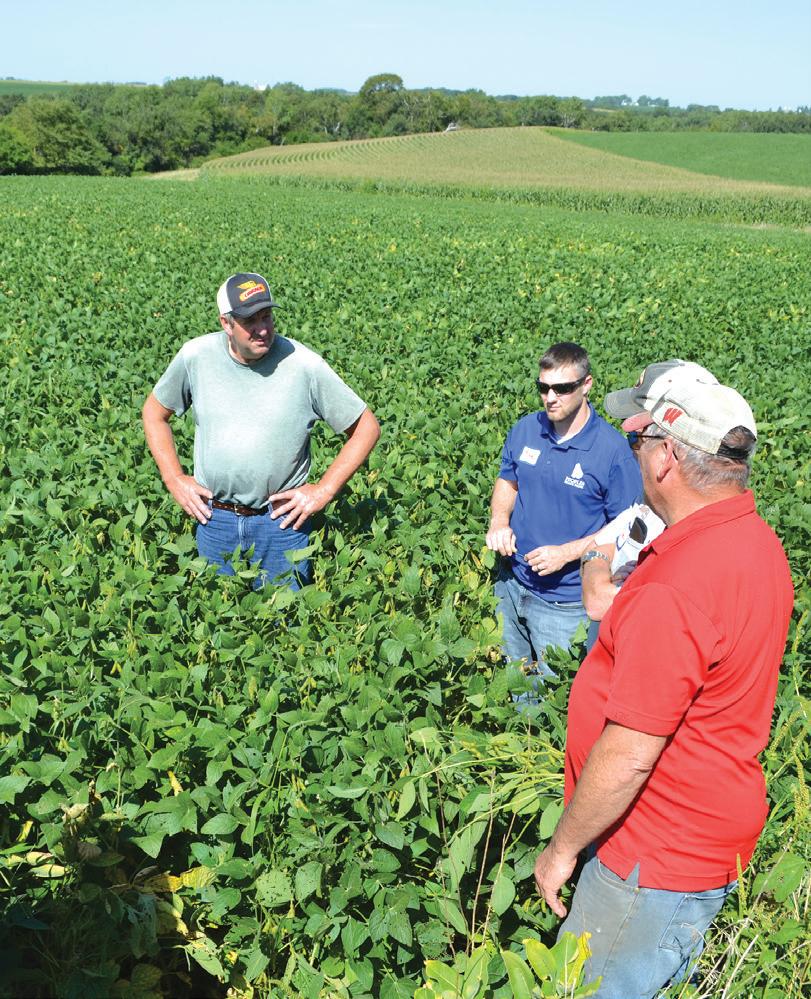
“So there’s hope,” said a farmer as he walked back to his pickup truck. m
Digging, see page 30…
JoeLawler is an accountant by trade, so, like Zach Knutson and Brooke Calaway, he thinks a lot about the concept of “opportunity cost.” But his passion is farming in a way that leaves the land better for future generations. “The accountant side is on one shoulder, and the spiritual side of taking care of the land is on the other,” he said on a recent afternoon in late September. But, he adds, “We can find a happy medium in-between.”
On that particular day, he showed partici pants in an LSP field day being held on his family’s farm near Rochester, Minn., a per fect example of that balance being struck. It was in the form of a 40-acre patch of prime pollinator habitat growing between stands of corn and soybeans. Lawler explained that this was part of a program he enrolled in through the USDA’s Natural Resources Conservation Service.
Through the program, he was given an annual payment of roughly $330 an acre for two years to grow a mix of species that ben efit bees and other pollinators: buckwheat, sunflower, red clover, dwarf essex rapeseed, and multiple clover species. As part of the deal, Lawler has been monitoring the patch of ground and noting how many bees are using what plants.
“It’s been just blooming with bees — and pheasants and deer,” he said.
But it’s also been providing something else for the farmer: healthier soil and the build-up of fertility via the nitrogen-fixing clovers. And that’s where the practical side shoulders in. The two-year contract expired in 2022, so next spring he will plant the field to a crop of corn that will be eligible to be certified organic.
Lawler calls using a program like this a “game changer,” given that transitioning to organic can come with a lot of overhead expenses. “I’m not trying to garner profit during these two years, I’m just trying to cover expenses,” he said of the transition. “We may miss out on opportunity cost those two years the 40-acres is in bee habitat, but in the long term what the farm gains from the pollinator habitat soil health-wise more than makes up for it.”
The Lawler farm is full of these kinds of calculations. Part of the reason is that Joe, along with his father, Steve, and uncle, Tim, are farming in the Silver Creek watershed, and any runoff from that area impacts drink ing water quality in Rochester.
“We take what comes off the farm very seriously,” said Joe. “We’d rather it go into the soil.”
That’s why they utilize methods that build soil health as much as possible, such as no-till and cover-cropping. They have also devoted 30 acres of the around 600 acres they farm to University of Minnesota research. During the field day, U of M re searchers showed plots devoted to studying cover crop seeding rates and termination methods, as well as corn silage production and small grains. A long-term nitrate study, which has significant water quality implica tions, has also been done here.
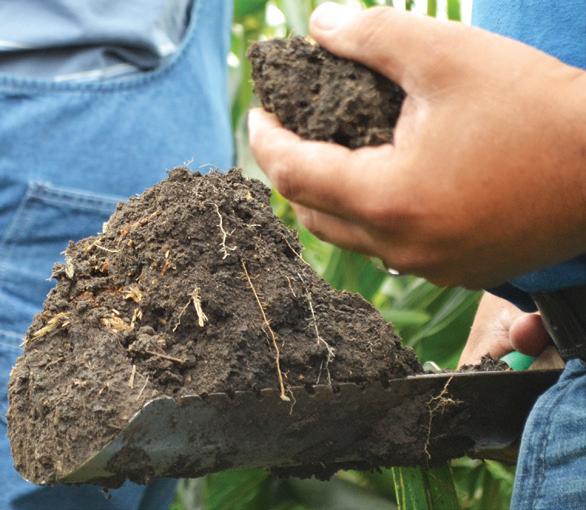
According to the 215 Soil Builders’ Network farmers and landowners who responded to the Land Stewardship Project’s 2022 acreage survey:
4 13,200 acres moved into reduced or notill practices since January 2020.
4 11,200 acres moved into cover crop practices since January 2020.
4 5,200 acres moved into rotational grazing since January 2020.
4 14,000 acres have seen a reduction in the use of synthetic fertilizer and chemical use since January 2020.
Altogether, 800 participants, primar ily farmers and landowners from across southern/central Minnesota, northeastern Iowa, and western Wisconsin, were reached
Joe Lawler (left) thinks a lot about how to strike a balance between environmental and economic sustainability. “The accountant side is on one shoulder, and the spiritual side of taking care of the land is on the other,” he said. (LSP Photo)
The Lawlers — Steve is a resource specialist with the Mower County Soil and Water Conservation District — like to ex periment on their own as well. For example, they showed a stand of corn that just a few weeks before had been interseeded with a cereal rye cover crop. The seeding had taken well, and the rows were bright green, just as the corn was starting to lose its color as harvest approached. Joe applied the seed with a “high-boy rig” — a machine with tall wheels that had, in a previous life, been used to detassel corn in Canada.
After he bought it, Joe modified it in a “Frankenstein manner,” as he puts it, to seed cover crops before harvest. Because of weather and timing issues, farmers in the Upper Midwest often have a hard time getting cover crops established after harvest.
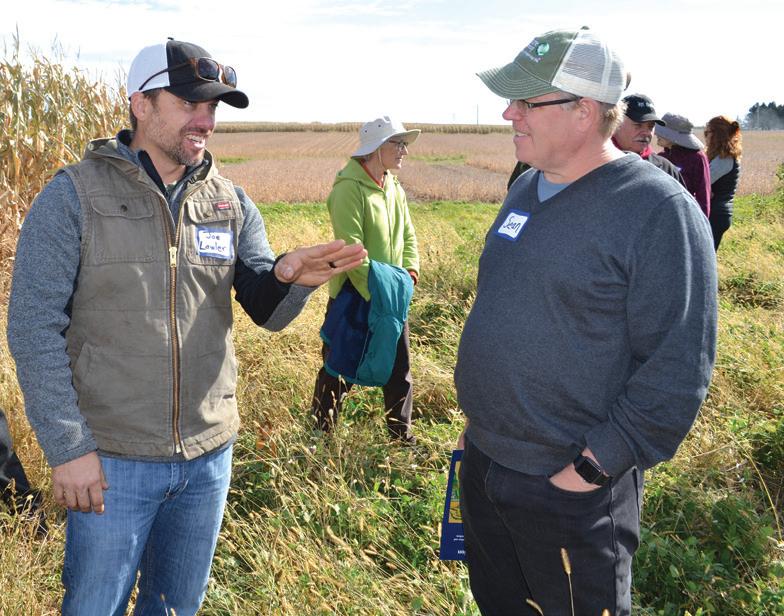
Digging, see page 31…
through LSP’s soil health programming and partnering efforts during the spring, summer, and fall of 2022.
Interested in profitable ways to build soil health? Join hundreds of other like-minded farmers, natural resource professionals, and others in the Upper Midwest by becoming a member of the Land Stewardship Project’s Soil Builders’ Network. Members get regular updates on workshops, field days, and onfarm demonstrations, as well as the latest soil health and cover crop research.
For more information on joining, see the web page at landstewardshipproject.org/ soil-health or call 507-523-3366.
Interseeding before harvest can take the pressure off come October and November.
Two-and-a-half miles of new perimeter fencing was another example of balancing water quality protection with practical farm ing. The Minnesota Department of Agricul ture’s Water Quality Certification Program covered three-quarters of the cost of the fencing. The Lawlers were able to success fully make the argument that the fencing would improve water quality by allowing them to integrate Steve’s beef herd into more acres on the farm via rotational grazing. The careful animal impact can build soil health, while providing an economic incentive to raise cover crops and perennial forages that can be grazed.
“It really brings life back to the soil,” said Joe of the animal impact.
And life in the soil is long-term opportu nity gained. m
“Yield used to be king. Quit look ing at yields.” That was one of the first things Tom Cotter said during the opening session of a field day on his Mower County, Minn., farm in mid-September. That may as well have been the title of the entire event, which was sponsored by LSP, the Minnesota Soil Health Coalition, Superior Cannabis Company, Albert Lea Seed, and the Nature Conservancy. Cotter, along with guest speaker and soil health pioneer Gabe Brown, spent the rest of the day persuading the 150 farmers and others who attended the
event to focus less on gross profit gener ated by bin-busting yields, and more on net return. And such an approach to accounting should be fueled by a close examination of just how much it’s costing to produce each bushel of corn or pound of beef.
“As farmers, our profits are based on our ability to cycle solar energy,” said Brown, whose North Dakota crop and livestock operation has become a showcase for profit able, regenerative agriculture. “Farmers and ranchers aren’t deficient in nutrients — they’re deficient in biology.”
That message — a myopic, reductionist focus on yields while ignoring soil’s innate potential to generate food and profits — was driven home again and again during the field day. It was made clear during an opening presentation in Cotter’s machine shed, and again while looking at soil samples in a stand of sweet corn or checking how bale grazing had set the groundwork for a thriv ing stand of sunflowers.
Cotter raises organic and conventional crops, along with grass-finished beef, on 795 acres. He started planting cover crops in 1998, and half-a-dozen years ago adopted no-till. He says rotationally grazing live stock on cover-cropped and pastured acres is what really got his soil biology activated.

And that has resulted in what the farmer calls “lots of less.” Cotter’s low-lying farm is in the Cedar River watershed, and he’s noticing less water ponding, fewer weeds, reduced erosion, and lower fuel and chemi cal bills since practices that build healthy soil were integrated into the operation.
“Human consumption is about more, more, more,” he said. “Just give nature a chance, and the less I put on, the more chance nature has to do its thing.”
But at the last stop of the day, Cotter
showed a field that is actually characterized by “more,” as in more diversity. He had par ticipants wade into a waist-high, 19-way mix of cover crops he seeded in late July. They were sent on a kind of scavenger hunt to see how many species could be identified. It was a bit overwhelming — it turns out sun hemp stumped almost everyone. Cotter’s goal was to graze it in the fall, providing economic value via the cow-calf herd. But the im mense diversity of the mix, both below and above ground, will also help supercharge the soil’s biology, putting the field in good shape to grow future cash crops.
In a sense, the farmer is “advancing bio logical time” with all this diversity and cut ting years off what it normally takes to see significant soil health benefits, said Brown as he examined the stand. The compound ing power of diversity — something that’s long been shown in prairie ecosystems, for example — is gaining traction amongst farmers who are frustrated with the lack of resiliency in monocropped regimes.
“It would take Tom 19 years to advance soil health on this field with a monoculture of rye,” said Brown.
And it turns out that more of something else is needed if regenerative farming prac tices are to become widespread.
“I talk about community a lot,” Cotter said after the field day. “It’s great to have Gabe Brown here, he does a great job. But realistically you need to find your core group within 20 miles and someone you can talk to five-times-a-week and really bounce ideas off of. And instead of learning one thing a year, I’m learning from 20 different people, so I’m learning twice as fast. It just keeps compounding.” p
As a farmer striving to imple ment soil health principles and other regenerative practices on our small family operation, I am constantly on the lookout for books that expand my understanding of agriculture. Often these are specific, prescriptive, how-to guides, and those are certainly great for providing inspiration and sharing ideas. But they don’t often move me to tears, or fundamentally change the way I look at the world around me. So when I sat down to read Braiding Sweetgrass, by Robin Wall Kimmerer, I wasn’t fully prepared for the ensuing ride.
A SUNY distinguished teaching professor of en vironmental biology and a member of the Citizen Potawatomi Nation, Kim merer weaves together the realms of scien tific research and Native American traditional teachings — worlds that one might find rather disparate at first glance, but which the author shows us over and over are two sides of the same coin. In an interview for the radio program “On Being,” Kimmerer summed this idea up with the statement: “Science asks us to learn about organisms. Traditional knowledge asks us to learn from them.” This concept that we need both perspectives to gain a complete picture of the world and our place within it, I feel, is the central theme through out Braiding Sweetgrass, and is expressed through many examples of how humans exist in concert with all of the other beings on Earth in an elaborate web of relationships and cycles.
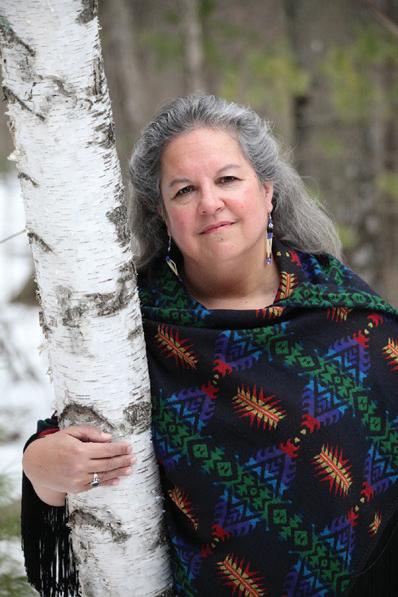
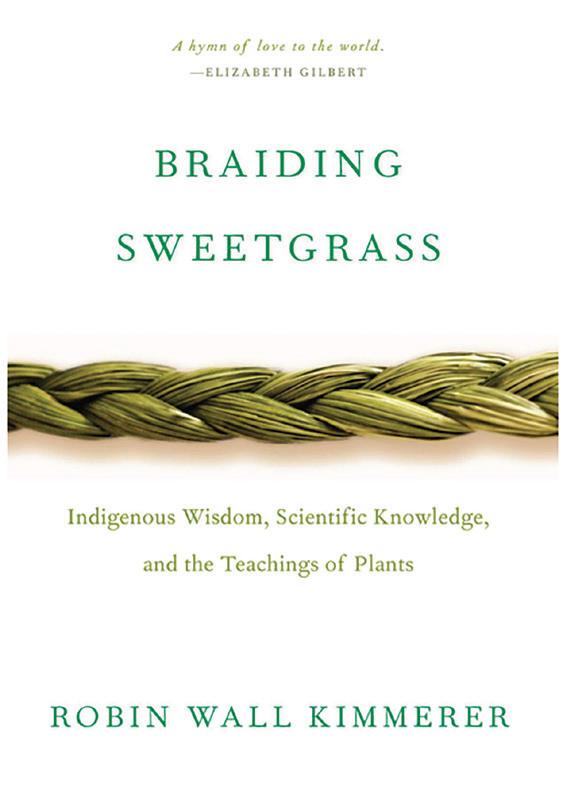
As you might imagine, many relation
ships between humans and other life forms are troubled and out of balance. That said, this is not a dark and gloomy book, but rath er one that approaches these problems with deep introspection and the belief that we are capable of rediscov ering our place in the world and getting it right, should we choose to do so.
Every chapter seems to feature a pro found message, and Kimmerer writes with a viscerally moving and poetic style that is hard to describe. She draws upon her own experiences and family history, indigenous storytelling, and scientific research while combining them all in a way that is akin to a deep personal conversation. She tugs at your emotions, and in doing so she makes you feel as if it matters that you’re reading this book, because somewhere along the way you realize you’re a part of it all.
One chapter that stood out for me involves the author’s efforts to learn her native Potawatomi language. She relates how the nouns are classified in an entirely different way than English. Rather than having a gender — he, she, it — Potawatomi nouns are classified as either animate or inanimate. As such, anything that is alive or imbued with the spirit of life is not a what, but a who. Can you imagine how our relationship to the natural world would change if we acknowledged the living, vital nature of everything from rocks, to water, to fish, to trees, to animals, to soil each time those subjects came up in conversation and in policymaking? By speaking of them as fellow beings, as kinfolk, would we still be able to regard them as mere resources to be harvested?
Reciprocity in our interactions with nature is another theme that Kimmerer stresses over and over again, asserting that we cannot expect the world to sustain us if we take without giving back. The author is an avid gardener (something we have in common), and sees gardening as one ideal version of a reciprocal relationship with na ture. The gardener tends the plants, making sure they have everything they need to grow and be healthy and protected, and in return the plants tend to their gardener by provid ing food and seeds to be planted so that the
cycle can continue. But what if we in troduce the idea of love to the scenar io? To love and be loved in return may be one of the purest forms of reciproc ity, and there are plenty of gardeners who would profess a love of their gardens. But do their gardens love them back? Is that possible?
The author posed the question to a group of her graduate writing students, all of whom expressed a love of nature, the environment, and the Earth. However, when asked if the Earth loved them back, they didn’t know what to say. The idea made them extremely uncomfortable. Why is that? And how would it change the way we each
Robin Wall Kimmerer will help the Land Stewardship Project wind up its 40th Anniversary observance in midJanuary with an evening that celebrates our relationships with the land and with each other. This event will feature live music and a virtual live address by Kimmerer. Kimmerer is a mother, scientist, and enrolled member of the Citizen Potawa tomi Nation. She is the author of Braiding Sweetgrass: Indigenous Wisdom, Scientific Knowledge and the Teachings of Plants as well as Gathering Moss: A Natu ral and Cultural History of Moss es. She lives in Syracuse, N. Y., and is a SUNY distinguished teaching profes sor of environ mental biology as well as direc tor of the Center for Native Peoples and the Environment. As this Land Stewardship Letter went to press, we were still finalizing plans — including the exact date — for this virtual event. For the latest details, check LSP’s website at landstewardshipproject. org/40th-anniversary-events, or contact LSP’s Olivia Blanchflower at oblanch flower@landstewardshipproject.org.

Braiding Sweetgrass Indigenous Wisdom, Scientific Knowledge, and the Teachings of Plants
“Science asks us to learn about organisms. Traditional knowledge asks us to learn from them.”
— Robin Wall KimmererRobin Wall Kimmerer Sweetgrass, see page 33…
…Sweetgrass,
interact with the natural environment if we believed that a relationship of reciprocal love and respect flowed between us and all of the other beings on Earth, and that our ac tions could jeopardize that relationship?
These are just some of the many deep, thought-provoking ideas found in Braiding Sweetgrass
The Seed Keeper, Diane Wilson’s first novel, is a work of deep healing, or really a promise of healing — if only we can respond to the myriad ways she first breaks our hearts.
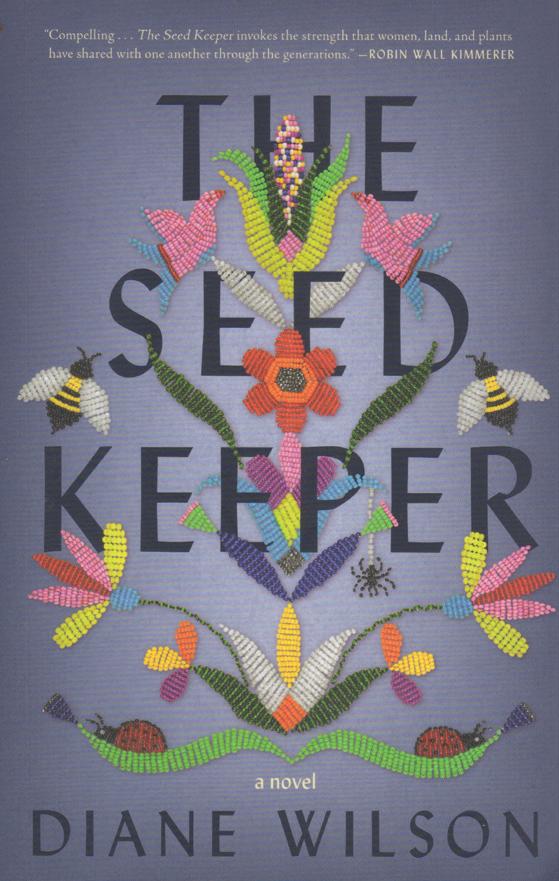
Wilson tells the many stories of violence to this land — the colonial violence decimat ing indigenous families and communities, and the environmental/agricultural violence of monocropped, chemical-laden, corporate agriculture, all through the eyes of orphaned, state-removed, Rosali “Rosie” Iron Wing.
This far-ranging work covers the Dakota Wars, the Mankato mass-hanging of 38 Dakota men — the largest mass execution in the nation’s history — and the removal of Dakota children from their homes to board ing schools. All this created intergenera tional, ongoing, still-reverberating lifetimes of trauma, violence, addiction, and loss. In short, it was a bomb-blast shredding the fabric of Native families.
But in telling these stories of waves of settler-colonial violence, there is a path toward healing. As Wilson writes, “See what happened to the families, especially the children. Go back to the place where our stories were left behind with our ancestors’ bones. That’s where you’ll find our family.”
This directive to “go back” is delivered by 90-year-old Darlene, Rosali’s last surviving great-aunt, who was hidden from the childstealers. Darlene herself is a seed — waiting at a distance, cool and dry, for someone to bring water and light to nurture her story, the story of her family’s, her people’s, resilience and potential to flower once again.
The novel follows Rosali as she first tries to survive her life in foster care after the death of her father when she is 12 in white-dominant Mankato, with a foster
I can’t emphasize enough how impact ful this book was for me. Quite simply, it changed the way I look at the natural world, and inspired me to think more deeply about our decisions and priorities as we participate in our community and manage our house hold and family farm. It is a transcendent piece of writing. I strongly encourage every one to find yourself a copy, and buckle up. p
mother who consigns her to the basement, makes her clean for the family, and takes any money Rosali earns. And, as one of only two Native students in her school, she weathers constant racial harassment and isolation with taunts like “squaw,” and “drunks on welfare.” Her connection to the other Native student, along with memories of life on the land with her father, are the lifelines Rosali needs to survive all the choking-whiteness around her.
Land Stewardship Project member Mike Seifert, along with his wife, Dana, and father, Big Mike, raises crops and livestock near Jordan, Minn., utilizing soil healthy practices like cover cropping and no-till. A recent blog by Mike on soil health is available at landstewardshipproject.org/ cover-crop-roi-all-that-matters.
Wilson reminds us that the seeds for healing and restoration of the people and the land are in fact the same thing.
Rosali seems utterly alone in the world after her father dies, as her mother had died in her early childhood. Her mother’s death was awash in trauma and silence, which caused her father to cut off from the rest of the family. He had raised Rosali in a cabin in the woods, richly populated with all the life of the natural world, but devoid of people.
This leaves Rosali almost wholly alone when he dies, but she slowly learns she can never be really alone on this land, her ancestral home where the seeds of her people and the plants that sustained them are waiting still. Always there, just below the frost line, beyond the tree line, they await her return.
But not all the children were taken by boarding school violence, just as not all seeds have been lost to drought, settler colo nial war, or Monsanto’s chemical violence. And in this rich work, Wilson points the way through Rosali’s voice: “Maybe we all carry that instinct to return home, to the horizon line that formed us, to the place where we first knew the world. Maybe it was that instinct driving me now.”
After Rosali, at 18, works for, then mar ries, a young white farmer after he shows her the tiniest bit of kindness, she raises a child with him, then loses her husband to cancer, likely the result of the chemicals he farmed with. She also nearly loses her son to the deepprofit promises of corporate agricul ture, and then in a wave of loss and grief, returns to the tiny cabin in the woods, where slowly, slowly, the land and reconnection to family and community restore her.
At one point, still on the farm and lonely with her kind, but clueless, husband, a memory of her father warms Rosali: “A soft breeze fluttered the leaves nearby as if my father’s voice were whisper ing in my ear. Look there Rosie, the Wichiyanna Sakowin, the Seven Little Girls, are connected to Bear Butte in South Dakota. When we take care to do on Earth what is happening in the stars, we can open up a connection to the sacred. We call this kapemni — as it is above, it is below.”
The Dakota story of Bear’s Lodge and the Seven Little Girls, the constellations called, respec tively, Orion and the Pleiades in other traditions, is a story of con nection between the land and the heavens, the people and the stars, and connections among the stars themselves. This story of con nection is one nearly decimated by settler colonial violence — nearly but not yet completely — and Wilson reminds us that the seeds for healing and restoration of the people and the land are in fact the same thing, and they are waiting. p
Land Stewardship Project member Kathleen DeVore recently spent time on her ancestral land in County Clare, Ireland, where she reconnected with family.
On July 28, Land Stewardship Project members and supporters gathered in the yard of the organi zation’s south Minneapolis office for a block party and picnic. This year’s gathering was especially poignant, as the occasion marked LSP’s 40th Anniversary and a reunion after two years without a Twin Cities picnic due to the COVID-19 pandemic. To mark such a singular occasion, this year’s planning committee went the extra mile to ensure a memorable event for all. Instead of the usual
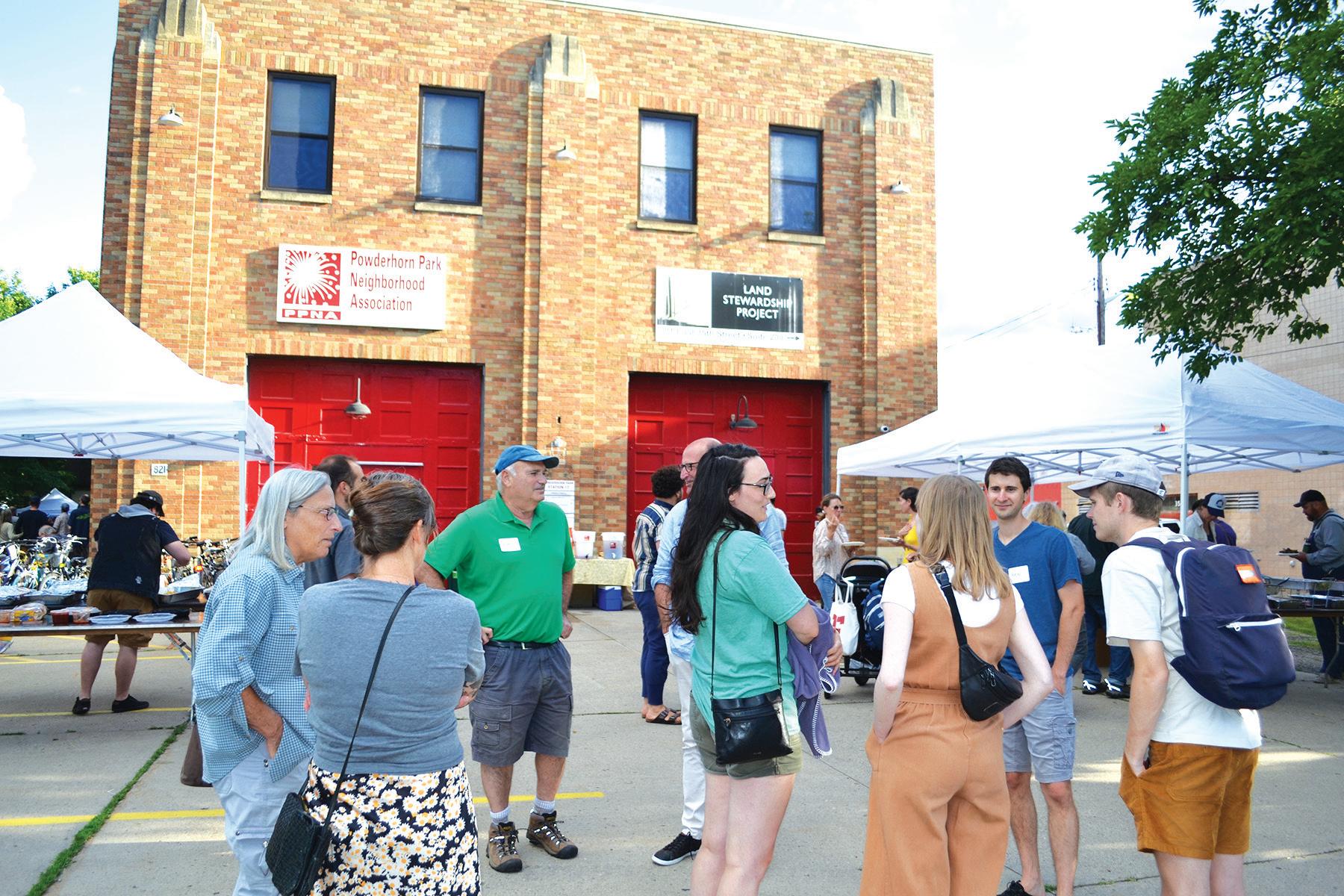

potluck, attendees enjoyed catered food provided by three treasured local restau rants: Sioux Chef Catering, Union Hmong Kitchen, and Smoke in the Pit barbecue. Additionally, all of Elliot Avenue was shut down between 35th Street and 36th Street to accommodate a larger-than-normal crowd.
The goals of this year’s event were slightly different as well. Planners hoped to achieve an event that felt welcoming not just to LSP members and supporters, but also to the greater community of Powderhorn and Central neighborhoods surrounding the Minneapolis office. As LSP looks back on our past 40 years of organizing, and ahead
to the future, block party organizers worked towards a theme of urban-rural solidarity. This year’s program brought that theme forward by bringing together community organizers Melia Haugen Ahrens and Jay Webb as featured speakers. Ahrens, a vet eran LSP member and organizer based in Winona, has been a leader in the campaign to prevent a mega-dairy from expanding in southeastern Minnesota’s vulnerable karst country. Since becoming involved in LSP organizing, Ahrens has marveled at the power of “regular people” to transform their community.
Similarly, Webb organizes in his own community of south Minneapolis for en vironmental justice as the lead gardener at George Floyd Square. Block party organiz ers learned of his work through a chain of connections, starting with longtime picnic performers, the Brass Messengers. Many Brass Messengers musicians play in an activist group, Brass Solidarity, which has been doing weekly performances at George Floyd Square for the past two years. Mem bers of Brass Solidarity recommended we reach out to Jay after learning about LSP’s work to create a more sustainable and just food system.
Jay’s message paired perfectly with Melia’s. “The most important thing you can do is show up. Just show up,” he told picnic attendees. That act of showing up has lead Jay on his own journey of learning about soil remediation. He shares what he learns with communities affected by environmental
Picnic, see page 35…
There are
Stewardship Project. LSP has available for purchase 40th

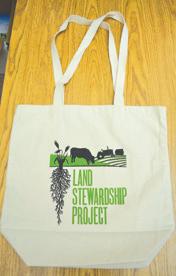
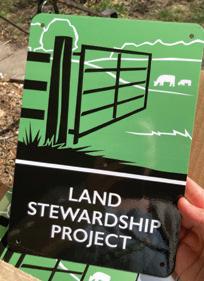

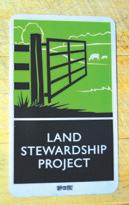

and the classic “Let’s Stop Treating Our
or by calling LSP at 612-722-6377.
…Picnic, from page 34
racism—from the community of activists or ganizing at George Floyd Square, to Lakota tribal members at the Rosebud Indian Res ervation. And soon, on a tour of countries in West Africa.
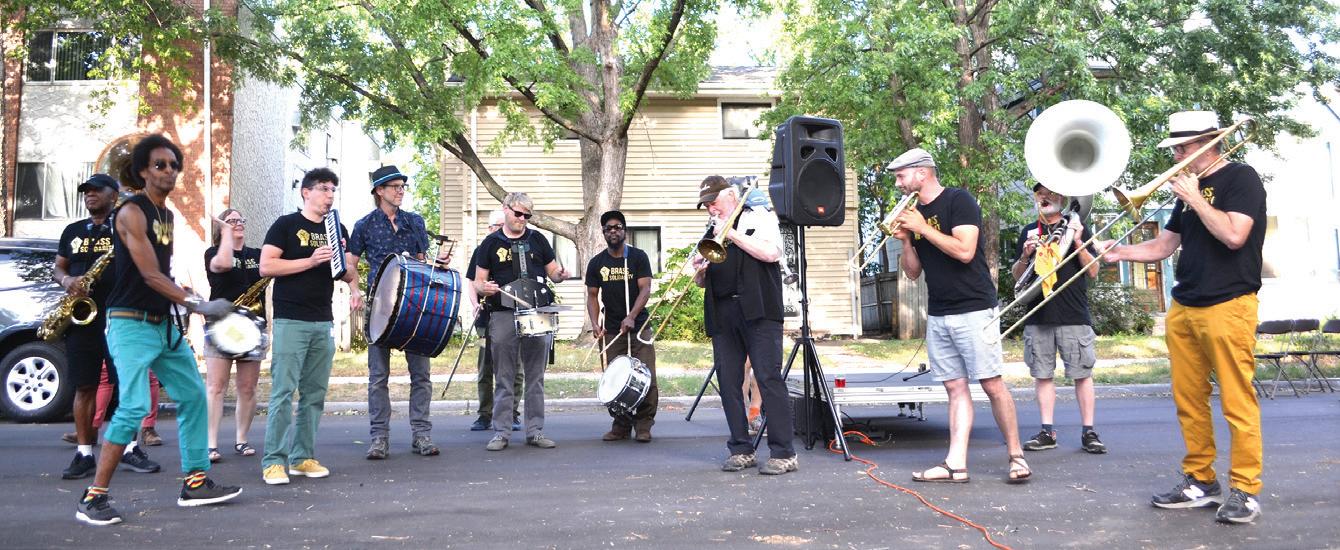
This year’s speakers remind us that organizing is stronger when we cross-pollinate. The organizing of LSP members in southeastern Minnesota fight ing the expansion of factory farms relates to communities fighting racism in urban areas. When “regular people” step into their power as organiz ers, our communities have a chance at a healthier, more sustainable, more just, future.
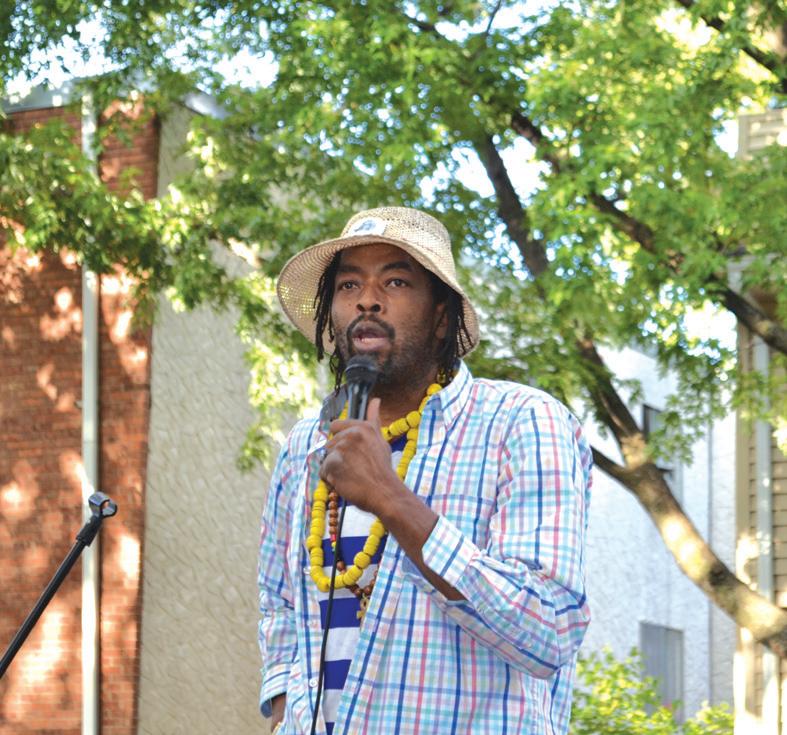
LSP member Mary Dobish sent a hopeful reflection after the event: “I think the connec tions between land stewardship and our city neighborhoods is so important—and it makes our work so much more interesting and meaningful.”
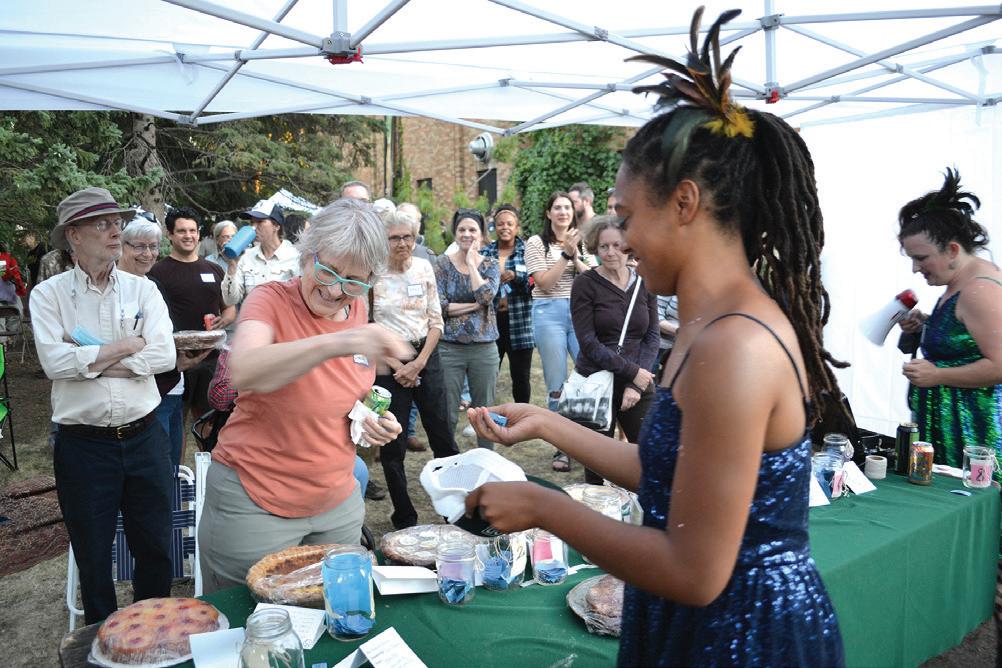
A huge “thank you” to all the members who made it out to this year’s Twin Cities gathering. And if you missed it, we’ll be bringing the potluck back next year! p
Elizabeth Makarewicz is a membership support specialist for LSP.
We set a number of summer gathering records during the 2022 Land Stewardship Project Picnic and Block Party:
4 At least 312 people attended the event this year.
4 Around 16% of those attendees were brand new to LSP. This is an exciting new pool of people to engage in our work.
4 LSP members and supporters donated 17 pies to our pie raffle.
4 Nearly $10,000 was raised towards our work to create a more sustainable and just food system.
If you have questions about your Land Stewardship Project membership, contact Clara Sanders at 612-400-6340 or csanders@ landstewardshipproject.org To renew, mail in the envelope included in this Land Steward ship Letter, or see landstewardshipproject. org/join.
H as your address changed or do you antici pate moving in the next few months? Take a moment to update your address with LSP so that you can continue receiving the Land Stewardship Letter, event invitations, and other updates. To update your address, see landstewardshipproject. org/address. Make sure you use the same e-mail address you have on file with LSP so your data updates correctly.
The Land Stewardship Project is grateful to have received the following gifts made to honor and remember loved ones and friends:
In Honor of Nicholas Schultz’s Birthday
u Jessica Raymond
In Honor of Sally Levy
u Ben Jacobson
In Memory of Lawrence Wendell Peterson
u Jean Greenwood
In Memory of Gary Gibson
u Susan Schmidt
u Dale Hadler
u Charles Hansens
To donate to LSP in the name of someone, contact Clara Sanders at 612-400-6340 or csanders@ landstewardshipproject.org. Donations can be made online at landstewardshipproject.org/join.
“The most important thing you can do is show up. Just show up.” (LSP Photo)
➔ DEC. 10 — LSP Soil Microbiology Workshop with Elaine Ingham, Winona, Minn. Contact: landstewardshipproject.org/ upcoming-events; Shona Langseth, slangseth@landstewardshipproject.org
➔ DEC. 13 — Minnesota Legislative Landscape 101, virtual online. Contact: landstewardshipproject.org/upcoming-events
➔ DEC. 13 — USDA RMA Workshop on Whole Farm Revenue Protection & Micro Farm Insurance Options , virtual online. Contact: rma.usda.gov/Topics/Outreach-andEducation/RMA-Roadshow
➔ WINTER — LSP Soil Health, Land Transition & Conservation Lease Workshops. Contact: landstewardshipproject. org/upcoming-events
➔ JAN. 3 — 2023 Session of the Minnesota Legislature Convenes (see page 10)
➔ JAN. 5-6 — Minnesota Organic Conference, St. Cloud, Minn. Contact: Cassie Dahl, MDA, 651-201-6134, cassie.dahl@ state.mn.us; mda.state.mn.us/organic
➔ MID-JANUARY— LSP 40th Anniversary Presentation by Robin Wall Kimmerer, author of Braiding Sweetgrass (see page 32)
➔ JAN. 20-21 — Practical Farmers of Iowa Annual Conference, Ames, Iowa. Contact: practicalfarmers.org
➔ JAN. 24 — LSP Monthly Policy Organizing Meeting, virtual online, 7 p.m.8:15 p.m., bit.ly/LSPpolicymeetings
➔ JAN. 26-28 — Northern Plains
Sustainable Ag Society Food & Farming Conference, Fargo, N. Dak. Contact: npsas. org, 605-301-0460
➔ FEB. 2-4 — GrassWorks Grazing Conference, Wisconsin Dells, Wis. Contact: grassworks.org/events/grazing-conference
➔ FEB. 11 — Sustainable Farming
Association Annual Conference, St. Joseph, Minn. Contact: sfa-mn.org; 844-922-5573
➔ FEB. 23-25 — Marbleseed Organic Farming Conference, La Crosse, Wis. Contact: marbleseed.org/events/ organic-farming-conference
➔ AUG. 1 — Early Bird Discount Registration Deadline for 2023-2024 LSP Farm Beginnings Class (see page 15)
➔ SEPT. 1 — Final Registration Deadline for 2023-2024 LSP Farm Beginnings Class (see page 15)
➔ SEPT. 30 — Current Farm Bill Expires (see page 8)
➔ SPRING — LSP’s 2023 Field Day Season Begins (see pages 24-31). Contact: landstewardshipproject.org/upcoming-events
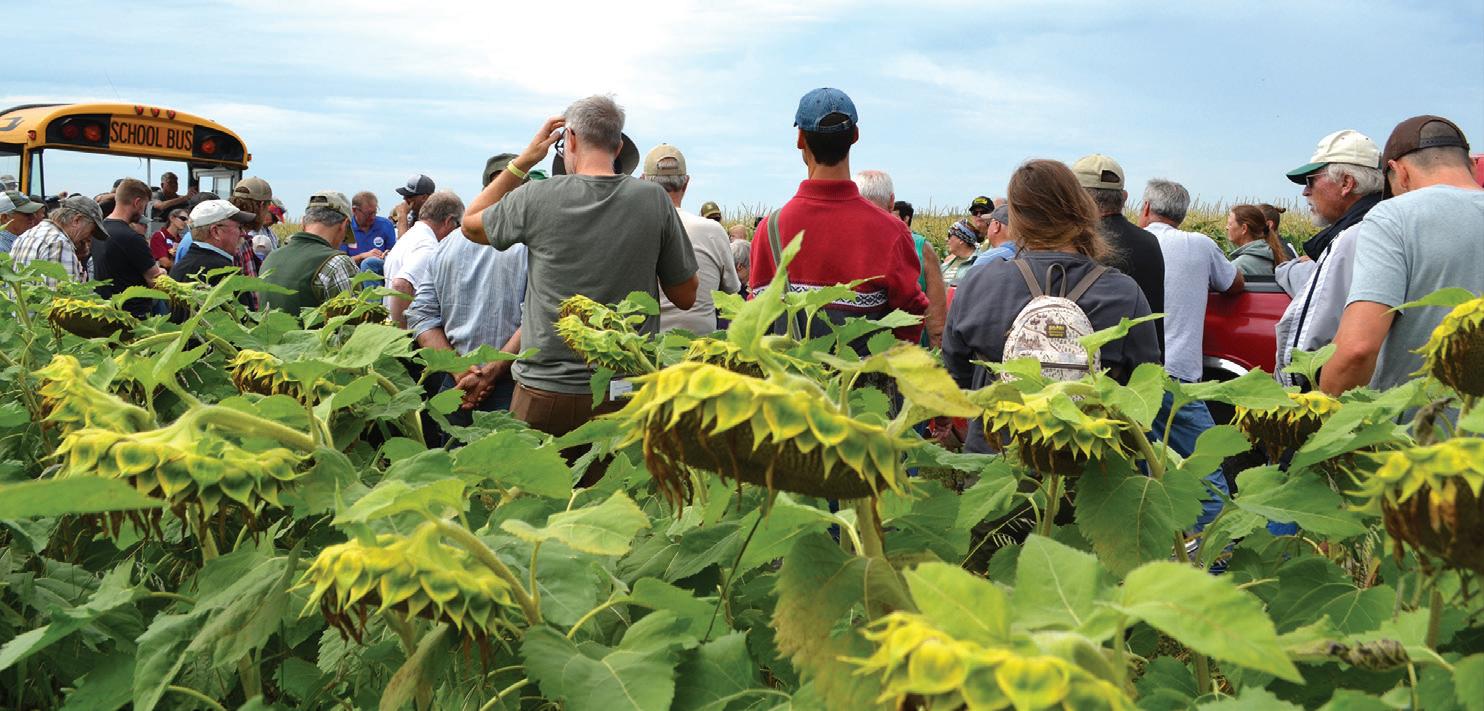
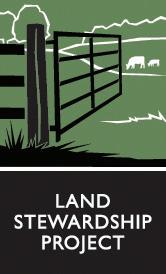
In recognition of the Land Stewardship Project’s 40th Anniversary, please consider a special gift to LSP’s Future Impact Fund, which supports strategic, high-impact initiatives not fully funded by grants.
Contributions to this fund will allow LSP to support beginning farmers who are seeking to access affordable land, fight back against corpo rate agribusiness, deepen our racial justice work, organize for healthcare reform, and grow the number of people involved in our work.
To make a gift, you can send it in addi tion to your regular renewal to 821 E. 35th St., Minneapolis, MN, 55407. You can also make your gift at bit.ly/FutureLSP. For more informa tion, contact Josh Journey Heinz, LSP’s major gifts and membership officer, at jjourney-heinz@ landstewardshipproject.org or 612-400-6347